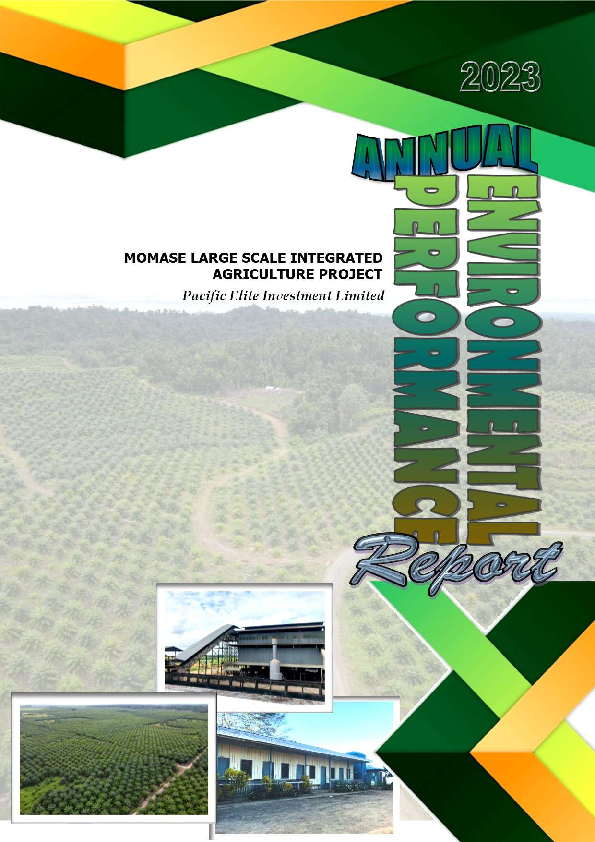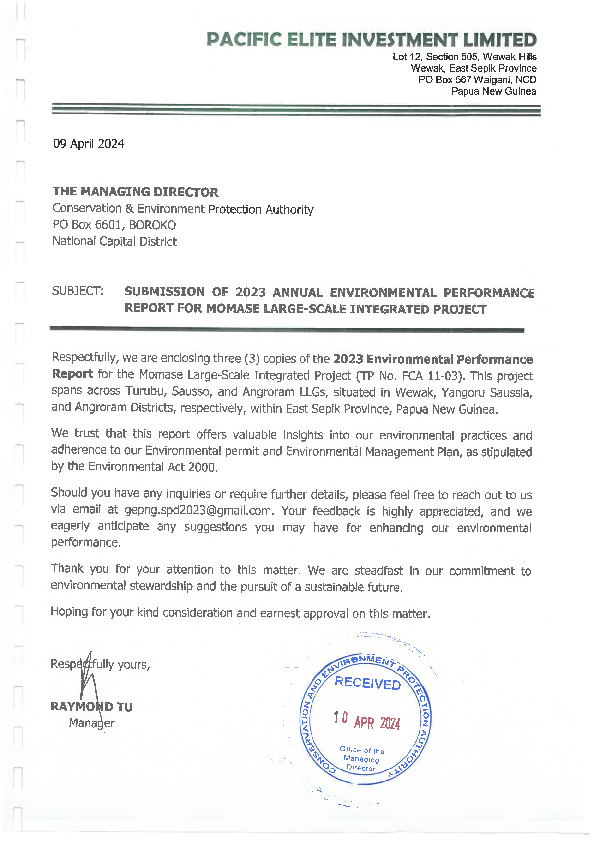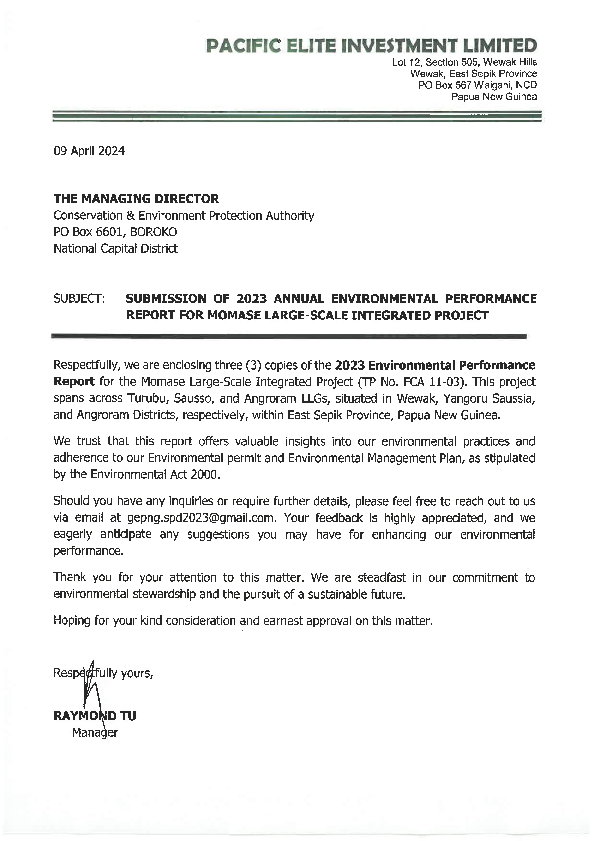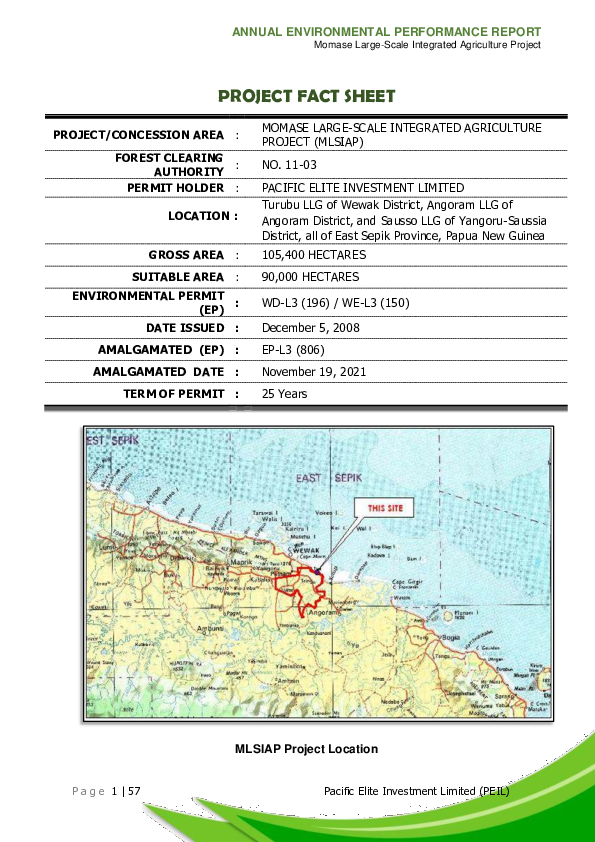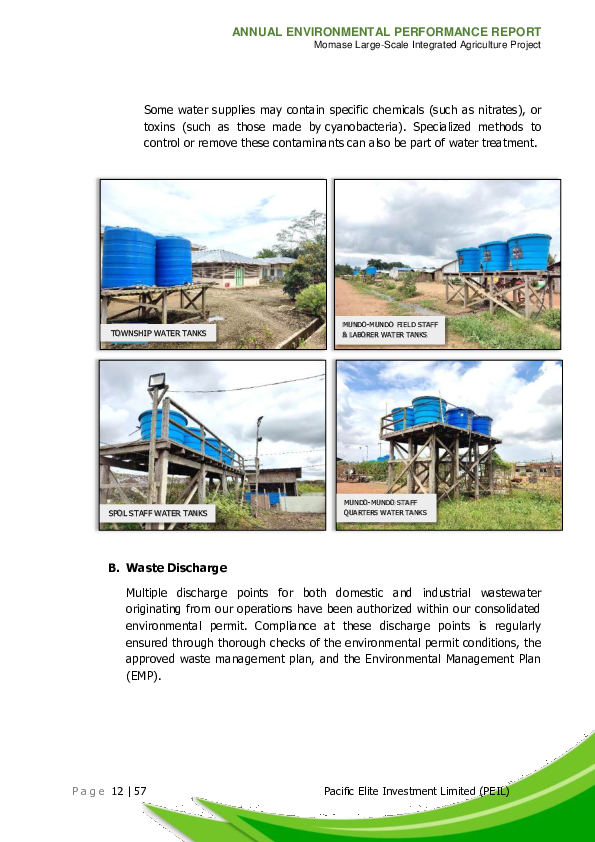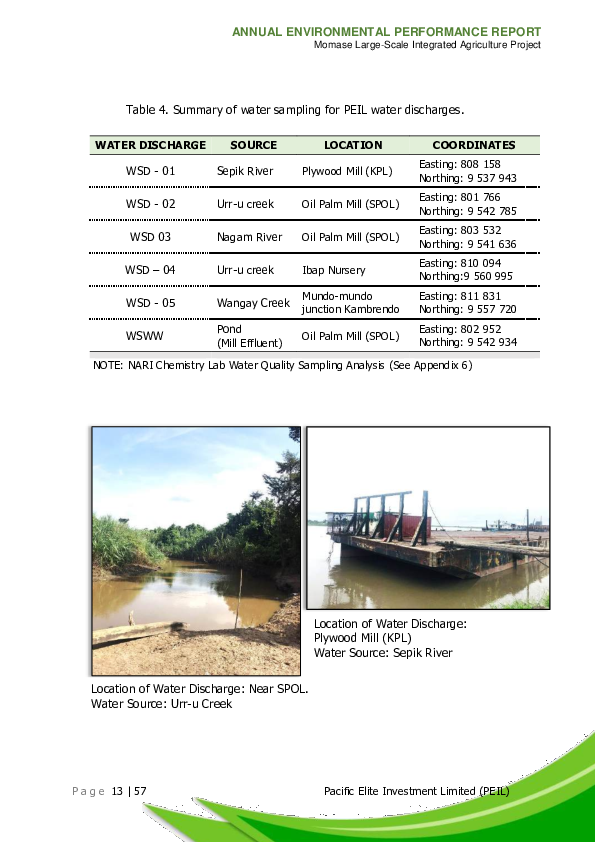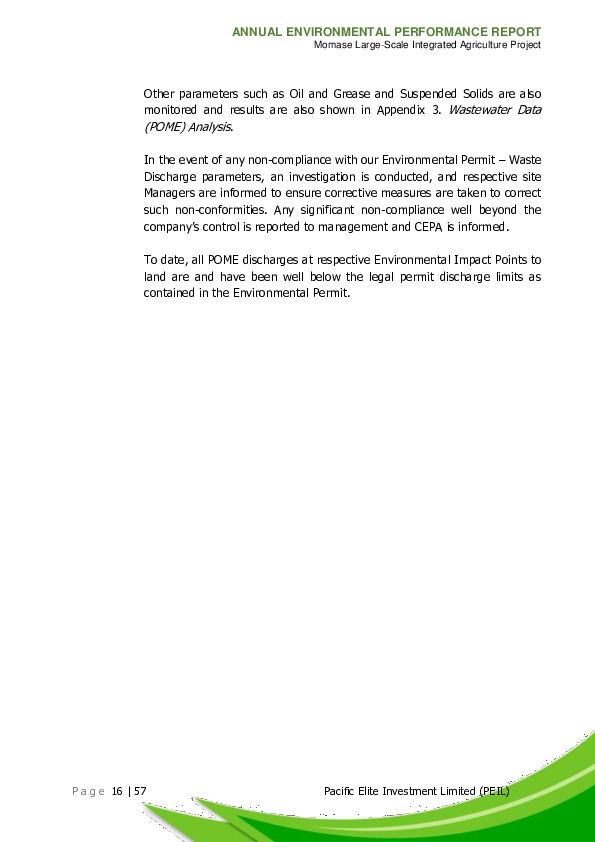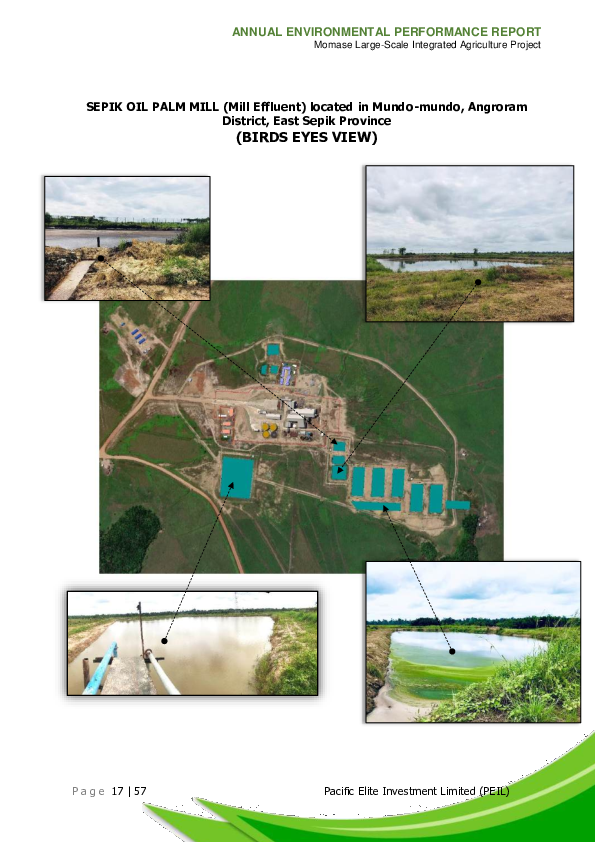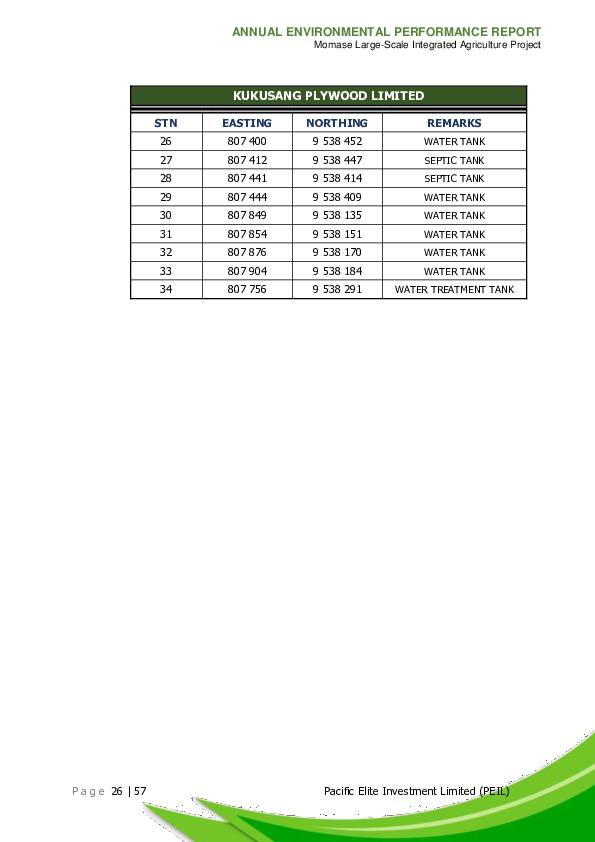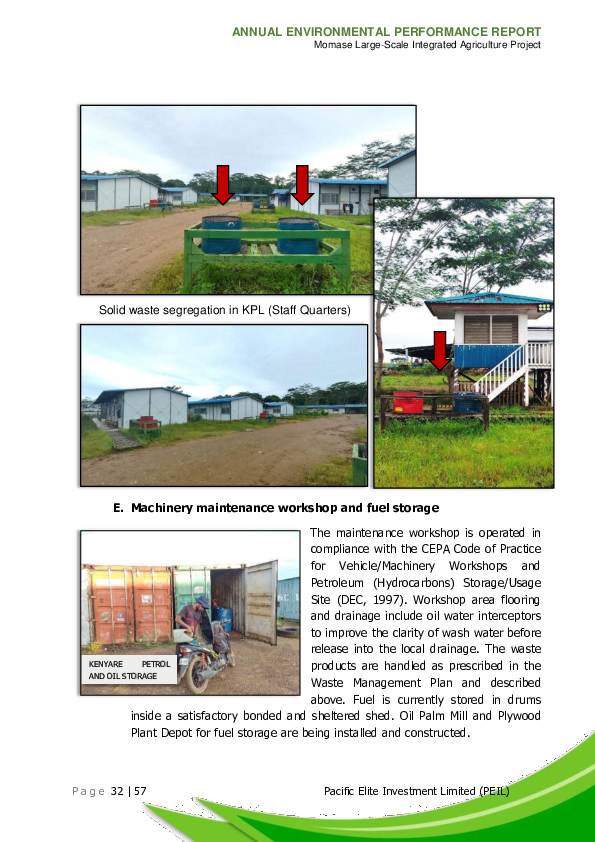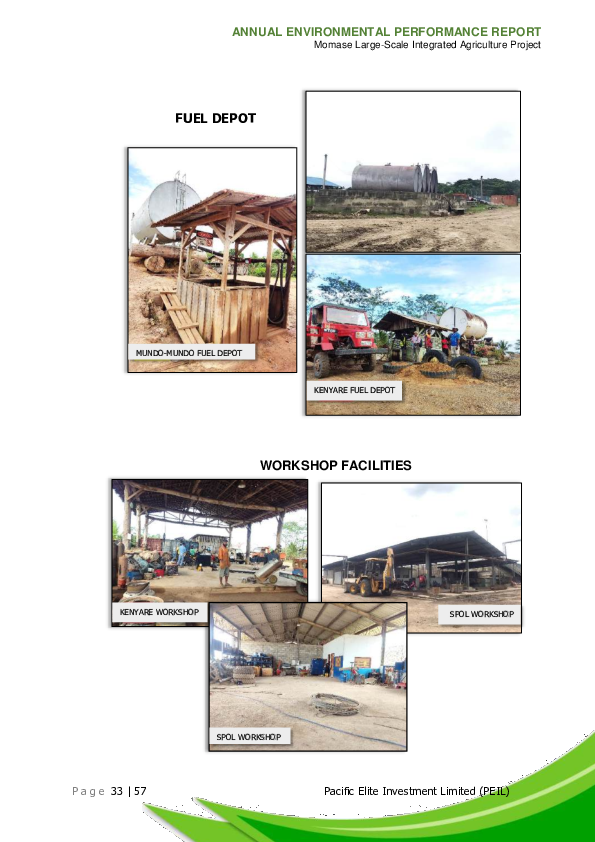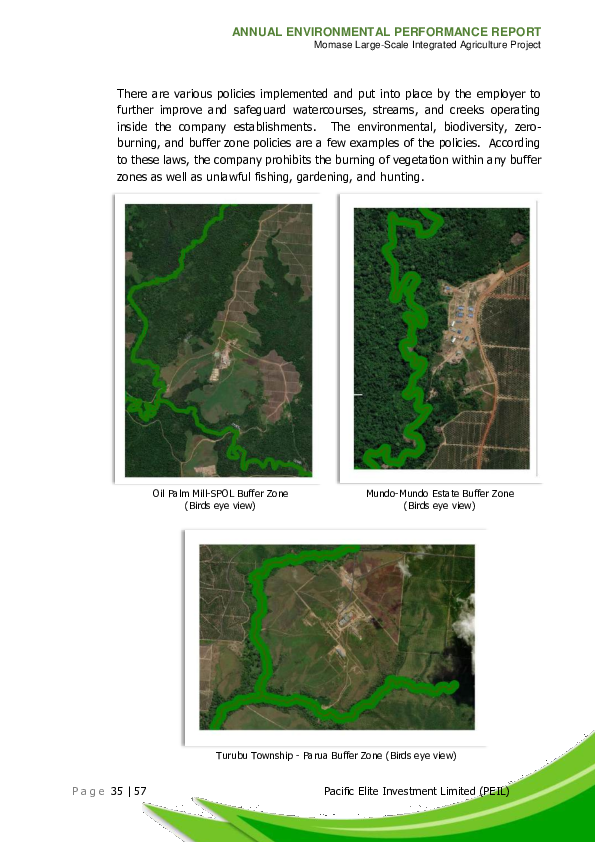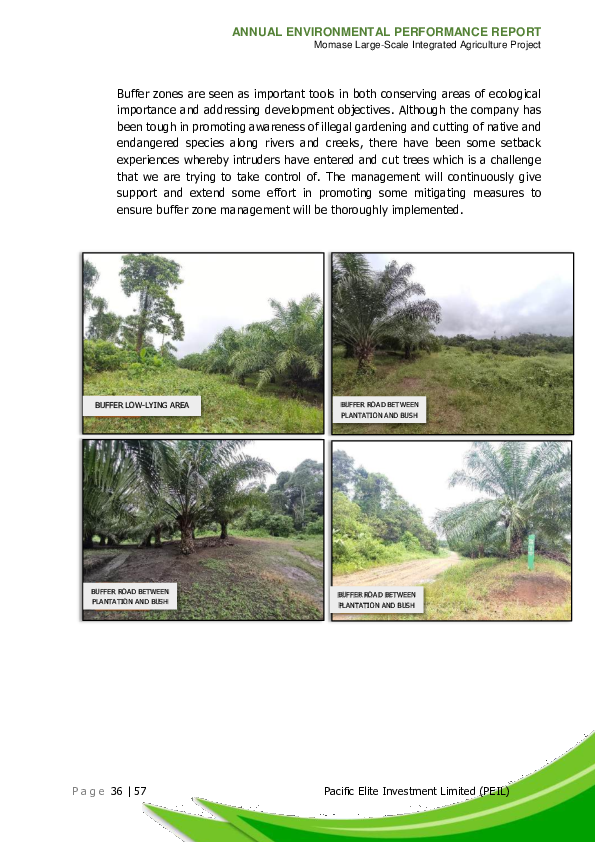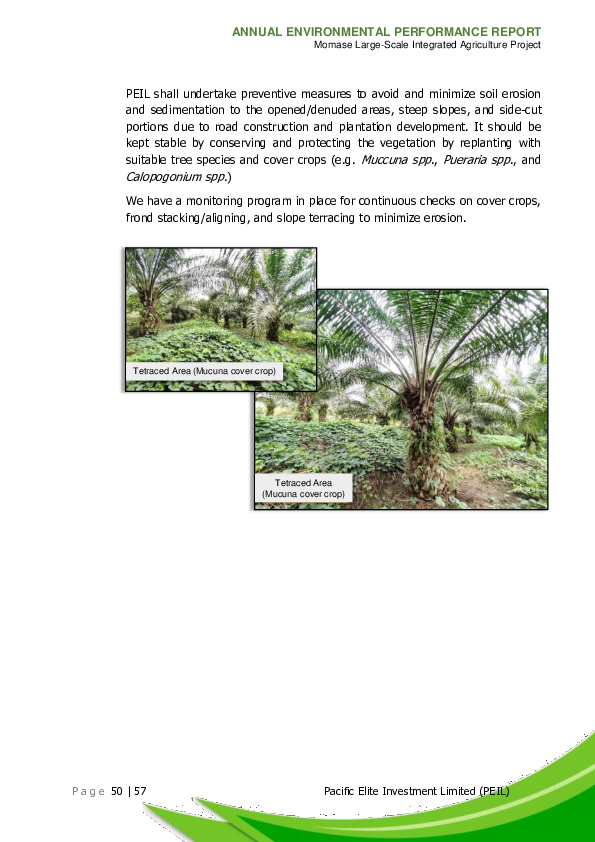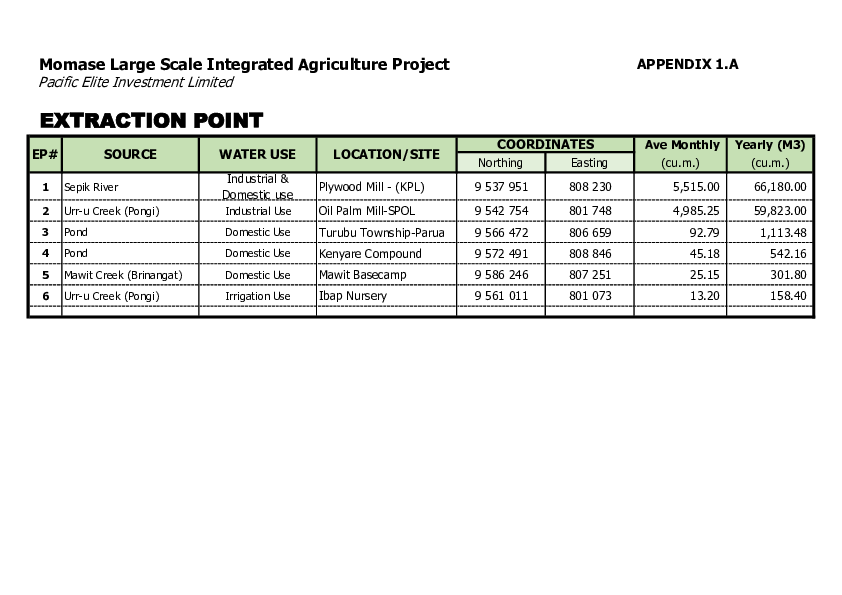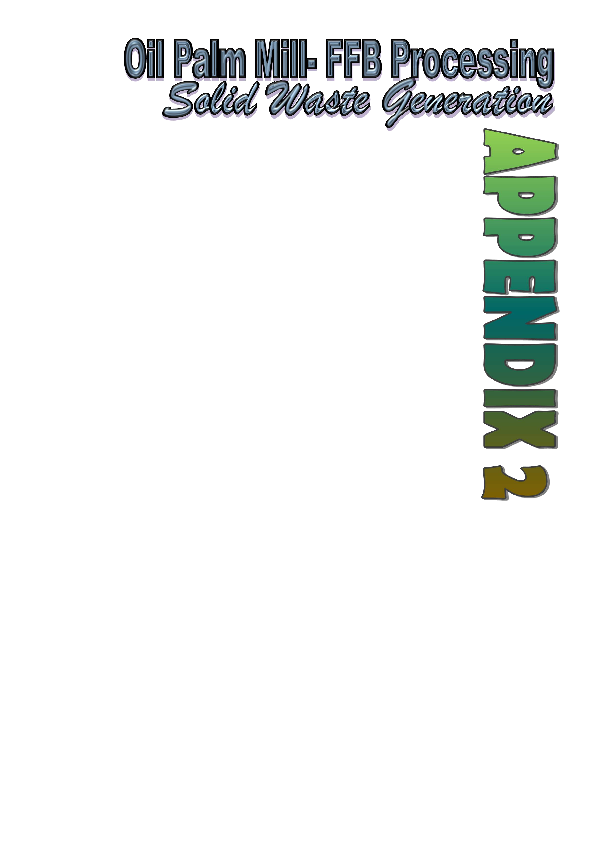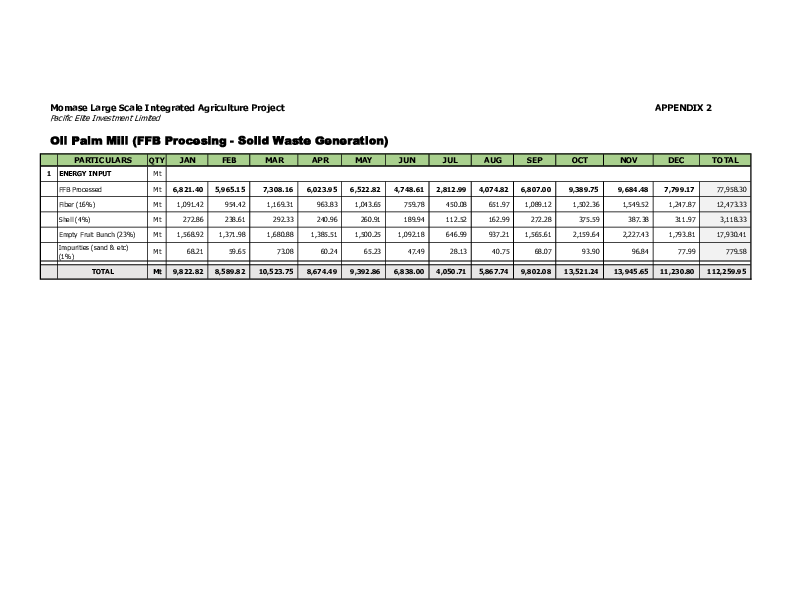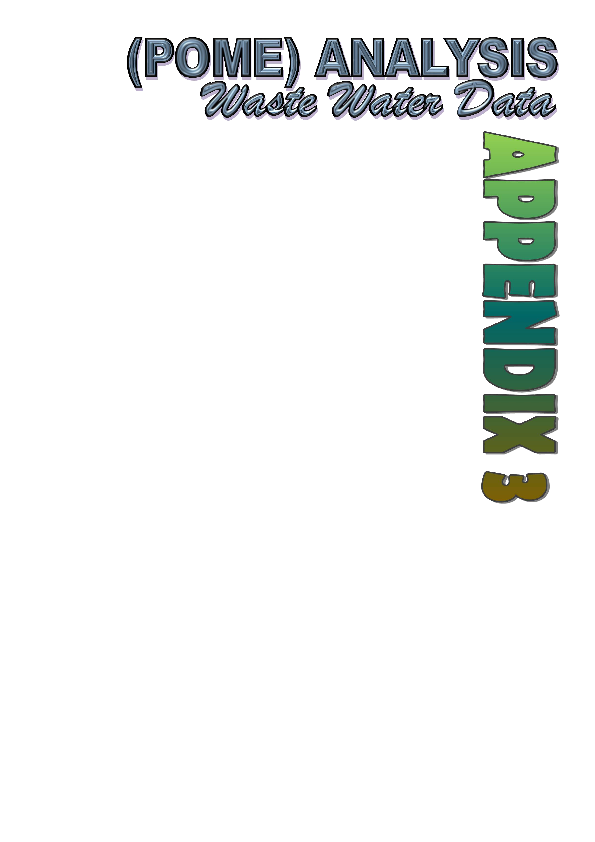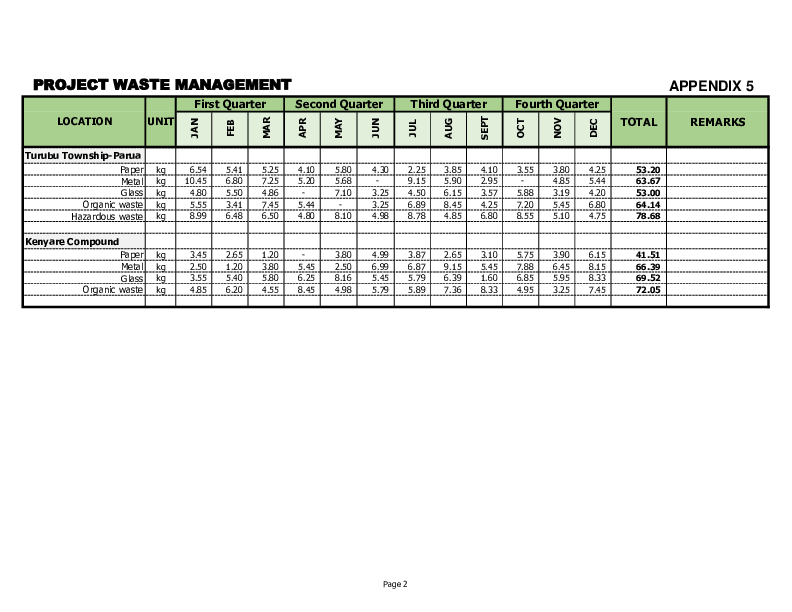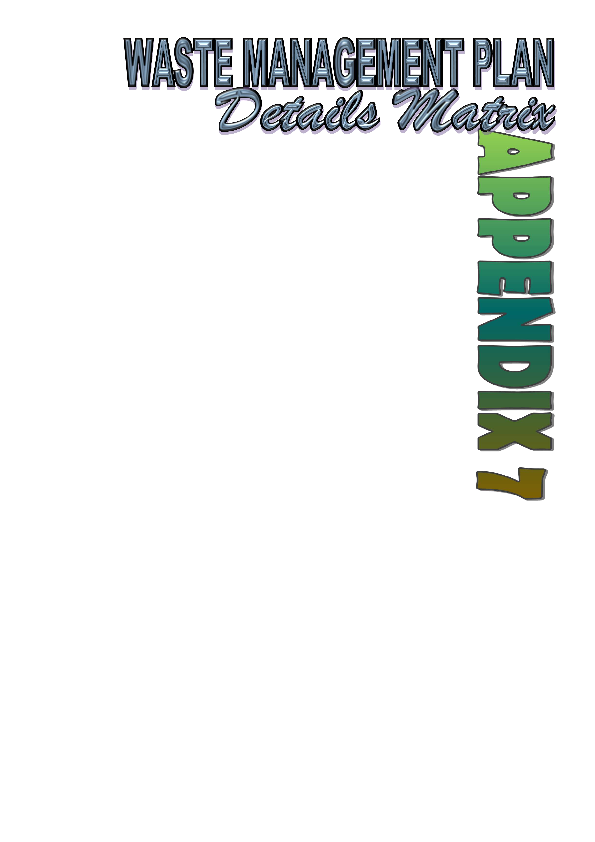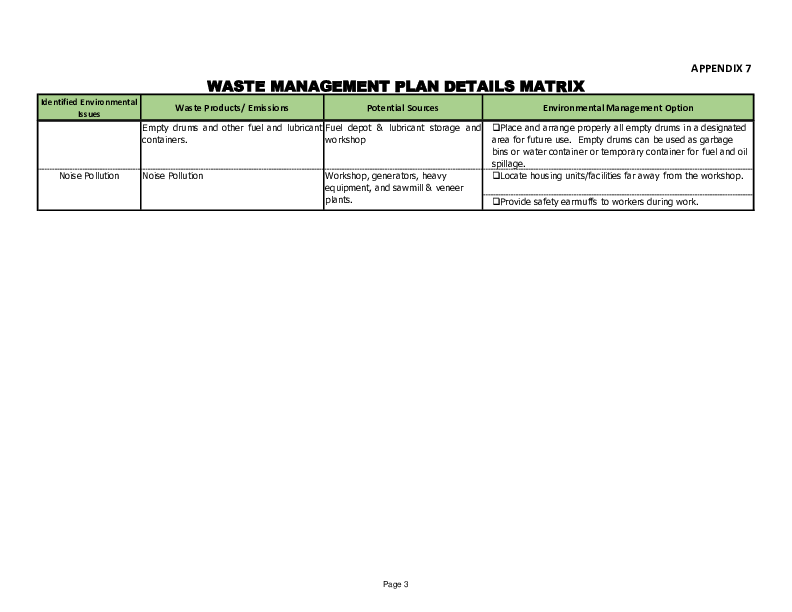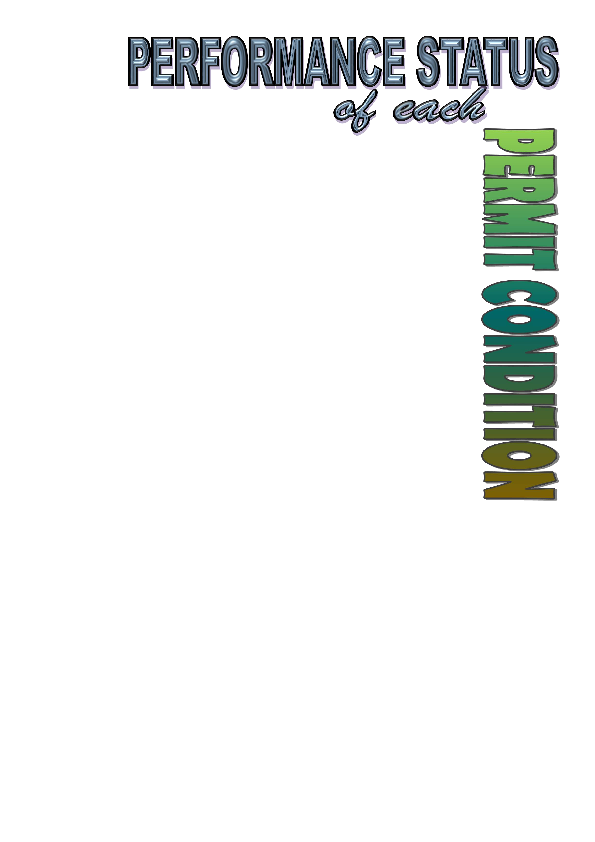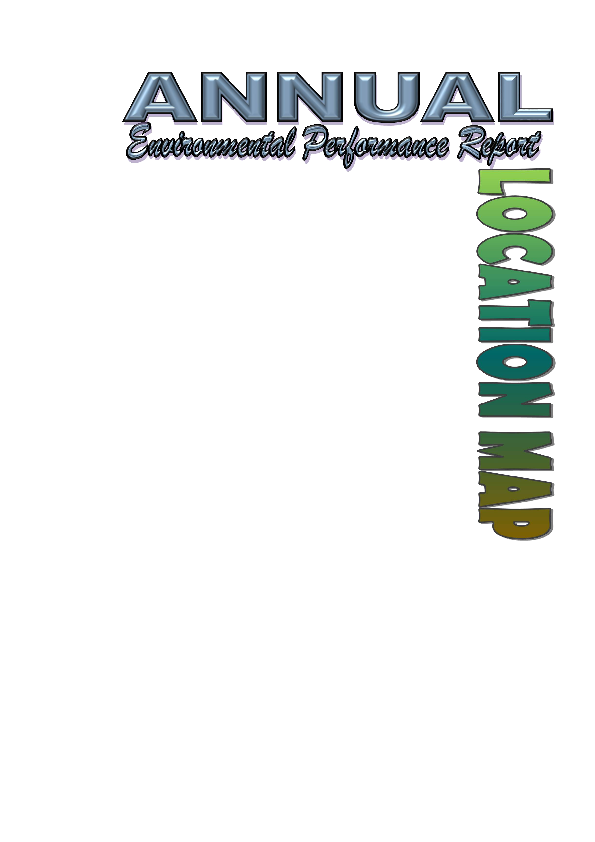Page/s
PROJECT FACT SHEET ............................................................... 1
INTRODUCTION ....................................................................... 2-3
PROJECT OBJECTIVES .............................................................. 4
I. ENVIRONMENTAL PERFORMANCE ......................................... 5 - 33
A. Water Extraction
B. Waste Discharge
C. Energy Usage
D. Solid Wastes
E. Machinery maintenance workshop and fuel storage
II. ENVIRONMENTAL MANAGEMENT INITIATIVES ..................... 34 - 50
A. Buffer Zone Management
B. Conservation Area Management
C. Water Management Plan
D. Waste Management Plan
E. Agrochemicals Management
F. Erosion Control Management Plan
III. CONCLUSION .................................................................... 51
IV. WASTE MANAGEMENT PROGRAM ........................................... 51 - 56
A. Waste Management Program Component
B. Waste Management for the specific Environmental Issues
C. Methods of Waste Disposal and Treatment
D. Emergency Action Measures
E. Personnel and Staff Support
V. COMMITMENTS ...................................................................... 57
�
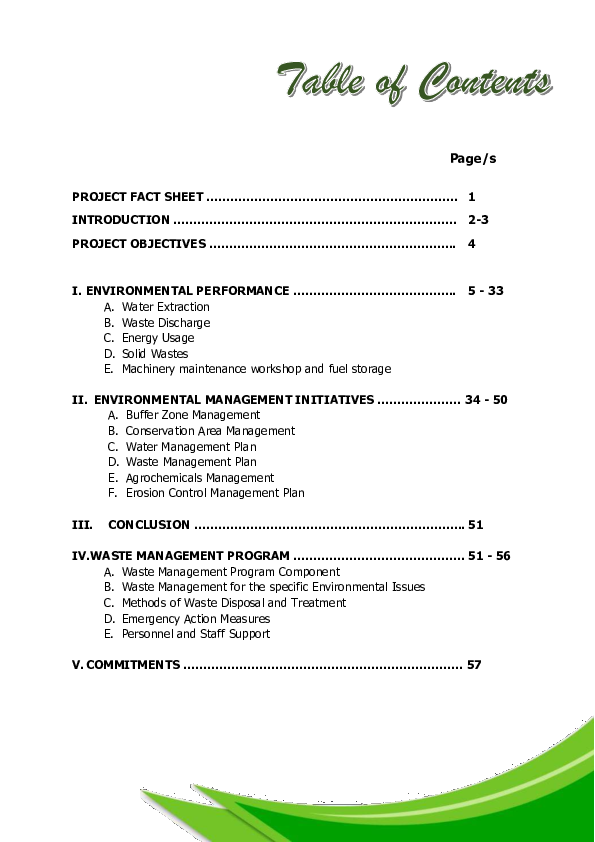
TABLE
Table 1. Summary of Water sampling extraction under PEIL for the year 2023.
Table 2. Summary of Water Sampling for Domestic Use.
Table 3. Water Quality Criteria – Non – Disinfected Water Supplies.
Table 4. Summary of water sampling for PEIL water discharges.
Table 5. Effluent Quality Criteria for Treated Palm Oil Mill Effluent (POME) Discharge
Table 6. List of water tanks and septic tanks locations and coordinates within
PEIL.
Table 7: Buffer Zones Establishment.
Table 8: Slope Gradients and Elevation.
Table 9. PEIL list of disposal sites.
APPENDIXES
Appendix 1: Extraction and Discharge Point
Appendix 2: Oil Palm Mill- FFB Processing (Solid Waste Management)
Appendix 3: Waste Water Data (POME) Analysis
Appendix 4: Energy Generation
Appendix 5: Project Waste Management
Appendix 6: Water Quality Sampling Analysis Result
Appendix 7: Waste Management Plan Details Matrix
Appendix 8: Nature of Specific Waste Products Matrix
Appendix 9: Waste Management Program
Performance Status of each Permit Condition
Annual Environmental Performance Report Map
�

ANNUAL ENVIRONMENTAL PERFORMANCE REPORT
Momase Large-Scale Integrated Agriculture Project
PROJECT FACT SHEET
MOMASE LARGE-SCALE INTEGRATED AGRICULTURE
PROJECT/CONCESSION AREA :
PROJECT (MLSIAP)
FOREST CLEARING
: NO. 11-03
AUTHORITY
PERMIT HOLDER : PACIFIC ELITE INVESTMENT LIMITED
Turubu LLG of Wewak District, Angoram LLG of
LOCATION : Angoram District, and Sausso LLG of Yangoru-Saussia
District, all of East Sepik Province, Papua New Guinea
GROSS AREA : 105,400 HECTARES
SUITABLE AREA : 90,000 HECTARES
ENVIRONMENTAL PERMIT
: WD-L3 (196) / WE-L3 (150)
(EP)
DATE ISSUED : December 5, 2008
AMALGAMATED (EP) : EP-L3 (806)
AMALGAMATED DATE : November 19, 2021
TERM OF PERMIT : 25 Years
MLSIAP Project Location
P a g e 1 | 57 Pacific Elite Investment Limited (PEIL)
�
ANNUAL ENVIRONMENTAL PERFORMANCE REPORT
Momase Large-Scale Integrated Agriculture Project
INTRODUCTION
In the heart of Papua New Guinea's East Sepik Province lies a vast area of land teeming
with potential – the Momase Large Scale Integrated Agriculture Project
(MLSIAP). Nestled approximately 25 kilometers from the bustling town of Wewak, this
ambitious initiative is poised to reshape the agricultural landscape of the region.
Spanning over 105,400 hectares of diverse terrain, the project site encompasses lush
forests, sprawling grasslands, and fertile soils waiting to be cultivated. But this isn't just
about exploiting the land for profit; it's a carefully orchestrated endeavor that harmonizes
development with environmental conservation.
At its core, the Momase Large Scale Integrated Agriculture Project revolves around the
cultivation of oil palm, a lucrative crop with myriad industrial applications. Over 90,000
hectares of the project area have been earmarked for the establishment of expansive oil
palm plantations, a testament to the scale of ambition driving this endeavor.
Yet, what sets the MLSIA project apart is its holistic approach to development.
Recognizing the intricate interplay between economic prosperity and ecological
sustainability, the project aims to strike a delicate balance between agricultural expansion
and forest preservation.
However, achieving such equilibrium requires meticulous planning and vigilant
monitoring. Thus, as the project unfolds, a commitment to transparency and
accountability is paramount. Hence, the Annual Environmental Performance Report
for 2023 serves as a testament to the project's unwavering dedication to environmental
stewardship.
P a g e 2 | 57 Pacific Elite Investment Limited (PEIL)
�
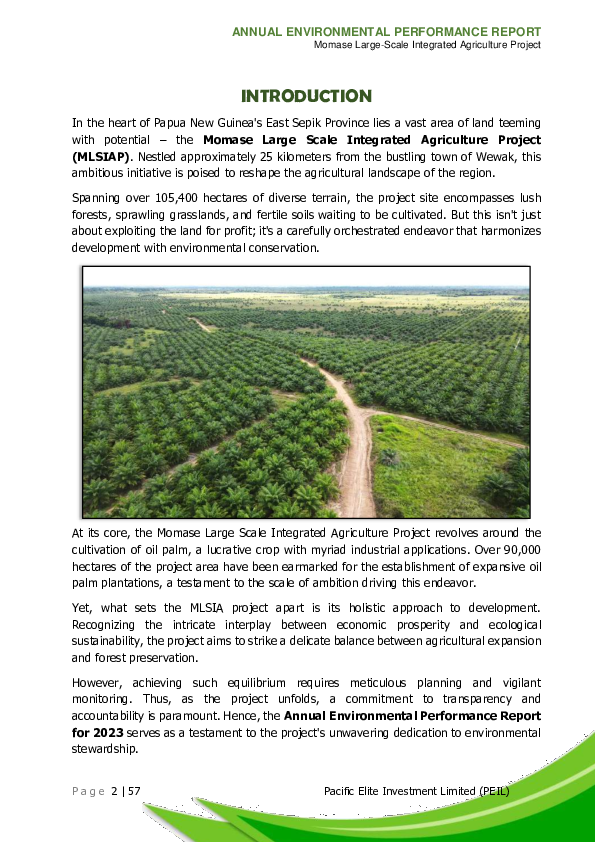
ANNUAL ENVIRONMENTAL PERFORMANCE REPORT
Momase Large-Scale Integrated Agriculture Project
Within the pages of this report lie insights into the project's progress, challenges
encountered, and measures taken to mitigate environmental impact. It serves not only
as a regulatory requirement but also as a testament to the project's ethos – a testament
to the conviction that progress need not come at the expense of nature.
Furthermore, like any developmental
undertaking, waste products are
expected to be produced during
implementation and operation. The
project site in particular and the
surrounding area as a whole would
experience significant and irreversible
environmental deterioration if these
wastes are not handled and managed
properly. The majority of the wastes
generated by the mill and plant sites will
end up in the adjacent tributaries of the
Sepik River, a vital economic resource
for the East Sepik Province, if they are not properly and thoroughly managed. Without
appropriate sustainable waste management and disposal procedures, it will have a
significant impact on the quality of the air, land, and water, and these wastes may also
pose risks to the health and safety of those in the project area as well as those outside
of it.
Pacific Elite Investment Limited (PEIL) remains committed to its legal obligations
under the Environment Act 2000 to the annual reporting process and will continue to
provide key environmental monitoring, measurement information, and data to key
stakeholders on an annual basis. PEIL strives to maintain a high level of environmental
management for the longer-term sustainability and profitability of the business and the
environment in which it operates.
To comply with the environmental permit approval conditions issued to the PEIL under
the Environment Act 2000, this environmental performance report has been prepared in
compliance with the legal requirements. It is formatted under the guidelines established
by the Conservation and Environment Protection Authority (CEPA) for Annual Environment
Performance Reporting.
This report details the company's overall performance from January 1st to December 31st,
2023, with an emphasis on achieving sustainably managed oil palm plantations. This
includes the production of crude palm oil, tree salvaging, and timber processing
operations, all of which integrate the concepts of sustainable development into our regular
business operations.
P a g e 3 | 57 Pacific Elite Investment Limited (PEIL)
�
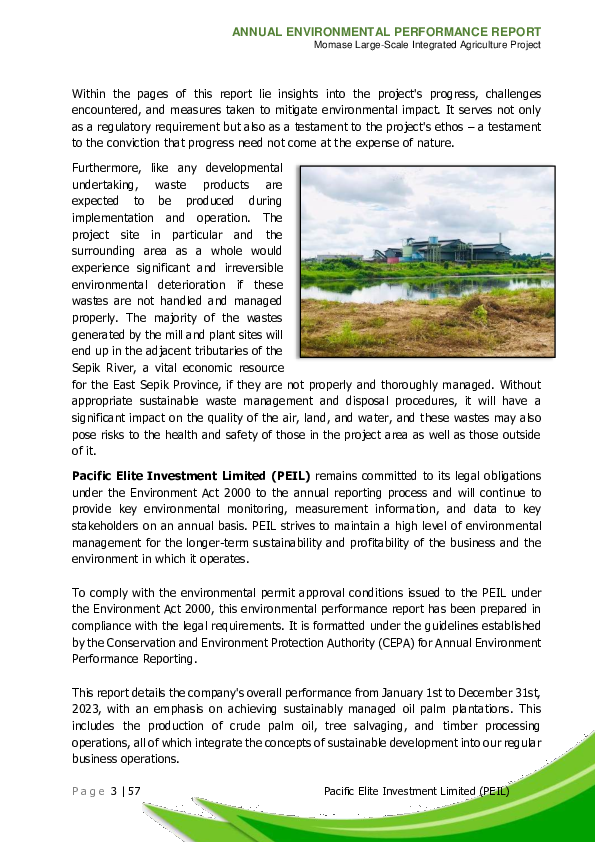
ANNUAL ENVIRONMENTAL PERFORMANCE REPORT
Momase Large-Scale Integrated Agriculture Project
Our foremost priority revolves around consistently enhancing our environmental
performance. This commitment stems from our overarching business goals, striving to
attain predefined targets, and adhering to legal mandates and regulations, including
various environmental permit stipulations. We aim to operate our business in a manner
that is both efficient and environmentally sustainable over the long haul.
PROJECT OBJECTIVES
The objectives of the report are to:
Evaluate the environmental impact of agricultural activities conducted under the
project, including land use changes, water usage, soil health, biodiversity, and air
quality,
Ensure compliance with environmental regulations and standards set forth by
CEPA-issued environment permit approval conditions and the CEPA-approved EMP
(Legal Compliance),
Identify emerging environmental risks and challenges associated with project
activities and propose mitigation measures to address them,
Track key environmental indicators such as water quality, soil erosion,
deforestation, water waste discharge, waste disposal, and wildlife populations to
gauge the project's impact on the environment,
Assess the effectiveness of environmental management practices implemented
within the project to minimize negative environmental impacts and promote
sustainability,
Integrate environmental considerations into long-term project planning to ensure
the sustainability of agricultural practices and environmental resources for future
generations, and
Pacific Elite Investment Limited’s overall environmental performance concerning
other environmental initiatives shall be thoroughly undertaken by the company.
By fulfilling these objectives, the annual environmental performance report can provide
valuable insights into the environmental impact of the Momase Large Scale Integrated
Agriculture Project and support informed decision-making to promote environmental
sustainability and resilience.
P a g e 4 | 57 Pacific Elite Investment Limited (PEIL)
�
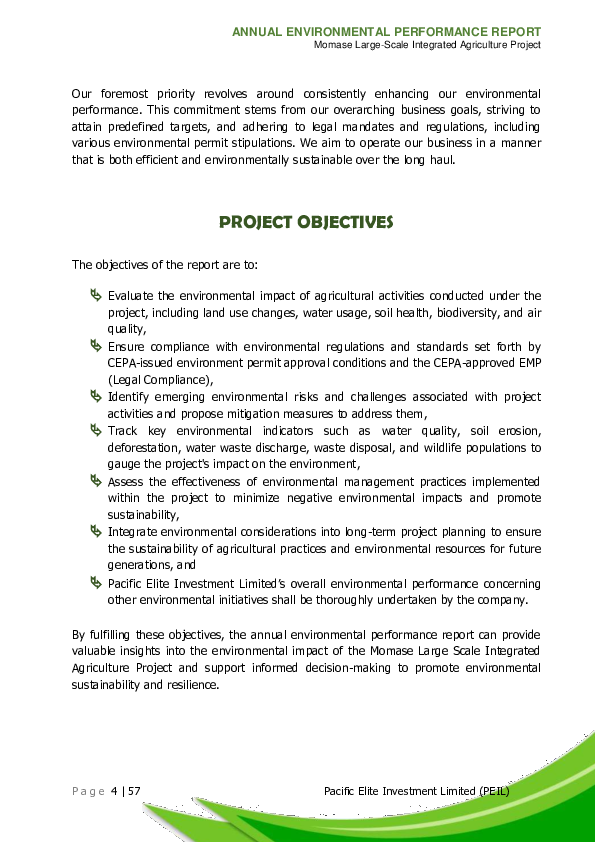
ANNUAL ENVIRONMENTAL PERFORMANCE REPORT
Momase Large-Scale Integrated Agriculture Project
I. ENVIRONMENTAL PERFORMANCE
The Momase Large-Scale Integrated Agriculture Project, implemented under the
support of Pacific Elite Investment Limited (PEIL), stands as a beacon of innovation
and initiated a wider scope of sustainable agro-industrial development, embodies
PEIL's commitment to harnessing agricultural potential while ensuring
environmental responsibility. Situated amidst the lush landscapes of the East Sepik
Province, the project aims to integrate modern agricultural techniques with
traditional wisdom, fostering economic growth, security, and environmental
sustainability.
The project has been guided by the principles of environmental conservation and
community engagement. Through strategic partnerships with local stakeholders,
government agencies, and environmental organizations, the project has sought to
strike a delicate balance between agricultural productivity and ecological
preservation.
Throughout the past year, the Project has made significant strides in enhancing
environmental performance across various fronts. From agriculture and tree
planting initiatives to soil conservation efforts, the project has demonstrated a
steadfast commitment to safeguarding natural ecosystems and biodiversity.
P a g e 5 | 57 Pacific Elite Investment Limited (PEIL)
�

ANNUAL ENVIRONMENTAL PERFORMANCE REPORT
Momase Large-Scale Integrated Agriculture Project
Moreover, the MLSIA Project has prioritized community involvement and capacity
building, empowering local farmers with knowledge and skills to adopt sustainable
agricultural practices. By fostering a culture of environmental stewardship and
resilience, the project aims to create lasting benefits for present and future
generations.
As we delve into the Annual Environmental Performance Report for CY 2023, it is
with a sense of pride and responsibility that we reflect upon the achievements and
challenges encountered along the way. Through transparent assessment and open
dialogue, we strive to uphold the highest standards of environmental accountability
and pave the way for a greener, more prosperous future in the region and beyond.
A. Water Extraction
This report details the company's overall performance from January 1st to
December 31st, 2023, with an emphasis on achieving sustainably managed oil
palm plantations. This includes the production of crude palm oil, tree salvaging,
and timber processing operations, all of which integrate the concepts of sustainable
development into our regular business operations.
Last December 5, 2008, the project was
granted Environmental Permits to Discharge
Waste {WD-L3-(196)} and extract water
{(WE-L3 (150)} with approval to commence
on January 2, 2009. Hereafter, the company
applied to amend the Environment Permits
(EPs) to discharge waste and extract waters
which were granted last 19th of November
2021 and under the transformation of the
Department of Environment and Conservation
(DEC) into Conservation and Environment
Protection Authority (CEPA), the
Environmental Permit Number changed to
WATER EXTRACTION POINT
{EP-L3-(806)} which combines the two EPs.
P a g e 6 | 57 Pacific Elite Investment Limited (PEIL)
�

ANNUAL ENVIRONMENTAL PERFORMANCE REPORT
Momase Large-Scale Integrated Agriculture Project
Table 1. Summary of Water sampling extraction under PEIL for the year 2023.
Water Extraction LOCATION &
SOURCE USAGE
Point COORDINATES
WSE - 01 Sepik River Plywood Plant (KPL) Industrial & Domestic
Easting: 808 230
Northing: 9 537 951
WSE - 02 Urr-u Creek (Pongi) Oil Palm Mill-SPOL Industrial & Domestic
Easting: 801 748
Northing: 9 542 754
WSE - 03 Pond Turubu Township Domestic/Workshop
Easting: 806 659
Northing: 9 566 472
WSE - 04 Pond Kenyare Compound Domestic/Workshop
Easting: 808 846
Northing: 9 572 491
WSE – 05 Mawit Creek Mawit basecamp Domestic/Workshop
(Brinangat) Easting: 807 251
Northing: 9 586 246
WSE - 06 Urr-u Creek (Pongi) Ibap Nursery Nursery Irrigation
Easting: 810 073
Northing: 9 561 011
Note: NARI Chemistry Lab Water Quality Sampling Analysis Result (See Appendix 6)
Currently, we comply with our
water extraction limits. It has
also ensured that all
operations are carried out
more sustainably and any
unnecessary water wastage in
both the operations and
accommodation villages is
strictly controlled. There is
also ongoing water
management and control WATER RESERVOIR POND & EXTRACTION POINT
usage awareness undertaken
in all our residential villages. We have maintained and want to keep our annual
water uptake and usage within the allowable legal limits as much as possible.
P a g e 7 | 57 Pacific Elite Investment Limited (PEIL)
�
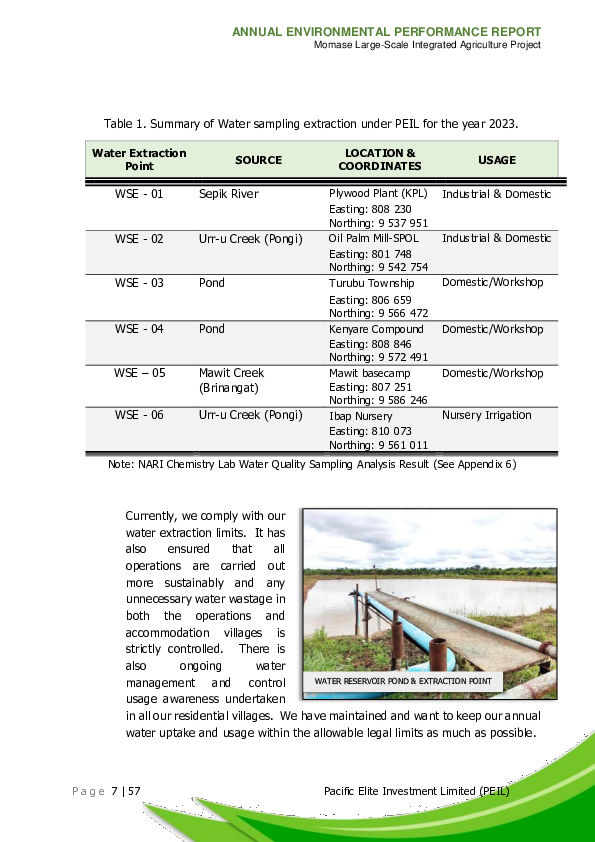
ANNUAL ENVIRONMENTAL PERFORMANCE REPORT
Momase Large-Scale Integrated Agriculture Project
1. Water Quality Monitoring – Drinking Water
The water requirement in the camp for domestic and industrial purposes will
be supplied both through rainwater and surface water from different
creeks/rivers and ponds located nearby. Water abstraction from rivers, creeks,
ponds, and surface water will be conducted with the use of a water pump
(diesel-driven) throughout the year only on an as-needed basis. Because the
Project Area has several high monthly rainfalls, the camp’s water supply needs
will be mainly addressed through the water tanks established to collect
rainwater. Turubu Township, and Mundo-mundo estate rainwater were
collected for domestic use consumption.
During the dry period, water
will be taken from the
constructed reservoir near the
creek, river, and pond and
supplied to the camp through
a water motor pump (diesel-
driven). Water will be stored
in the centralized huge (15m3
- capacity) water tank
mounted in the platform so
that the water will flow freely
to respective faucets using gravitational force. The water pump will
automatically shut off once the desired water level in the tank is attained. In
this way, fuel, and oil consumption of the motor is minimized.
On the other hand, water requirements for the Ibap nursery and palm oil mill
will be supplied from the water abstracted from Urr-u Creek (Pongi). Again, a
centralized huge (20m3 - capacity) water tank will be installed using the same
principle as the one used in the camp during the dry season.
P a g e 8 | 57 Pacific Elite Investment Limited (PEIL)
�
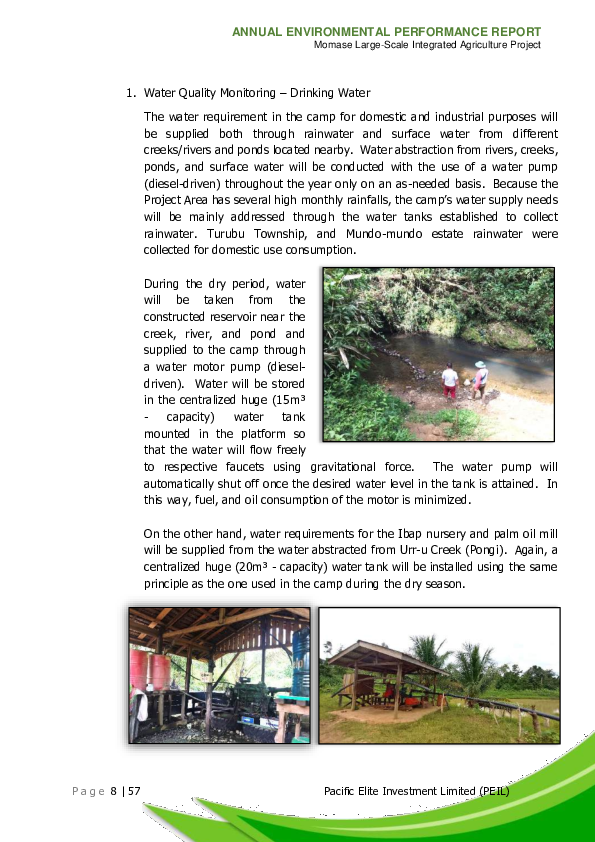
ANNUAL ENVIRONMENTAL PERFORMANCE REPORT
Momase Large-Scale Integrated Agriculture Project
With the increasingly severe pollution of drinking water resources, people's
awareness of the protection of drinking water gradually strengthened, and
management departments increased the intensity of water resource
detection.
Amid the fourth quarter of the previous year, a significant decision rippled
through the corridors of management: the relocation of staff and employees
residing in Mawit Main Camp to Kanduanum. This decision, while abrupt,
was rooted in a pragmatic rationale. In light of these challenges,
management recognized the need for a more sustainable solution.
Kanduanum, situated on firmer ground and boasting more robust facilities,
emerged as the logical choice for relocation. Its proximity to essential
resources and infrastructure made it an ideal candidate to accommodate
the displaced staff and employees from Mawit Camp. Additionally,
Kanduanum offered a more secure and stable environment, mitigating the
risks associated with continued residence in Mawit Camp.
Ultimately, the decision to transfer the staff and employees from Mawit
Camp to Kanduanum was a strategic move aimed at ensuring the continued
productivity and welfare of the workforce. As the transition unfolded, it
became evident that this decision would not only safeguard the interests of
the individuals involved but also pave the way for future growth and
development. For now, Mawit Main Camp is no longer exists and was not
also included in this report (Domestic Use).
Table 2. Summary of Water Sampling for Domestic Use
WATER
SOURCE LOCATION COORDINATES
EXTRACTION
Easting: 803 202
WSDU - 01 Deep well Oil Palm Mill (SPOL)
Northing: 9 543 654
Easting: 807 717
WSDU - 02 Sepik River (Treated) Plywood Mill (KPL)
Northing: 9 538 473
Easting: 807 636
WSDU - 03 Deep Well Plywood Mill (KPL)
Northing: 9 538 454
Easting: 808 531
WSDU - 04 Deep Well & Rainwater Mundo-Mundo Estate
Northing: 9 553 986
Easting: 806 883
WSDU – 05 Rainwater Turubu Township
Northing:9 567 372
Note: NARI Chemistry Lab Water Quality Sampling Analysis (See Appendix 6)
P a g e 9 | 57 Pacific Elite Investment Limited (PEIL)
�
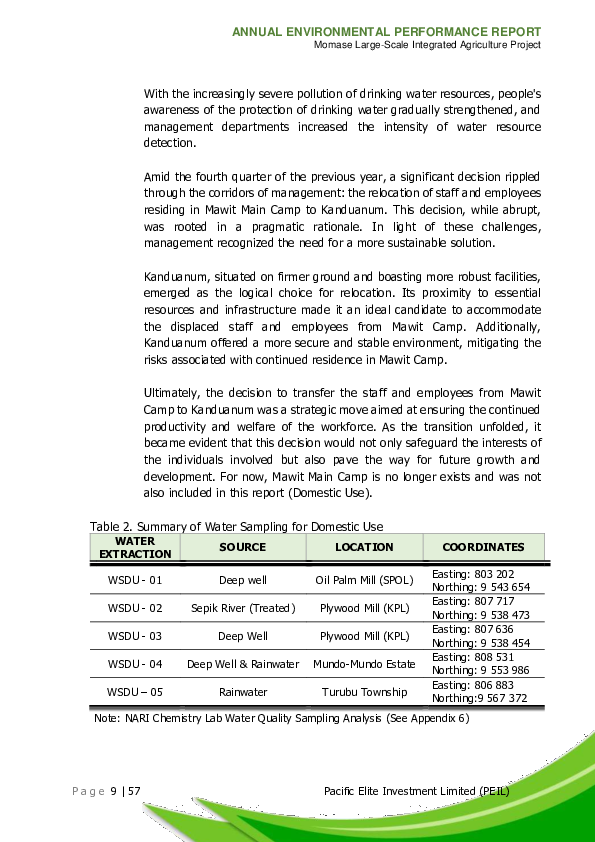
ANNUAL ENVIRONMENTAL PERFORMANCE REPORT
Momase Large-Scale Integrated Agriculture Project
a. Domestic Water
Water for domestic use is obtained from
both surface and underground water
sources. We periodically check and
monitor all PEIL private water sources for
water sampling to make sure the quality of
our drinking water is within the legal
limitations outlined in our Environmental
Permits - Water Extraction and in
compliance with the PNG Public Health
(Drinking) Water Quality Standards. Every
source of abstraction has a different set of
water samples taken. As of right now, PEIL
analyzes every water sample through the
NARI Chemistry Lab.
Table 3. Water Quality Criteria – Non – Disinfected Water Supplies.
Highest Maximum
Sampling
Parameters Desirable Permissible
Frequency
Level Level
Microbiological
E. coli (per 100 ml) None Monthly
Total Coliform (per 100 ml) <3* Monthly
Physical
Color 5 50 Monthly
Turbidity 5 units 25 units Monthly
Total Suspended Solids 500 mg/L 1,500 mg/l Monthly
Our Environmental Permit requires monthly sampling of all domestic water
sources, However, Oil Palm Mill (SPOL), Turubu Township, and Plywood
Mill (KPL) water extraction for domestic use are from Urr-u Creek, Deep
well, Sepik River, and Mawit Creek (Brinangat). SPOL- Oil Palm Mill, Turubu
Township, and Plywood Mill (KPL) water treatment shall be applied before
usage. The treated water tank is also installed for water storage. An
additional advantage of storing water is that the water quality improves
over time. If water is stored for one day over 50 percent of the bacteria
will die. Suspended solids, which can contain pathogens, will often settle
out during storage. By pouring the clear water out carefully, the settled
solids can be separated from the water.
P a g e 10 | 57 Pacific Elite Investment Limited (PEIL)
�
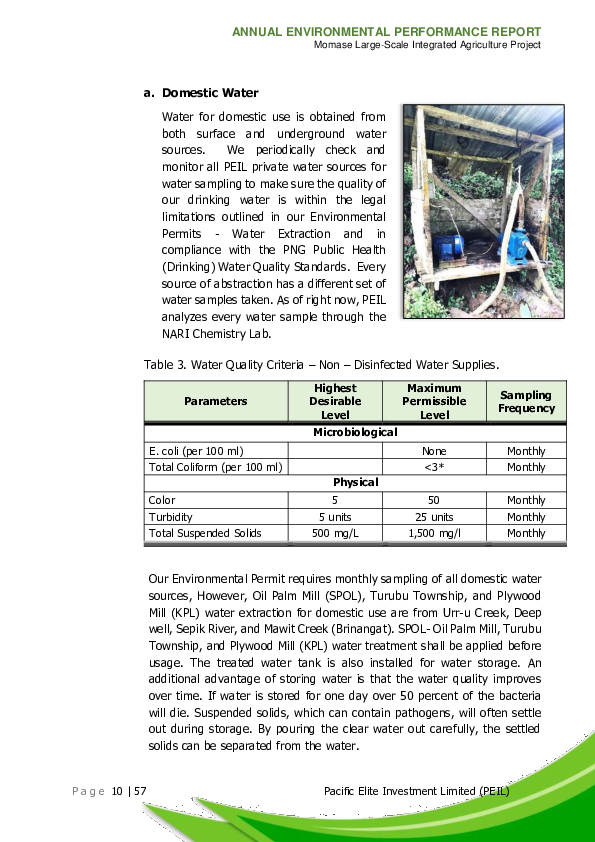
ANNUAL ENVIRONMENTAL PERFORMANCE REPORT
Momase Large-Scale Integrated Agriculture Project
Consequently, to ensure and fulfill
the requirements stipulated in our
Environmental Permit. We have to
identify some parameters for water
analysis this is to be done to make
sure that the water used for drinking
is safe and potable drinking water for
everyone. Appendix 6 Lists all the
water quality test results and
parameters analyzed.
To further enhance and improve
domestic water quality for
consumption, the company has
embarked on the installation of
Water treatment systems for all its
domestic water systems located in
Plywood Plant (KPL), Kanduanum
Village, Angoram District, East Sepik.
The system ensures all water sourced
from underground passes through
the filtration and disinfection system
to sanitize the microbiological
bacteria and remove other impurities
before supplying to the employees by
applying these chemical mixtures
such as Soda ash, Poly-Aluminum
Chloride (PAC), and Polymer. PEIL
ensures that the quality of the sourced
water that enters for domestic use is
safe for drinking and cooking.
Furthermore, the water that enters the
treatment plant is most often
either surface water or groundwater.
Surface water typically requires more
treatment and filtration than ground
water because lakes, rivers, and
streams contain more sediment (sand,
clay, silt, and other soil particles),
germs, chemicals, and toxins than
groundwater.
P a g e 11 | 57 Pacific Elite Investment Limited (PEIL)
�
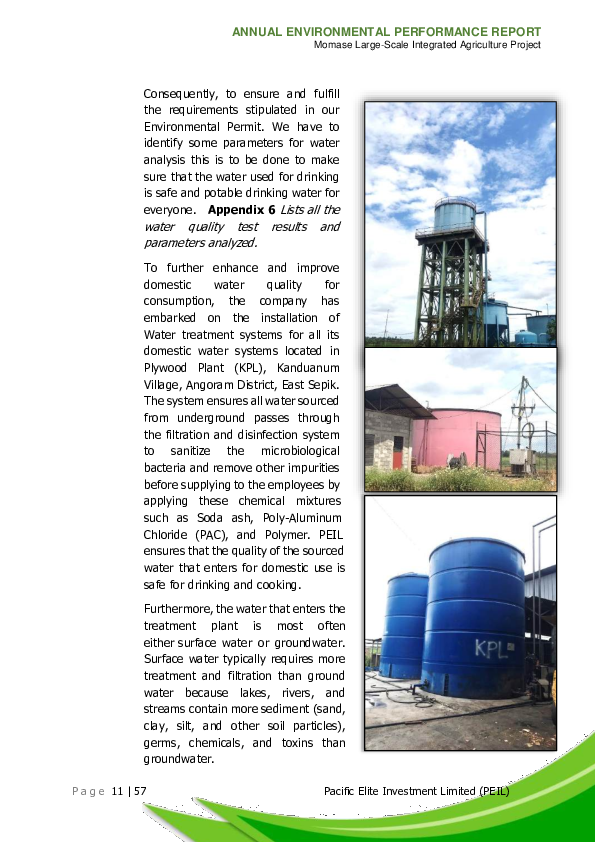
ANNUAL ENVIRONMENTAL PERFORMANCE REPORT
Momase Large-Scale Integrated Agriculture Project
Some water supplies may contain specific chemicals (such as nitrates), or
toxins (such as those made by cyanobacteria). Specialized methods to
control or remove these contaminants can also be part of water treatment.
MUNDO-MUNDO FIELD STAFF
TOWNSHIP WATER TANKS & LABORER WATER TANKS
MUNDO-MUNDO STAFF
SPOL STAFF WATER TANKS QUARTERS WATER TANKS
B. Waste Discharge
Multiple discharge points for both domestic and industrial wastewater
originating from our operations have been authorized within our consolidated
environmental permit. Compliance at these discharge points is regularly
ensured through thorough checks of the environmental permit conditions, the
approved waste management plan, and the Environmental Management Plan
(EMP).
P a g e 12 | 57 Pacific Elite Investment Limited (PEIL)
�
ANNUAL ENVIRONMENTAL PERFORMANCE REPORT
Momase Large-Scale Integrated Agriculture Project
Table 4. Summary of water sampling for PEIL water discharges.
WATER DISCHARGE SOURCE LOCATION COORDINATES
Easting: 808 158
WSD - 01 Sepik River Plywood Mill (KPL)
Northing: 9 537 943
Easting: 801 766
WSD - 02 Urr-u creek Oil Palm Mill (SPOL)
Northing: 9 542 785
Easting: 803 532
WSD 03 Nagam River Oil Palm Mill (SPOL)
Northing: 9 541 636
Easting: 810 094
WSD – 04 Urr-u creek Ibap Nursery
Northing:9 560 995
Mundo-mundo Easting: 811 831
WSD - 05 Wangay Creek
junction Kambrendo Northing: 9 557 720
Pond Easting: 802 952
WSWW Oil Palm Mill (SPOL)
(Mill Effluent) Northing: 9 542 934
NOTE: NARI Chemistry Lab Water Quality Sampling Analysis (See Appendix 6)
Location of Water Discharge:
Plywood Mill (KPL)
Water Source: Sepik River
Location of Water Discharge: Near SPOL.
Water Source: Urr-u Creek
P a g e 13 | 57 Pacific Elite Investment Limited (PEIL)
�
ANNUAL ENVIRONMENTAL PERFORMANCE REPORT
Momase Large-Scale Integrated Agriculture Project
1. Palm Oil Mill Effluent (POME) Monitoring
The palm oil mill effluents from the operating mill (SPOL) which is located
in Mundo-mundo Village, Angoram District, East Sepik Province are diverted
to a series of treatment ponds for treatment before discharge. After
undergoing anaerobic and aerobic treatment processes, the effluents from
the final pond are then transported via underground pipes to a series of
holding ponds located within the company plantation for further treatment
and later discharged into the plantation through a series of dug-out trenches
within the plantation. There is no direct discharge of effluent to the
environment.
SPOL - Palm oil mill management commonly applies conventional biological
treatments of anaerobic or facultative digestion. The anaerobic and
facultative ponds rely on bacteria to break down the organic matter into
simple end products of methane, carbon dioxide, hydrogen sulfide, and
water. This system consists of a series of ponds connected and each pond
has its purpose. However, this biological treatment system needs proper
maintenance and monitoring; increasing the labor requirement and cost.
This is due to the processes relying solely on microorganisms to break down
the pollutants. The microorganisms are very sensitive to the surrounding
temperature and pH and thus extra care has to be taken to ensure a
conducive environment for the microorganism to develop well. This
treatment also required a large treatment area with a long treatment period
(80 to 120 days). Moreover, biological treatment also generates vast
amounts of biogas, which is corrosive and odorous. This biogas contains
methane, carbon dioxide, and trace amounts of hydrogen sulfide. These
gases are corrosive and dangerous. Moreover, methane gas is more potent
and a fire hazard.
Furthermore, effluent and sludge generated in the SPOL - Oil Palm Mill
operation comprised of wastewater (washing of FFB & cooking fruits), pulp,
P a g e 14 | 57 Pacific Elite Investment Limited (PEIL)
�
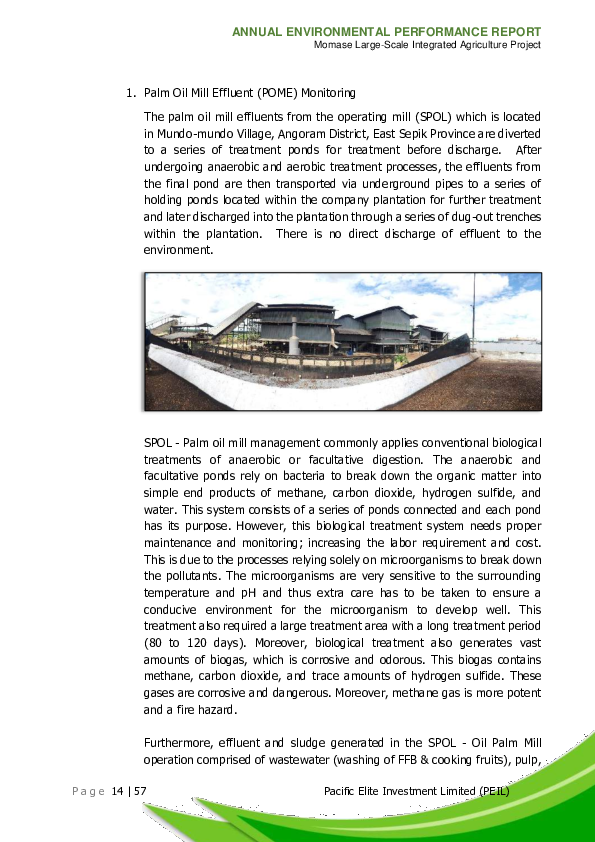
ANNUAL ENVIRONMENTAL PERFORMANCE REPORT
Momase Large-Scale Integrated Agriculture Project
and residual oil will be directed to the series of ponds (Cooling pond,
acidification pond, anaerobic pond, aerobic pond, facultative pond and
finally, the settling pond) constructed by the company. The size of the pond
will depend on the volume of waste and the number of days that these
wastes will stay in the pond during the treatment process.
The company ensures that all effluent samples collected at each respective
discharge point, the following parameters as summarized in Table 5 below
are analyzed against set criteria. See Appendix 3. Wastewater Data (POME)
Analysis.
Table 5. Effluent Quality Criteria for Treated Palm Oil Mill Effluent (POME)
Discharge.
Discharge to
Parameters Land Application
Surface Water
pH 5-9 5-9
Biological Oxygen Demand 4,000 100
Total Solids 3,000 1,500
Suspended Solids 1,000 500
Oil & Grease 50 50
Units in mg/L except pH
On the other hand, oil
palm mill effluents are
also treated and
discharged via land
application into the
plantation. As such we
ensure all parameters
stipulated in the permit
are within its legal
requirements for land
application. To – date
and as indicated in Appendix 3. Wastewater Data (POME) Analysis. Our
wastewater analysis readings are well below the legal and Environmental
Waste Discharge Permit requirements.
P a g e 15 | 57 Pacific Elite Investment Limited (PEIL)
�

ANNUAL ENVIRONMENTAL PERFORMANCE REPORT
Momase Large-Scale Integrated Agriculture Project
Other parameters such as Oil and Grease and Suspended Solids are also
monitored and results are also shown in Appendix 3. Wastewater Data
(POME) Analysis.
In the event of any non-compliance with our Environmental Permit – Waste
Discharge parameters, an investigation is conducted, and respective site
Managers are informed to ensure corrective measures are taken to correct
such non-conformities. Any significant non-compliance well beyond the
company’s control is reported to management and CEPA is informed.
To date, all POME discharges at respective Environmental Impact Points to
land are and have been well below the legal permit discharge limits as
contained in the Environmental Permit.
P a g e 16 | 57 Pacific Elite Investment Limited (PEIL)
�
ANNUAL ENVIRONMENTAL PERFORMANCE REPORT
Momase Large-Scale Integrated Agriculture Project
SEPIK OIL PALM MILL (Mill Effluent) located in Mundo-mundo, Angroram
District, East Sepik Province
(BIRDS EYES VIEW)
P a g e 17 | 57 Pacific Elite Investment Limited (PEIL)
�
ANNUAL ENVIRONMENTAL PERFORMANCE REPORT
Momase Large-Scale Integrated Agriculture Project
We undertake ongoing monitoring of the waste streams generated from our
operations
Palm Oil Mill Effluent (POME) discharges from its milling process
Water quality criteria for all treated POME Discharges (POME
wastewater)
Smoke emissions from mill boilers (smoke density meter is under its
procurement phase )
To monitor and assure compliance, the company makes sure that accurate data
is gathered and reported each month. Internal monitoring obligations of the
organization include the analysis and periodic reporting of all data collected
from the various waste streams at various discharge sites.
Any non-compliance with legal and regulatory requirements is checked and
reports are sent to respective sections/departments for investigations and to
take appropriate corrective actions.
2. Oil Palm Mill (Oil Interceptor)
An oil interceptor, also known as
an oil separator or oil trap, is a
device used in oil palm mills to
separate oil from water during the
milling process. In the context of
oil palm milling, an oil interceptor
is typically employed to capture
and remove oil that may be
present in the wastewater
generated from various stages of
palm oil production.
The oil interceptor works on the principle of gravity separation, where the
mixture of oil and water enters the interceptor, allowing the oil to rise to
the surface due to its lower density, while the water settles at the bottom.
The separated oil is then collected and can be recycled or processed further,
while the treated water is discharged or reused in the milling process.
P a g e 18 | 57 Pacific Elite Investment Limited (PEIL)
�
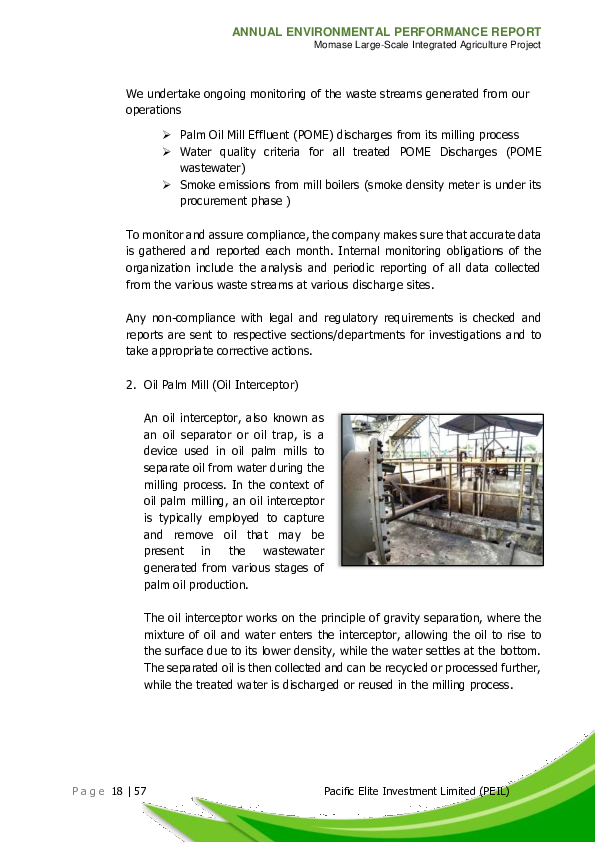
ANNUAL ENVIRONMENTAL PERFORMANCE REPORT
Momase Large-Scale Integrated Agriculture Project
Oil interceptors play a crucial role in
environmental management and
compliance in oil palm mills by
preventing oil contamination of
water bodies and ensuring that
wastewater discharged from the
mill meets regulatory standards for
oil content. Proper maintenance
and operation of oil interceptors are
essential to ensure effective oil-
water separation and minimize environmental impact.
Oil interceptors play several important roles in oil palm mills:
Environmental Protection
•Oil interceptors help prevent oil contamination of water bodies
by removing oil from wastewater before it is discharged. This is
crucial for protecting aquatic ecosystems and complying with
environmental regulations.
Compliance
•Many jurisdictions have regulations regarding the allowable oil
content in wastewater discharged from industrial facilities like oil
palm mills. Oil interceptors help mills meet these regulatory
requirements by effectively removing oil from wastewater.
Resource Recovery
•The oil separated by the interceptor can often be recycled or
processed further, providing an opportunity for resource
recovery and reducing waste.
Efficient Treatment
•By removing oil from wastewater, oil interceptors improve the
efficiency of downstream wastewater treatment processes. This
can reduce the load on treatment systems and improve overall
treatment performance.
Operational Efficiency
•Properly functioning oil interceptors help maintain the smooth
operation of oil palm mills by preventing oil buildup in
drainage systems, which can cause blockages and operational
disruptions.
P a g e 19 | 57 Pacific Elite Investment Limited (PEIL)
�
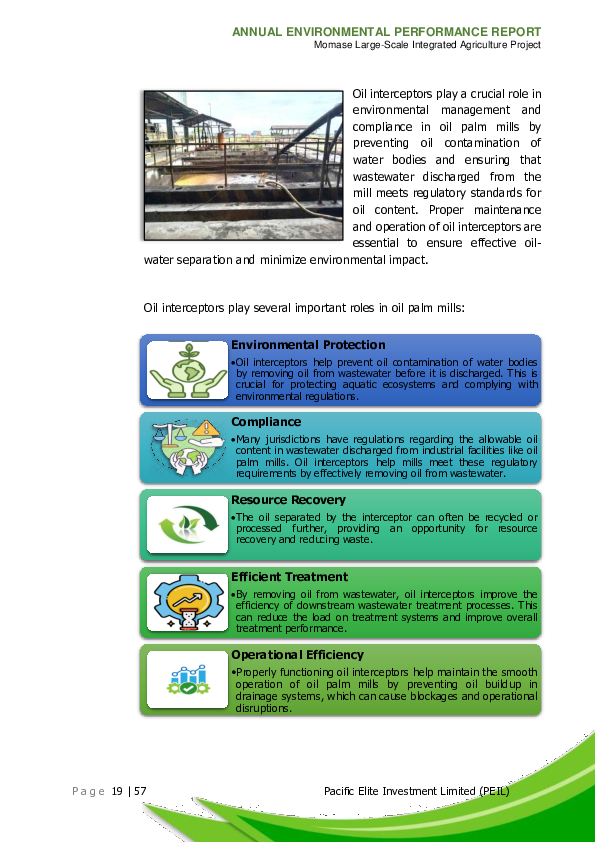
ANNUAL ENVIRONMENTAL PERFORMANCE REPORT
Momase Large-Scale Integrated Agriculture Project
3. Water Drainage
Drainage water management
practices can target
agronomic goals,
environmental (water quality)
goals, or both. The drainage
outlet can be set at or close
to the soil surface between
growing seasons to recharge
the water table, thereby
temporarily retaining
contaminated water in the
soil profile where it will be
subjected to attenuating and
nitrate-transforming
processes. In addition, it is
possible to raise the outlet
after planting to help increase
WATER DRAINAGE DISCHARGE
water availability to shallow
plant roots and to raise or
lower it throughout the growing season in response to weather conditions.
In some soils, water may even be added during very dry periods to reduce
crop loss from drought, and this practice is termed sub-irrigation. However,
the drain spacing for sub-irrigation has to be half the recommended value
for drainage for the addition of water to be very effective.
On the other hand, proper drainage systems for estate and base camp sites
shall be thoroughly constructed to prevent the accumulation of stagnant
water, which can become a breeding ground for disease-carrying
mosquitoes and other pests. By providing efficient wastewater disposal,
drainage systems contribute to improved sanitation, reducing the risk of
waterborne illnesses and promoting the overall safety of people living inside
the estate and base camps and community well-being as well.
P a g e 20 | 57 Pacific Elite Investment Limited (PEIL)
�

ANNUAL ENVIRONMENTAL PERFORMANCE REPORT
Momase Large-Scale Integrated Agriculture Project
TOWNSHIP DRAINAGE SYSTEM TOWNSHIP DRAINAGE SYSTEM
MUNDO-MUNDO DRAINAGE SYSTEM
4. Sewage
Nestled within the sprawling expanse of
the plantation, a network of facilities
hummed with activity. Amidst the
rhythmic rustle of palm fronds, workers
tended to the vital infrastructure that
supported the cultivation of this lucrative
crop. Among these facilities, sewage and
SPOL STAFF TOILET
septic toilet tanks played a crucial role,
often overlooked but essential for the
sustainable growth of the plantation.
As the plantation flourished,
accommodating a growing workforce and
infrastructure, the issue of waste
management loomed large. The sheer
scale of operations demanded efficient MUNDO-MUNDO TOILET
solutions to handle human waste
effectively while minimizing environmental impact. Herein lay the
significance of sewage and septic toilet tanks.
Unlike conventional sewage systems, which could be impractical and costly
to implement across vast plantations, septic tanks offered a decentralized
and cost-effective alternative. Strategically placed throughout the estate,
these underground chambers served as efficient waste disposal units,
harnessing natural processes to break down organic matter.
P a g e 21 | 57 Pacific Elite Investment Limited (PEIL)
�
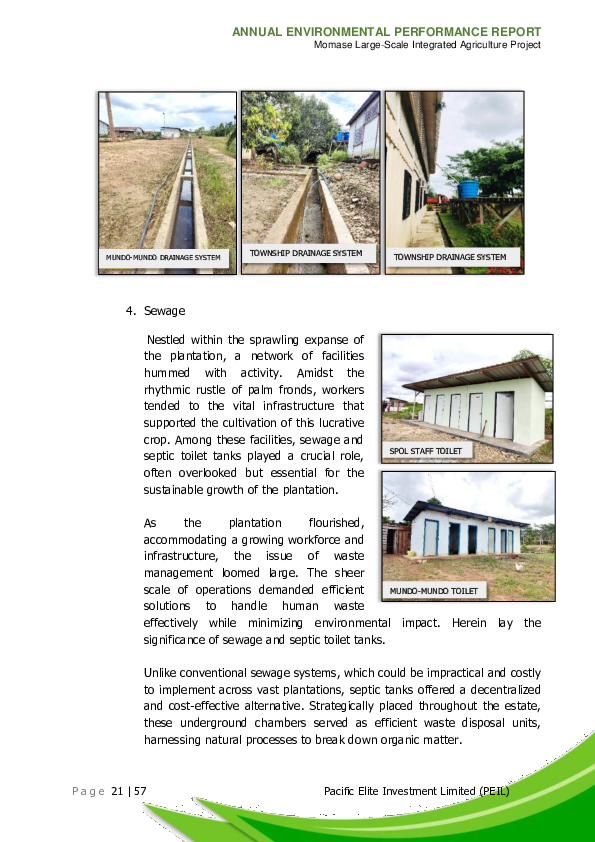
ANNUAL ENVIRONMENTAL PERFORMANCE REPORT
Momase Large-Scale Integrated Agriculture Project
The importance of these tanks extended beyond mere waste management.
In the delicate ecosystem of the oil palm plantation, proper sanitation was
paramount to prevent contamination of soil and water sources. Septic tanks
provided a reliable means of containing and treating human waste,
safeguarding the environmental integrity of the plantation.
Moreover, the presence of well-maintained sewage and septic systems
contributed to the overall well-being of the plantation community. By
promoting hygiene and sanitation standards, these facilities helped reduce
the risk of waterborne diseases, ensuring the health and productivity of
workers.
In the broader context of sustainable development, the role of sewage and
septic toilet tanks in oil palm plantations underscored the importance of
integrating environmental stewardship with economic prosperity. Through
efficient waste management practices, plantations could minimize their
ecological footprint while maximizing yields, thus fostering a harmonious
relationship between agriculture and the environment.
Table 6. List of water tanks and septic tanks locations and coordinates within
PEIL. (Please see the attached Map)
TOWNSHIP COMPOUND
STN EASTING NORTHING REMARKS
1 806 910 9 567 807 WATER TANK
2 806 918 9 567 797 SEPTIC TANK
3 806 928 9 567 787 WATER TANK
4 806 946 9 567 765 WATER TANK
5 806 955 9 567 756 SEPTIC TANK
6 806 965 9 567 745 WATER TANK
7 806 908 9 567 464 WATER TANK
8 806 932 9 567 392 WATER TANK
9 806 954 9 567 393 SEPTIC TANK
10 806 894 9 567 393 SEPTIC TANK
11 806 885 9 567 381 WATER TANK
12 806 883 9 567 372 WATER TANK
13 806 903 9 567 348 WATER TANK
14 806 914 9 567 351 WATER TANK
15 806 917 9 567 347 SEPTIC TANK
P a g e 22 | 57 Pacific Elite Investment Limited (PEIL)
�

ANNUAL ENVIRONMENTAL PERFORMANCE REPORT
Momase Large-Scale Integrated Agriculture Project
TOWNSHIP COMPOUND
STN EASTING NORTHING REMARKS
16 806 895 9 567 331 SEPTIC TANK
17 806 869 9 567 310 SEPTIC TANK
18 806 830 9 567 336 WATER TANK
19 806 835 9 567 341 SEPTIC TANK
20 806 848 9 567 352 SEPTIC TANK
21 806 858 9 567 360 SEPTIC TANK
22 806 872 9 567 372 SEPTIC TANK
23 806 857 9 567 349 WATER TANK
24 806 868 9 567 339 WATER TANK
25 806 878 9 567 326 WATER TANK
26 807 161 9 567 364 WATER TANK
27 806 810 9 567 060 WATER TANK
28 806 819 9 567 050 SEPTIC TANK
29 806 838 9 567 042 WATER TANK
30 806 846 9 567 018 WATER TANK
31 806 855 9 567 007 SEPTIC TANK
32 806 864 9 566 995 WATER TANK
33 806 714 9 566 449 PUMP HOUSE
34 806 659 9 566 472 WATER POND
35 806 811 9 567 521 WATER TANK
36 806 904 9 567 465 SEPTIC TANK
SPOL OIL MILL PLANT
STN EASTING NORTHING REMARKS
1 803 160 9 543 643 SEPTIC TANK
2 803 202 9 543 654 DEEPWELL
3 803 229 9 543 618 SEPTIC TANK
4 803 332 9 543 479 SEPTIC TANK
5 803 328 9 543 445 SEPTIC TANK
6 803 367 9 543 431 SEPTIC TANK
7 803 386 9 543 429 SEPTIC TANK
8 803 388 9 543 468 DEEPWELL
9 803 170 9 543 341 SEPTIC TANK
P a g e 23 | 57 Pacific Elite Investment Limited (PEIL)
�
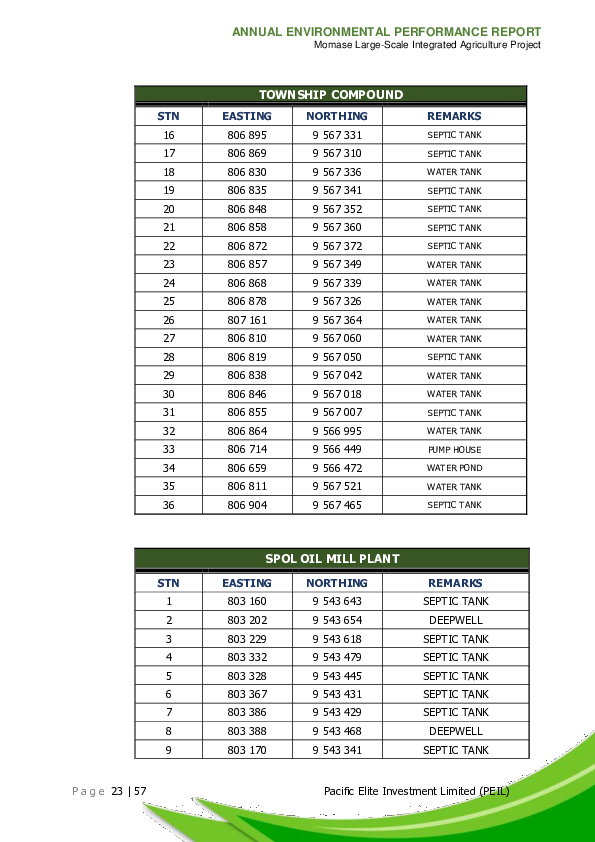
ANNUAL ENVIRONMENTAL PERFORMANCE REPORT
Momase Large-Scale Integrated Agriculture Project
SPOL OIL MILL PLANT
STN EASTING NORTHING REMARKS
10 803 153 9 543 629 WATER TANK
11 803 387 9 543 458 WATER TANK
12 803 511 9 543 956 WATER TANK
13 803 172 9 543 391 OVERHEAD WATER TANK
14 803 160 9 543 399 TREATED WATER TANK
15 803 450 9 543 910 SEPTIC TANK
16 803 465 9 543 921 SEPTIC TANK
17 803 478 9 543 931 SEPTIC TANK
KENYARE COMPOUND
STN EASTING NORTHING REMARKS
1 808 790 9 573 015 SEPTIC TANK
2 808 783 9 572 978 SEPTIC TANK
3 808 826 9 572 984 SEPTIC TANK
4 808 844 9 572 982 SEPTIC TANK
5 808 828 9 572 962 SEPTIC TANK
6 808 840 9 572 961 SEPTIC TANK
7 808 837 9 572 935 SEPTIC TANK
8 808 823 9 572 937 SEPTIC TANK
9 808 662 9 572 887 SEPTIC TANK
10 808 637 9 572 871 SEPTIC TANK
11 808 590 9 572 837 SEPTIC TANK
12 808 838 9 572 830 SEPTIC TANK
13 808 835 9 572 538 POND 1
14 808 846 9 572 491 POND 2
15 808 841 9 572 513 PUMP HOUSE
16 808 922 9 572 965 WATER TANK
17 808 893 9 572 864 WORKSHOP
P a g e 24 | 57 Pacific Elite Investment Limited (PEIL)
�
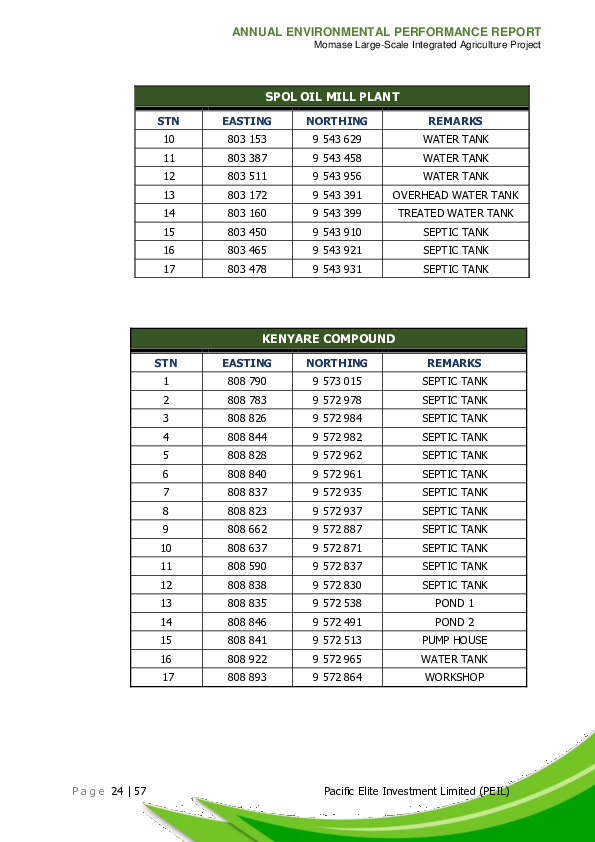
ANNUAL ENVIRONMENTAL PERFORMANCE REPORT
Momase Large-Scale Integrated Agriculture Project
IBAP NURSERY
STN EASTING NORTHING REMARKS
1 810 099 9 561 025 WATER PUMP
2 810 083 9 561 007 WATER POND
810 073 9 561 011 EXTRACTION
810 094 9 560 995 DISCHARGE
810,222.67 9,561,096.70 PUMP HOUSE
KUKUSANG PLYWOOD LIMITED
STN EASTING NORTHING REMARKS
1 807 513 9 538 290 SEPTIC TANK
2 807 535 9 538 275 WATER TANK
3 807 548 9 538 317 WATER TANK
4 807 557 9 538 310 SEPTIC TANK
5 807 586 9 538 278 SEPTIC TANK
6 807 558 9 538 387 SEPTIC TANK
7 807 561 9 538 390 SEPTIC TANK
8 807 570 9 538 374 WATER TANK
9 807 582 9 538 362 SEPTIC TANK
10 807 589 9 538 363 SEPTIC TANK
11 807 591 9 538 452 WATER TANK
12 807 604 9 538 451 SEPTIC TANK
13 807 640 9 538 406 SEPTIC TANK
14 807 636 9 538 454 DEEPWELL
15 807 649 9 538 440 SEPTIC TANK
16 807 667 9 538 421 SEPTIC TANK
17 807 674 9 538 413 WATER TANK
18 807 631 9 538 496 SEPTIC TANK
19 807 687 9 538 498 WATER TANK
20 807 712 9 538 488 SEPTIC TANK
21 807 717 9 538 473 WATER TANK
22 807 725 9 538 466 SEPTIC TANK
23 807 655 9 538 203 WATER TANK
24 807 665 9 538 204 SEPTIC TANK
25 807 583 9 538 281 WATER TANK
P a g e 25 | 57 Pacific Elite Investment Limited (PEIL)
�
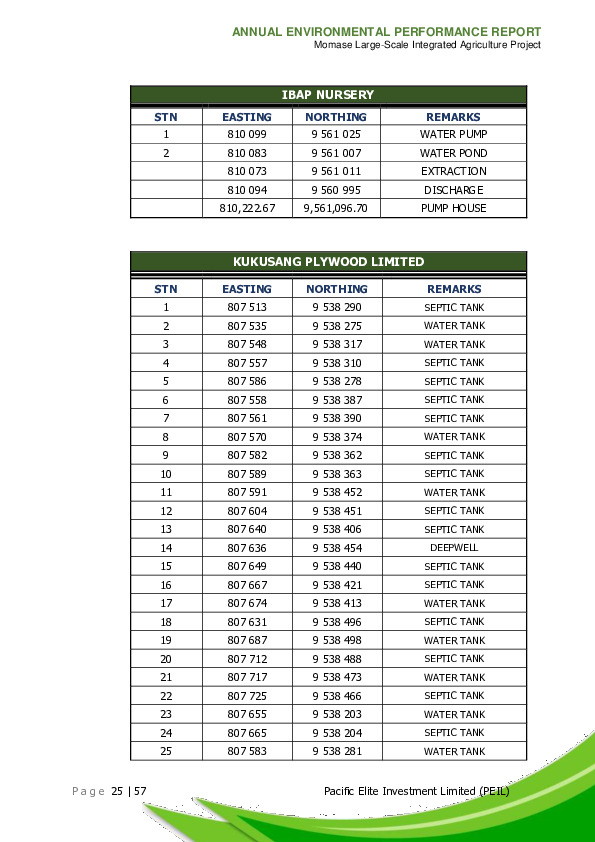
ANNUAL ENVIRONMENTAL PERFORMANCE REPORT
Momase Large-Scale Integrated Agriculture Project
KUKUSANG PLYWOOD LIMITED
STN EASTING NORTHING REMARKS
26 807 400 9 538 452 WATER TANK
27 807 412 9 538 447 SEPTIC TANK
28 807 441 9 538 414 SEPTIC TANK
29 807 444 9 538 409 WATER TANK
30 807 849 9 538 135 WATER TANK
31 807 854 9 538 151 WATER TANK
32 807 876 9 538 170 WATER TANK
33 807 904 9 538 184 WATER TANK
34 807 756 9 538 291 WATER TREATMENT TANK
P a g e 26 | 57 Pacific Elite Investment Limited (PEIL)
�
ANNUAL ENVIRONMENTAL PERFORMANCE REPORT
Momase Large-Scale Integrated Agriculture Project
C. Energy usage
The company (SPOL) aspires
to aggressively conserve
energy and to progressively
reduce reliance on non–
renewable (diesel fuel) energy
towards the use of renewable
energy sources, and reduce
greenhouse gas emissions.
We use waste products from
the mill such as fiber and
endocarp (kernel & shell) to generate power for use in the (boiler 1) milling
process. The mesocarp fiber and endocarp (kernel & shell) generated during
the de-pericarping, and stripping process will be fed as fuel to the boiler
furnace.
About 80% of the energy produced is from renewable resources (turbines).
SPOL ensures that we focus on energy efficiency (management) improvements
in the mills. Hence, most electricity is generated by renewable energy sources
to drive our mill turbines thus decreasing dependence on diesel fuel. Some of
the excessive energy generated is also fed into the grid for domestic
consumption in the company housing and residential areas thus further
reducing its dependency on the use of diesel fuels. (Please see the attached
Appendix 4. Energy Generation).
P a g e 27 | 57 Pacific Elite Investment Limited (PEIL)
�

ANNUAL ENVIRONMENTAL PERFORMANCE REPORT
Momase Large-Scale Integrated Agriculture Project
GENERATOR (DIESEL DRIVEN)
TOWNSHIP ELECTRIC POWER SUPPLY TOWNSHIP GENERATOR SET HOUSE
MUNDO-MUNDO GENERATOR
POWER SUPPLY KPL ELECTRIC POWER SUPPLY
NURSERY ELECTRIC SUPPLY
KENYARE ELECTRIC POWER SUPPLY
AND WATER PUMP
P a g e 28 | 57 Pacific Elite Investment Limited (PEIL)
�
ANNUAL ENVIRONMENTAL PERFORMANCE REPORT
Momase Large-Scale Integrated Agriculture Project
The company’s Plywood Plant (KPL) daily operation also uses a diesel-driven
generator set, a crucial component that ensures uninterrupted power supply to
sustain various production processes. Traditionally, the use of diesel-driven
generators has raised environmental concerns due to emissions of pollutants
such as nitrogen oxides (NOx), sulfur oxides (SOx), particulate matter (PM),
and carbon dioxide (CO2). However, in recent years, the plywood industry has
made significant strides toward mitigating these environmental impacts by
adopting environmentally friendly practices in genset usage.
One key approach to enhancing
the environmental performance of
diesel-driven generators in
plywood plants is the integration
of advanced emission control
technologies. These technologies
include diesel particulate filters
(DPF), selective catalytic reduction
(SCR) systems, and exhaust gas
recirculation (EGR), among others.
By incorporating these
technologies, diesel-driven generators can significantly reduce emissions of
harmful pollutants, thus improving air quality both within the plant premises
and in the surrounding environment.
Moreover, plywood plant (KPL) is increasingly exploring alternative fuels and
renewable energy sources to power their operations, further minimizing their
environmental footprint. This may involve the utilization of biodiesel derived
from sustainable sources or the integration of renewable energy technologies
such as solar photovoltaic (PV) systems or biomass boilers. By diversifying their
energy sources and reducing reliance on fossil fuels, plywood plants can
P a g e 29 | 57 Pacific Elite Investment Limited (PEIL)
�
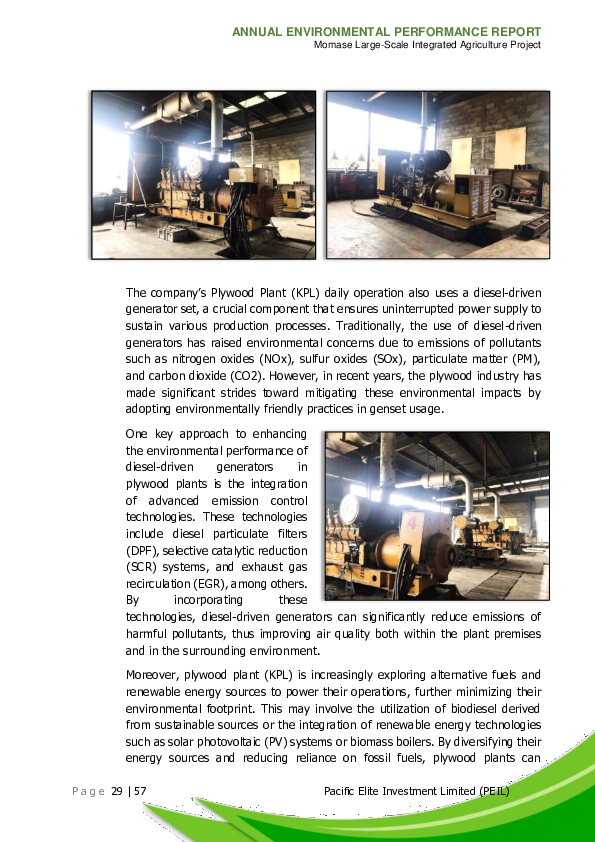
ANNUAL ENVIRONMENTAL PERFORMANCE REPORT
Momase Large-Scale Integrated Agriculture Project
contribute to a more sustainable energy landscape while mitigating the
environmental impact associated with diesel genset usage.
In addition to technological advancements, KPL Plywood Plant is also
implementing best practices in genset maintenance and operation to optimize
fuel efficiency and minimize emissions. Regular maintenance checks, efficient
load management, and proper tuning of diesel-driven generators are essential
steps in ensuring that they operate at peak performance while minimizing their
environmental footprint.
Overall, the use of diesel-driven generators in plywood plants can be made
environmentally friendly through the adoption of advanced emission control
technologies, utilization of alternative fuels, and integration of renewable
energy sources. By embracing these sustainable practices, the plywood industry
can reduce its environmental impact while maintaining reliable and efficient
operations to meet the global demand for wood products.
D. Solid Wastes
1. Industrial Solid waste
As part of the company’s waste
management and resource reuse and
recycle strategy some waste
management strategies are used. All
solid wastes generated from the mill
operations (Kernel, Fiber, and EFB) are
as per our Environmental Permits –
Waste Discharge.
Fiber is stored on-site for use at the mill
The following wastes are generated from boiler for steam generation
milling operations:
Empty Fruit Bunch (EFB)
Kernel Shell
Fiber
Boiler Ash
Other Industrial Wastes
The total quantity of waste generated and classified under each of the different
waste streams above are listed in Appendix 2 Oil Palm Mill (FFB Processing -
Solid Waste Generation) of these reports.
P a g e 30 | 57 Pacific Elite Investment Limited (PEIL)
�

ANNUAL ENVIRONMENTAL PERFORMANCE REPORT
Momase Large-Scale Integrated Agriculture Project
Empty Fruit Bunches (EFB), including Decanter
Cake, are weighted and later applied into the
field to serve as mulching.
Boiler ash is stored and later taken to the
composting site for manual decomposition.
Scrap metals, used machinery, and equipment
parts are stored and reused as spare parts.
Once unusable they are stored at the lay-down
area and later salvaged by scrap metal buyers.
Contaminated hydrocarbon wastes
(contaminated sawdust, rugs, filters,
batteries, etc.) are taken to the landfill site and
EFB is ready for application disposed of into the hydrocarbons and
into the field for mulching.
workshop waste pit.
Empty Chemical and pesticide containers are
triple-rinsed and reused. All damaged and unusable ones are punctured and
disposed of in the pesticide waste pit at the landfill site.
All our domestic household wastes generated from the company employee
housing villages are segregated (store and garden), placed in bins, regularly
collected weighed at the weighbridge, and disposed of into the designated
domestic waste pits located at each of
the estates. There is a central landfill
site located within every estate where
several pits have been constructed for
the different waste streams generated
from the company operations. The
Turubu Township, Mundo-Mundo, and
Kenyare estates are located further
MUNDO-MUNDO WASTE DISPOSAL SITE
away and have their own smaller
landfills for waste disposal.
P a g e 31 | 57 Pacific Elite Investment Limited (PEIL)
�
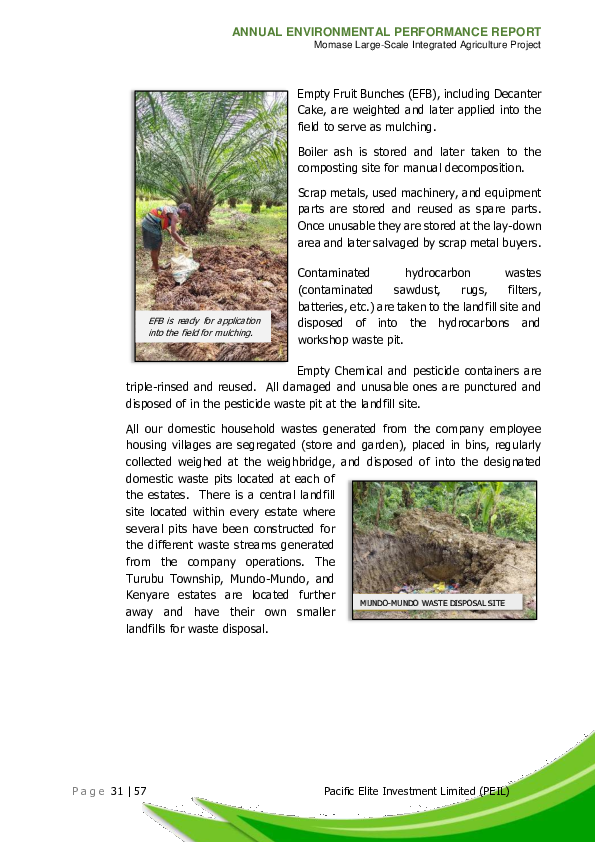
ANNUAL ENVIRONMENTAL PERFORMANCE REPORT
Momase Large-Scale Integrated Agriculture Project
Solid waste segregation in KPL (Staff Quarters)
E. Machinery maintenance workshop and fuel storage
The maintenance workshop is operated in
compliance with the CEPA Code of Practice
for Vehicle/Machinery Workshops and
Petroleum (Hydrocarbons) Storage/Usage
Site (DEC, 1997). Workshop area flooring
and drainage include oil water interceptors
to improve the clarity of wash water before
release into the local drainage. The waste
KENYARE PETROL products are handled as prescribed in the
AND OIL STORAGE
Waste Management Plan and described
above. Fuel is currently stored in drums
inside a satisfactory bonded and sheltered shed. Oil Palm Mill and Plywood
Plant Depot for fuel storage are being installed and constructed.
P a g e 32 | 57 Pacific Elite Investment Limited (PEIL)
�
ANNUAL ENVIRONMENTAL PERFORMANCE REPORT
Momase Large-Scale Integrated Agriculture Project
FUEL DEPOT
MUNDO-MUNDO FUEL DEPOT
KENYARE FUEL DEPOT
WORKSHOP FACILITIES
KENYARE WORKSHOP SPOL WORKSHOP
SPOL WORKSHOP
P a g e 33 | 57 Pacific Elite Investment Limited (PEIL)
�
ANNUAL ENVIRONMENTAL PERFORMANCE REPORT
Momase Large-Scale Integrated Agriculture Project
II. ENVIRONMENTAL MANAGEMENT INITIATIVES
A. Buffer Zone Management
In many of the conservation programs and projects, zoning principles are applied
to allow protection to be combined with human use, whereby important areas
(often conservation areas and/or core zones are surrounded by so-called buffer
zones.
According to the
PNG Logging
Code of Practice,
rivers that are
less than 5
meters wide
must have a 10-
meter buffer
zone on either
side, while rivers that are wider than 5 meters must have a 50-meter buffer zone.
After marking is complete, GPS is used to map the buffer zone areas, and the
tree planting activity program is then conducted.
Table 7: Buffer Zones Establishment.
LENGTH
ESTATES BUFFER ZONE MARKING
(km)
Oil Palm Mill-SPOL 17.37 March 2017
Ibap Nursery 7.63 April 2017
Mundo-mundo Estate 4.02 May 2017
Turubu Township 4.64 June 2017
Kenyare Compound 6.45 July 2017
Mawit Basecamp 4.83 August 2017
Poimbit Nursery 11.25 January 2018
Poimbit Estate 1.82 February 2018
PEIL has identified all buffer zones as High Conservation Value areas. The
riparian buffer zones are established along streams and creeks that flow through
all SPOL plantations. These areas have been left untouched as much as possible
by natural vegetation allowed to regenerate including the planting of native tree
species, flowering plants, fruit trees, and bamboo.
P a g e 34 | 57 Pacific Elite Investment Limited (PEIL)
�
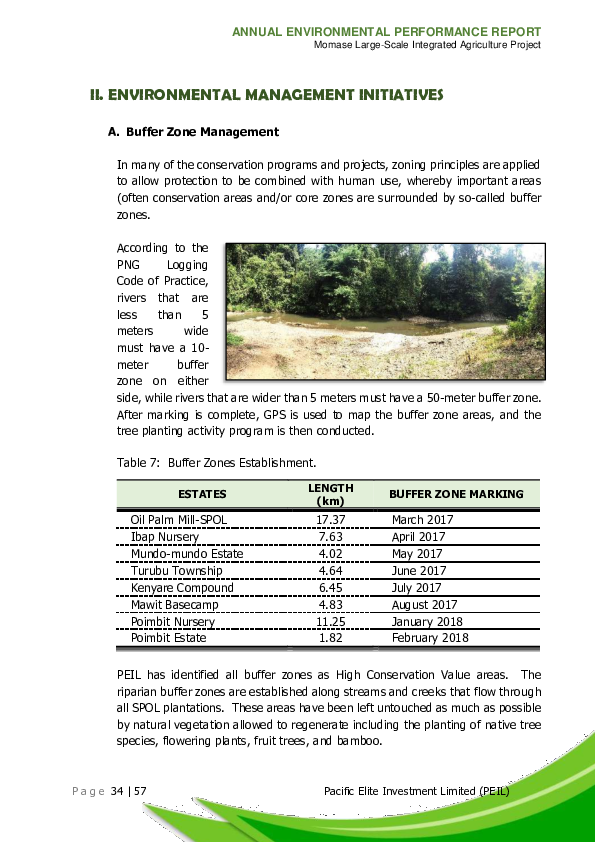
ANNUAL ENVIRONMENTAL PERFORMANCE REPORT
Momase Large-Scale Integrated Agriculture Project
There are various policies implemented and put into place by the employer to
further improve and safeguard watercourses, streams, and creeks operating
inside the company establishments. The environmental, biodiversity, zero-
burning, and buffer zone policies are a few examples of the policies. According
to these laws, the company prohibits the burning of vegetation within any buffer
zones as well as unlawful fishing, gardening, and hunting.
Oil Palm Mill-SPOL Buffer Zone Mundo-Mundo Estate Buffer Zone
(Birds eye view) (Birds eye view)
Turubu Township - Parua Buffer Zone (Birds eye view)
P a g e 35 | 57 Pacific Elite Investment Limited (PEIL)
�
ANNUAL ENVIRONMENTAL PERFORMANCE REPORT
Momase Large-Scale Integrated Agriculture Project
Buffer zones are seen as important tools in both conserving areas of ecological
importance and addressing development objectives. Although the company has
been tough in promoting awareness of illegal gardening and cutting of native and
endangered species along rivers and creeks, there have been some setback
experiences whereby intruders have entered and cut trees which is a challenge
that we are trying to take control of. The management will continuously give
support and extend some effort in promoting some mitigating measures to
ensure buffer zone management will be thoroughly implemented.
BUFFER LOW-LYING AREA BUFFER ROAD BETWEEN
PLANTATION AND BUSH
BUFFER ROAD BETWEEN
BUFFER ROAD BETWEEN
PLANTATION AND BUSH PLANTATION AND BUSH
P a g e 36 | 57 Pacific Elite Investment Limited (PEIL)
�
ANNUAL ENVIRONMENTAL PERFORMANCE REPORT
Momase Large-Scale Integrated Agriculture Project
B. Conservation Area Management
We have also set aside a few natural areas across our operations as reserves
which we view to be areas of significance and have high conservation value
that we intend to protect and conserve. These conservation areas include
gardens and habitations, swampy, burial sites, riparian buffer zones, sacred
places, historical and cultural significance, and inaccessible areas.
RESOURCE AREA
11,390.00 11%
16,400.00 16%
37,427.00 36%
38,222.00 36%
1,561.00 1%
Inoperable Area Productive Forest Natural Forest Logged Over Grassland
Gardens & habitations, grassland,
swampy, burial Sites, riparian The company manages to implement Conservation Area
buffer zones, sacred, historical
and cultural significance and Management strategies. Hence, PEIL work focuses on
inaccessible area
valuing and conserving nature, ensuring effective and
equitable governance of its use, and deploying nature-based solutions to global
challenges in climate, and for sustainable development.
C. Water Management Plan
A Water Management Plan is developed to ensure all water extraction usage
and discharges and within set limits and standards required. The plan captures
all aspects of our water extraction, water quality monitoring criteria, and
ongoing site inspections and audits. The following key areas are captured in
the plan and regularly reviewed as required:
P a g e 37 | 57 Pacific Elite Investment Limited (PEIL)
�
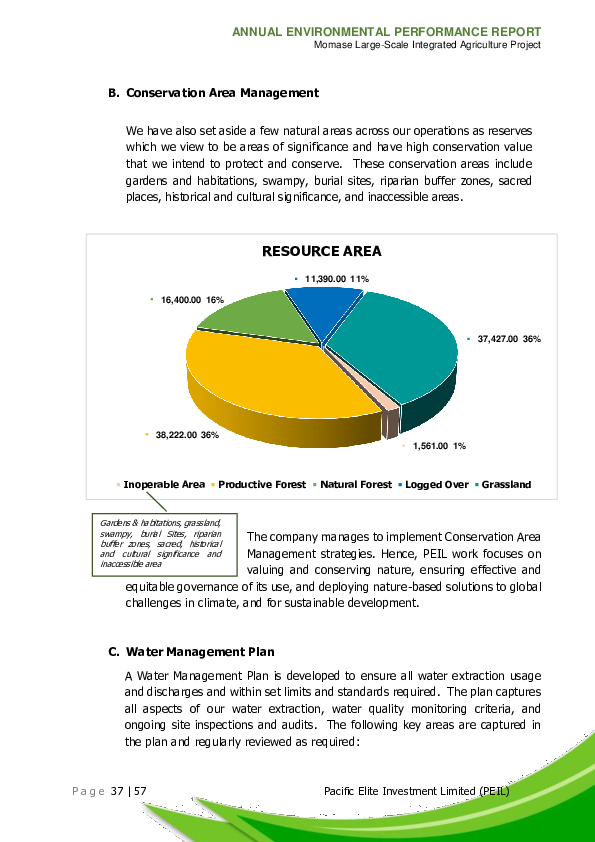
ANNUAL ENVIRONMENTAL PERFORMANCE REPORT
Momase Large-Scale Integrated Agriculture Project
Water Extraction
Wastewater Discharge
Water Sampling Program
Data Analysis and Reporting
Monitoring and Inspection Program
The primary purpose of the water management plan is to ensure best practices
are in place to maintain the quality and availability of surface and groundwater,
including wastewater discharge. And to ensure that all water abstracted, used,
and wastewater discharges are monitored and in compliance with regulatory
requirements.
Regular (monthly/quarterly) water sampling is undertaken for all domestic
consumption, effluent wastewater discharge, and for all rivers and creeks.
Results of all drinking water quality and wastewater discharges are presented
in the various sections of this report. (See Appendix 6. Lists all the water quality
test results and parameters analyzed).
D. Waste Management Plan
Wastes are always generated in any developmental activity. The types of
wastes and waste by-products that will be engendered during the mill site
ground preparation, construction, and operation of the Palm Oil Mill are
described lucidly in the succeeding sections.
The description will also cover sources from which these wastes
emanated/originated and how they will be treated/mitigated, handled, stored,
reused or recycled, managed, and at the end, disposed of at the designated
waste disposal sites.
The developer is well aware of and will take into account when and how all the
wastes will be generated, and will take appropriate remedial measures to treat,
manage, reduce or minimize, and store these wastes according to their
quantities and toxicity levels before disposing them at the appropriately
designated disposal sites.
P a g e 38 | 57 Pacific Elite Investment Limited (PEIL)
�
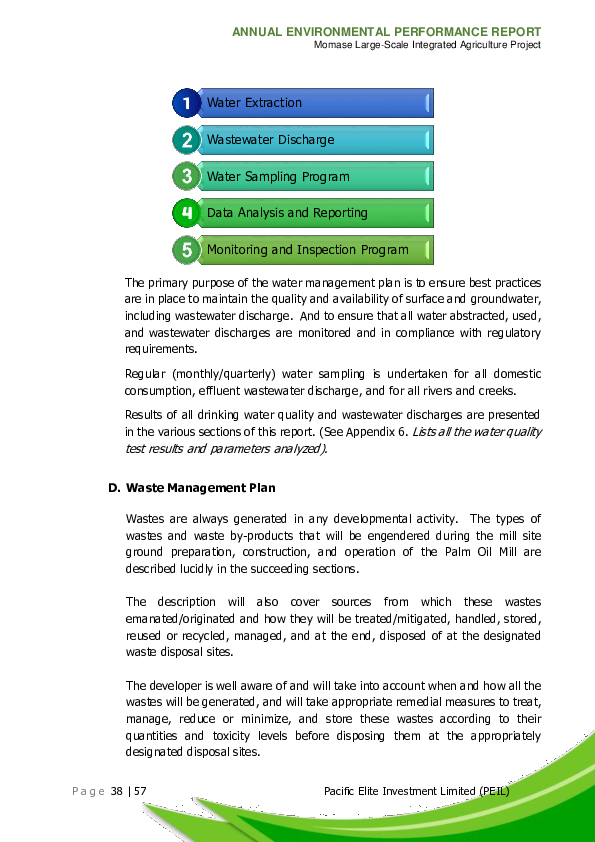
ANNUAL ENVIRONMENTAL PERFORMANCE REPORT
Momase Large-Scale Integrated Agriculture Project
The environment management program comprises the following components,
to wit:
Identification of sources and types of waste;
Identification of specific waste products;
Waste control, containment, and minimization action
Waste storage and treatment method;
Waste handling and transportation method;
Final waste disposal method;
Collection and disposal frequency; and
Responsible personnel to do the tasks.
Appendix 7 shows the Waste Management Plan Details Matrix. It identifies
the environmental issues, the waste products/emissions, the possible sources,
and the environmental management options to be implemented to mitigate
adverse impacts.
WASTE:
Various wastes are generated as by-products from different activities, such as
wastes produced from the ground preparation of the mill site and plantation
site preparation, and construction and operation of the palm oil mill, plywood
plant and sawmill. To manage these wastes, PEIL, and the Contractor will use
mitigation methods and techniques (strategies/ mechanisms) to purposely
minimize and control these wastes. Excessive and toxic wastes will be
appropriately treated into simplicity and also to reduce their toxicity levels by
separating and retaining toxic elements and compounds from mixtures
(effluents), and disposed of at recommended disposal sites. Other recyclable
wastes will be reused, while hazardous wastes will be safely handled away
before their elimination. Non-biodegradable wastes (e.g. plastic litter) will
either be incinerated (burned) or, buried to avoid accidental contaminations,
and prevented from being transported into water courses during downpours
resulting in pollution, causing injuries, or becoming threats/risks to lives. Those
wastes to be buried in this case are garbage waste and putrefied wastes
including broken glass and metals.
The executives of the company have been involved in timber-related
operations, oil palm plantation development, and palm oil mill & timber
downstream processing operations outside and inside the country for many
years and are well aware of the different types of waste that are usually
P a g e 39 | 57 Pacific Elite Investment Limited (PEIL)
�

ANNUAL ENVIRONMENTAL PERFORMANCE REPORT
Momase Large-Scale Integrated Agriculture Project
generated. Therefore, PEIL will always find appropriate ways and means and
continue to take remedial measures, to manage, treat (those wastes that
warrant treatment), and simplify (especially raw biodegradable wastes such as
sewerage) before disposing them into the environment
1. NATURE OF SPECIFIC WASTE
Determination of the waste products and identification of their nature
generated from all phases of the project operation is a vital component of
any waste management program. The nature of specific waste is generally
classified into Biodegradable, Non-biodegradable, and Toxic waste. Waste
Classification is the important first step and is very relevant in finding and
implementing appropriate waste treatment and disposal methods.
Appendix 8: Shows the Nature of the Specific Waste Products Matrix.
a) Biodegradable Waste – These are the wastes that will be able to
decompose by bacteria (aerobic or un-aerobic), fungi, and other
biological means. The residues of decomposition mustn't be harmful
or toxic to living organisms and man. These wastes, if fully
decomposed, are good soil amelioration materials that will improve
their physical and chemical properties. However, this specific waste
might render negative environmental effects (e.g. foul odor) if not
properly managed.
Most organic wastes such as papers, wood debris, empty oil palm
bunches, sludge, discarded food, food preparation-related wastes,
and others are a few examples of so-called biodegradable wastes.
b) Non-biodegradable Waste – This type of waste has the nature of
not being decomposed by biological means. Specific examples are
scrap iron, junk machinery/parts, cables, wires, containers (bottles,
plastic, glass, and metal), and polyethylene bags.
c) Toxic Waste – This specific waste is commonly the product of
industrial or commercial processes, which is capable of causing
injuries or possible death to micro and macro living organisms or harm
to human health when exposed, ingested, or inhaled. The waste
includes fuel/oil spillage, used oils and lubricants, paints, chemicals
for timber treatments, discarded batteries, and contaminated storm
waters, among others.
P a g e 40 | 57 Pacific Elite Investment Limited (PEIL)
�
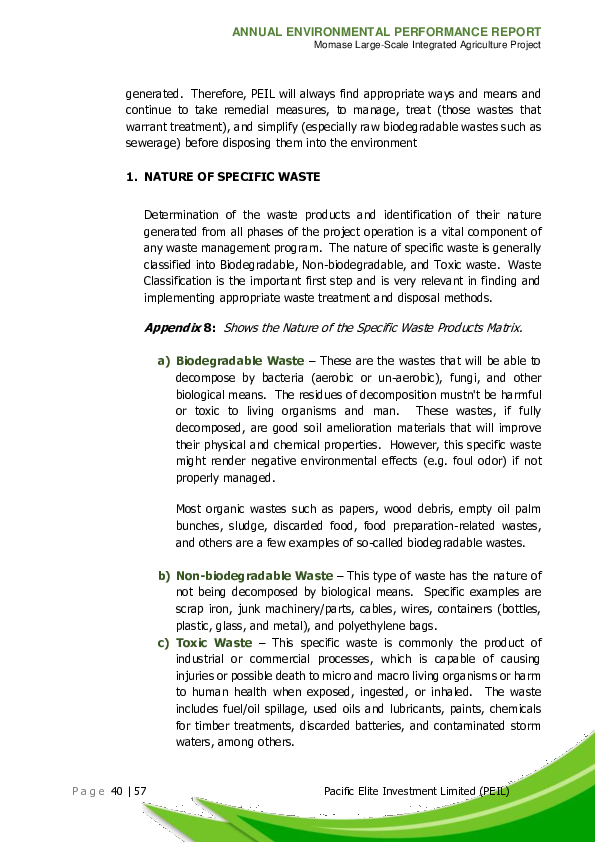
ANNUAL ENVIRONMENTAL PERFORMANCE REPORT
Momase Large-Scale Integrated Agriculture Project
2. METHODS OF WASTE TREATMENT AND DISPOSAL
PEIL employed three methods of Waste Management to handle the
waste products derived from the various operational activities such as
mill/plant & plantation site ground preparation, Staff and Workers
Accommodation, Palm Oil Mill/timber processing plant Construction, and
Operation. The waste treatment methods that were applied include
incineration, surface dumping, wastewater aerobics and anaerobic
settling ponds, and landfills. However, before the disposition of the
different solid waste into the collection bin, the company implemented a
solid waste segregation strategy. At the source, PEIL provided two kinds
of collection bins or rubbish collection areas, one for biodegradable and
another one for non-biodegradable wastes for domestic and workshop
wastes.
a) Incineration Method – This method is simply burning all
combustible waste materials such as plastic bags/wrappers,
cardboard, scratch papers, wood debris (off-cuts, sawdust), used
tires & tubes, and other solid combustible waste materials in a
designated incineration site.
The incineration site was established far from the housing and other
support facilities, villages, and watercourses after considering other
factors such as the wind direction, ground slope, and accessibility.
The incineration site was constructed approximately 100 meters or
more away from the quarters and very far from any villages. It has
an area of about 120m2.
b) Surface Dumping Method – Wastes products such as soil debris,
rocks debris, uncontaminated containers (drums, etc.), metal
scraps/junk machinery, and parts were properly disposed of in the
designated open surface dumping site.
All surface dumping sites were established in a distant place away
from the village, housing, and other support facilities as well as
watercourses. It is also located in a secured and relatively flat area
where water-logging is avoided.
P a g e 41 | 57 Pacific Elite Investment Limited (PEIL)
�
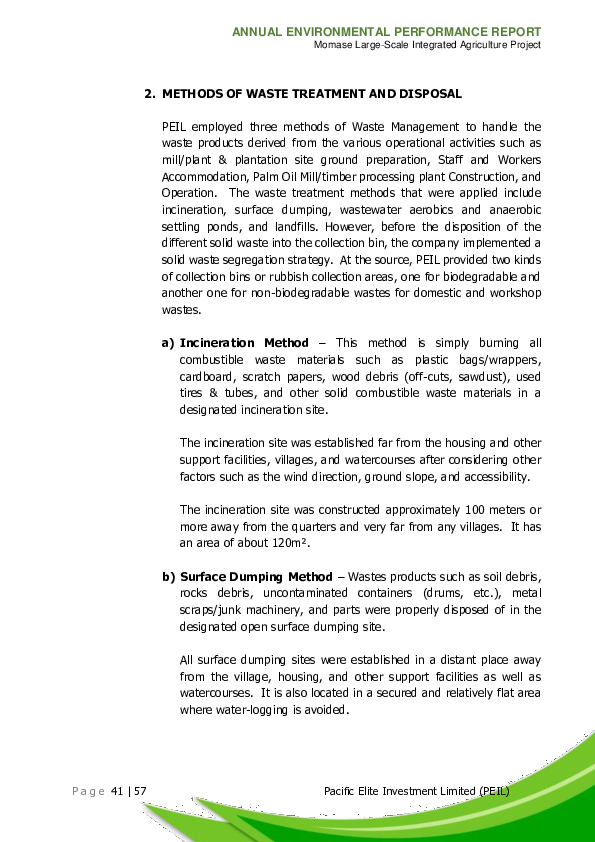
ANNUAL ENVIRONMENTAL PERFORMANCE REPORT
Momase Large-Scale Integrated Agriculture Project
The surface dumping area is 10 meters in width and 10 meters in
length or 100m2 in area which was established adjacent to the
incineration site.
c) Pond Method – Effluent and sludge generated in the Palm Oil Mill
operation comprised of wastewater (washing of FFB and cooking of
fruits), pulp, and residual oil were directed to the series of ponds (a
total of 10 units) (cooling pond, acidification pond, anaerobic pond,
aerobic pond, facultative pond & finally, the settling pond) were
constructed by the company. The size of the pond depends on the
volume of waste and the number of days that these wastes will stay
in the pond during the treatment process.
At the moment, the company has established a 45tonne/hour
capacity upgradable to a 60tonne/hour oil palm mill. Therefore, the
effective waste-holding capacities of the pond to be constructed will
range from 10,800m3 to 18,000m3.
d) Landfill Method – Human waste disposal is based on the landfill
method after the septic tanks are full. Toilets and septic tanks are
constructed as storage of all human wastes such as feces and excreta
and wastes that flow in the kitchen sinks. The staff houses and
workers’ quarter have their respective built-in toilets and septic tanks
for that purpose, hence not indicated as separate buildings.
Several conditions were satisfied during the establishment of the
landfills, as follows:
The area is impermeable to prevent the leaking/seeping of
liquid waste into nearby watercourses (rivers, streams, and
creeks);
It is at least 100 meters from maximum water inundation and
at least 1 meter above maximum groundwater height;
It is not readily flooded during the wet season and heavy rain;
and
The year-round wind direction is away from the inhabitants of
the nearby camps and villages.
P a g e 42 | 57 Pacific Elite Investment Limited (PEIL)
�
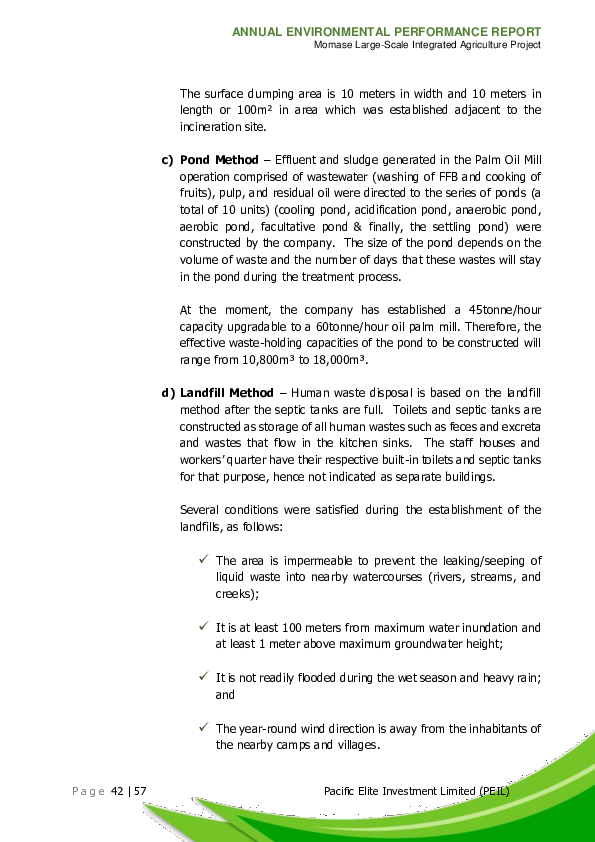
ANNUAL ENVIRONMENTAL PERFORMANCE REPORT
Momase Large-Scale Integrated Agriculture Project
3. POTENTIAL WASTE SOURCES
The activities associated with the Momase Large-scale Integrated
Agriculture Project operations have the potential to generate waste as
follows:
Tree salvaging wastes
Plantation site preparation
Ground preparation for the mill/plant site;
Construction of Palm Oil Mill & timber processing plants;
Base camp/transit camps operations (staff and workers
housing facilities and other support facilities);
Jetty/wharf areas;
Workshops and generator facilities;
Fuel depots and lubricant storage facilities;
Palm oil extraction and processing plant operations;
Timber Downstream Processing Operations and
Landfill, Incineration, and Surface Dumping sites.
The wastes that are generated from these activities consist of solid waste,
liquid waste, gaseous emission, noise emission, and odor emission.
These wastes are further classified into Biodegradable, Non-
biodegradable, or Toxic.
Natural components such as sediments, silts, and other earthly materials
with organic matter are other forms of environmental contaminants.
Rainfall runoff containing sediments is a significant source of waste within
the projects’ operations. Such materials may enter the different water
body networks when their foundations or natural environmental settings
have been disturbed so that their inert bonding is forcefully loosened or
broken up. The quantity of sediments in rainfall-runoff per year is directly
proportional to the amount of annual rainfall of the project site, the timing
of the implementation of different projects’ activities, and the strategies
employed in the control of sedimentation.
Sedimentation and siltation of any given water body are one of the basic
natural causes which often account for severe impacts upon the
environment particularly on aquatic/marine organisms, as well as human
beings living in any part of a given downstream where landslides and
heavy erosion occurred. For instance, too much siltation and high
P a g e 43 | 57 Pacific Elite Investment Limited (PEIL)
�
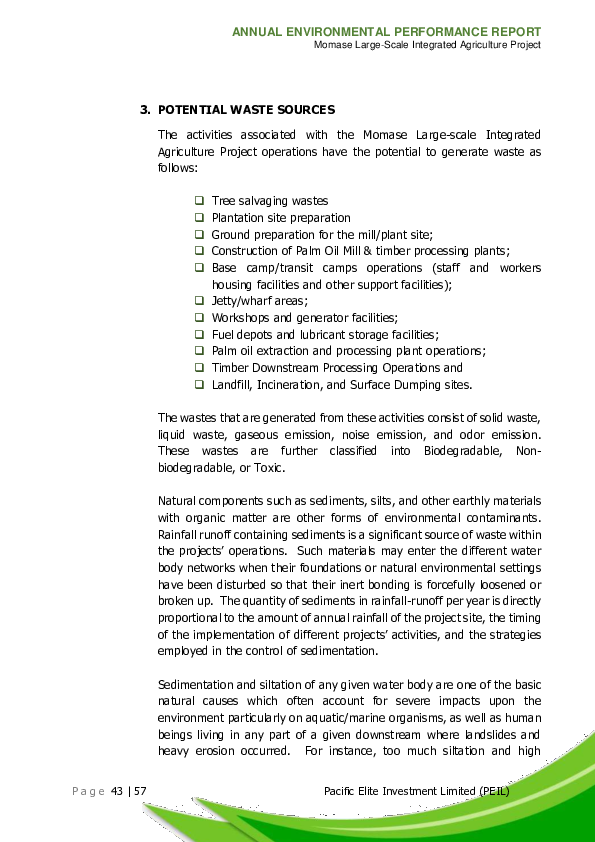
ANNUAL ENVIRONMENTAL PERFORMANCE REPORT
Momase Large-Scale Integrated Agriculture Project
concentration of suspended solids affect the gills of the fish, and
absorbing too much heat from sunlight will result in increased water
temperature and oxidation, eventually resulting in a reduction of fish’s
food sources.
The company and its contractor are well aware of these things and avoid
as much as possible too much extensive disturbance with the natural
environmental settings so that massive soil erosions which contribute to
the heavy sedimentation and pollution of any type of water bodies are
avoided. Hence, proper timing shall be adopted in the conduct of tree
salvaging operation, ground preparation for the mill/plant sites, and
access road network.
To minimize further contamination due to soil erosion, a drainage system
will be built properly to divert and channel the water surface runoff during
heavy rain to vegetated portions to avoid overland flows and flooding,
thereby reducing the severity or degree of erosion.
Wastes generated from the palm oil mill & timber processing plants
construction and operation can also be categorized as Domestic (non-
industrial) Wastes and Industrial Wastes depending on their sources and
characteristics.
a. Domestic Wastes. Domestic wastes mainly refer to sludge, kitchen
waste, refusal, and putrefied waste (mostly food scrap), textiles,
plastic litter, glass/bottles, papers, discarded furniture &
cartons/cardboards, personal hygiene/grooming empty containers,
empty cans, lubricants, laundry & kitchen washed-water, storm
waters, cleaners, pesticides, and sewerage.
These domestic wastes, except for sewerage and washed waters, will
be separated and collected in wet and dry garbage bins and
segregated into biodegradable or non-biodegradable or recyclable,
respectively, before handling and transportation to recommended
disposal sites. The wet garbage and fast biodegradable will be
dumped or buried in pits away from the water courses and residential
areas while the dry garbage shall be disposed at the dump sites or
incinerated away from populations.
As for sewerage, latrines (toilet pits) for the employees will be
respectively dug at sites well away from watercourses at higher
P a g e 44 | 57 Pacific Elite Investment Limited (PEIL)
�
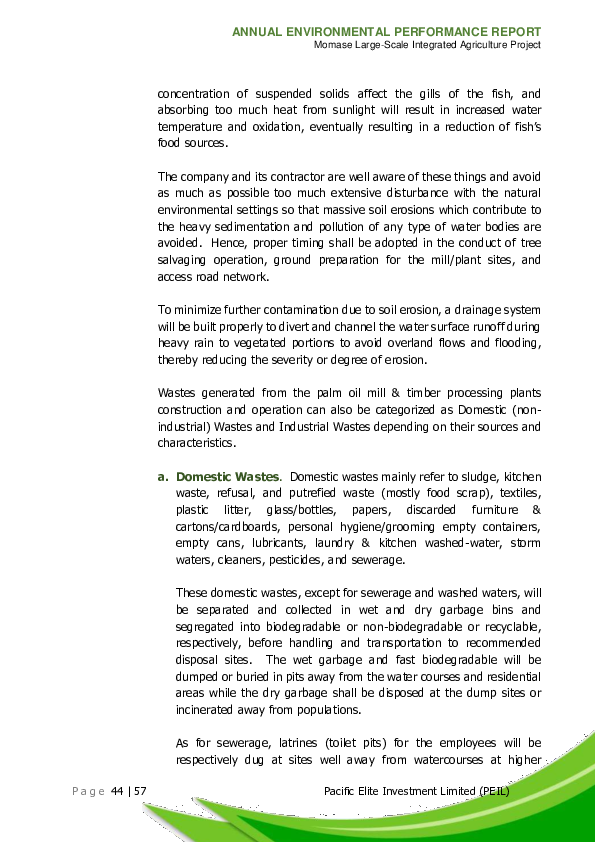
ANNUAL ENVIRONMENTAL PERFORMANCE REPORT
Momase Large-Scale Integrated Agriculture Project
grounds where the water table is not too close to the surface to avoid
contamination of the underground waters. As soon as the pits have
been filled-up (full) with sewerage, they will be covered with soil, and
dig a new pit for use. These latrines will be fortified and covered well
to avoid flooding and prevent pests such as flies, cockroaches,
mosquitoes, and other pathogenic/vector organisms to breed and
thrive in these pits.
Also, septic systems will be put in place for use and de-sludge
whenever they have been filled-up. The de-sludge materials will be
transported away and disposed of in the landfill site.
b. Industrial Wastes. Industrial wastes are the by-products and refuse
generated from tree salvaging and log pond operations, workshops,
fuel depots and lubricants storage facilities, generator set facilities,
palm oil mill and timber processing plants, vehicles, heavy equipment,
and machinery.
These wastes include fuel, oil, and lubricants spillage; waste and used
fuel, oil, and lubricants; used fuel and oil filters; solvents; toxins;
chemical mixture/solutions; pesticides/insecticides; storm waters;
industrial washed-waters; paint residues; discarded equipment and
parts; cleaners; sewerage; empty fruit bunches, palm kernel shells,
mesocarp fibers, sawdust; trimmings/wood off-cuts; slabs; discarded
bolts & nuts; used welding rods; iron rods & scrap metals; batteries;
empty drum & other containers; tires & tubes; and wires & cables.
Those wastes in the liquid state or as mixtures and solutions will be
properly channeled through the use of pipes and drainage systems
into either sewerage treatment ponds (as for sewerage) or septic
systems, and also separate septic systems for the toxic wastes alone.
All toxic wastes such as oils, fuels, treated chemical solutions,
cleaners, paint residues, contaminated storm waters, lubricants, and
other industrial wastewater will be properly contained and, channeled
into separate septic tanks to be collected there for recycling, reuse,
or randomly removed off in a recommended manner to avoid seepage
and accidental pollution.
Appendix 9. Shows the Waste Management Program. It identifies
the sources and the types of waste; the specific waste products; the
waste control, and containment. And minimization strategies; waste
P a g e 45 | 57 Pacific Elite Investment Limited (PEIL)
�
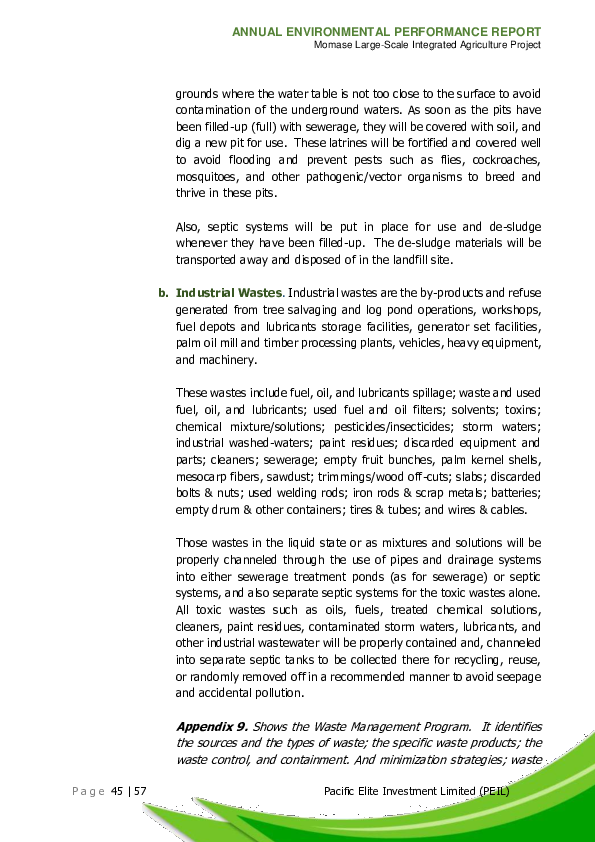
ANNUAL ENVIRONMENTAL PERFORMANCE REPORT
Momase Large-Scale Integrated Agriculture Project
storage and treatment methods; waste handling and transportation;
the final waste disposal method; the waste collection and disposal
frequency; and the responsible personnel for the waste management
implementation.
E. Agrochemicals Management
Agrochemicals {pesticides, hydrogels, plant growth regulators (fertilizers), etc.}
have played a pivotal role in the past in increasing agricultural productivity and
production, and in protecting and preserving human and animal food, feed,
health, and belongings.
The company awareness program plays a vital part in the health of a
progressive society. Both the positive as well as negative effects of chemicals
must be known. In particular, awareness of the shelf and field lives of
chemicals, their quality, use spectrum, disposal, decontamination, handling of
accidental poisoning cases, various antidotes, etc. is paramount.
PEIL Fertilizer Storage PEIL Chemical Storage
CHEMICAL STORAGE
CHEMICAL & LUBRICANT STORE
P a g e 46 | 57 Pacific Elite Investment Limited (PEIL)
�
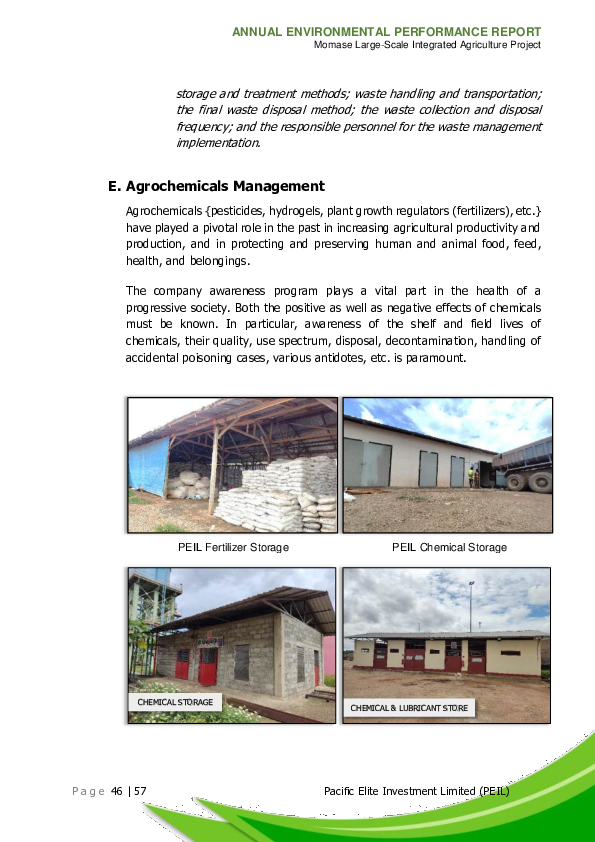
ANNUAL ENVIRONMENTAL PERFORMANCE REPORT
Momase Large-Scale Integrated Agriculture Project
All agrochemicals are pre-mixed at the central chemical storage and taken out
into the plantations. No chemical applications are undertaken during rainy
conditions.
In the intricate dance of palm oil production,
chemicals played a vital role. From fertilizers
that nourished the soil to herbicides that kept
weeds at bay, and pesticides that protected the
delicate palm trees from pests, a myriad of
substances were employed to ensure optimal
growth and yield. However, the handling and
storage of these chemicals were not to be taken
lightly.
Within the sprawling compound of the oil palm
mill, a dedicated storage facility stood sentinel,
its walls adorned with warning signs and safety
protocols. This facility was meticulously
organized, with each chemical stored under
strict guidelines and safety standards.
Ventilation systems hummed softly, ensuring
that noxious fumes were swiftly dispersed, while spill containment measures
stood ready to spring into action at a moment's notice.
The importance of proper chemical storage extended beyond mere regulatory
compliance – it was a matter of environmental stewardship and community
well-being. Any mishap or negligence could spell disaster, contaminating soil,
and waterways, and jeopardizing the health of both workers and nearby
communities.
As the sun dipped low on the horizon, casting a golden hue over the plantation,
the diligent workers of the oil palm mill went about their tasks, their efforts
underpinned by the assurance that the chemicals essential to their trade were
stored safely and securely. In this intricate ecosystem of agriculture and
industry, the importance of chemical storage in the oil palm mill and plantation
could not be overstated – it was the guardian of both prosperity and
sustainability.
P a g e 47 | 57 Pacific Elite Investment Limited (PEIL)
�
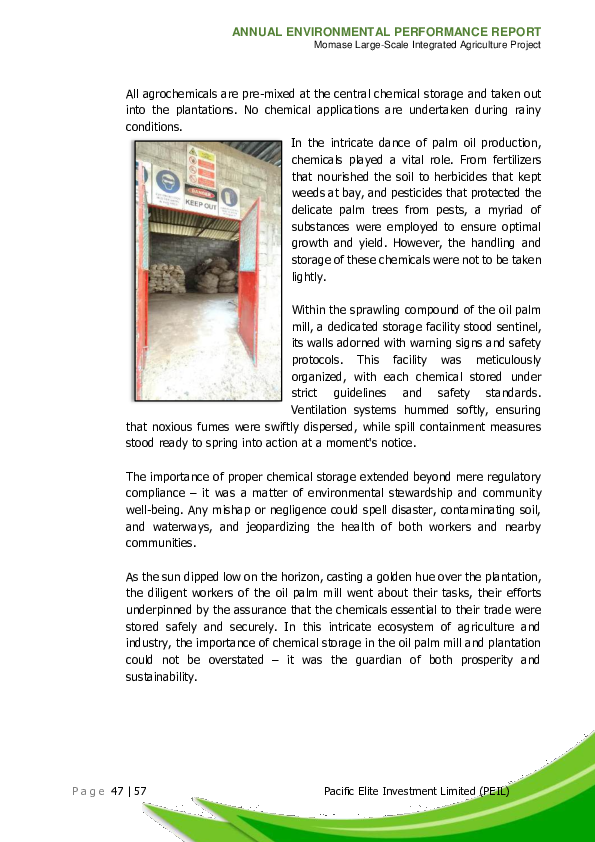
ANNUAL ENVIRONMENTAL PERFORMANCE REPORT
Momase Large-Scale Integrated Agriculture Project
PEIL Chemical Room PEIL Waste Storage
Wash Area in the Chemical Storage
In the relentless battle
against pests and
diseases that threaten
the livelihood of the
plantation, hygiene
reigns supreme.
Contaminated tools
can serve as vectors
for the spread of pathogens, jeopardizing the entire crop. Thus, the wash area
serves as the frontline defense, where every tool is meticulously scrubbed,
disinfected, and inspected for signs of wear.
However, the wash area's significance extends beyond the realm of pest
management. In the quest for optimal yield and quality, precision is paramount.
Each action, no matter how seemingly mundane, carries implications for the
health and productivity of the palm trees. By maintaining a clean and organized
wash area, plantation managers instill a culture of discipline and attention to
detail among their workforce, ensuring that every task is executed with the
utmost care and precision.
P a g e 48 | 57 Pacific Elite Investment Limited (PEIL)
�
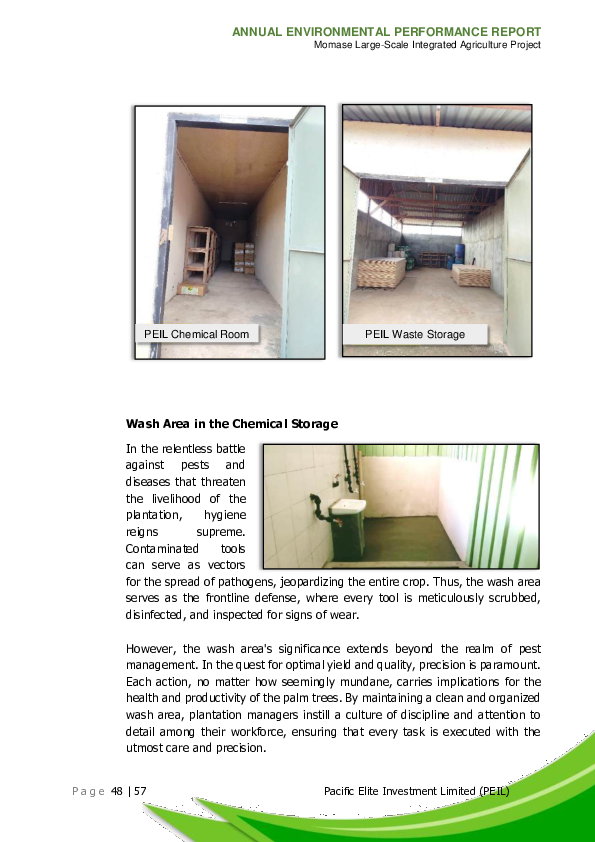
ANNUAL ENVIRONMENTAL PERFORMANCE REPORT
Momase Large-Scale Integrated Agriculture Project
F. Erosion Control Management Plan
When building, amending, or altering property in any way, soil erosion
control is an extremely important practice that can improve land investments
in various ways.
Not only is soil
erosion control
important to
maintain the health
of local and global
waterways, but
proper control can
also sustain and
improve crop yields,
reduce drainage
costs, retain
nutrients when
applied, and reduce
hazards of eroding
soil.
Our operations are located in areas that are flat as well as hilly/mountainous
and prone to heavy rainfall and erosion.
The objective of our Soil Erosion Management Plan is to identify and manage
prone areas, take remedial measures to prevent and minimize erosion and
monitor these areas regularly for signs of soil erosion. We have categorized all
erosion-prone areas to comply with the requirements of the PNG logging code
of practice, thus no planting on slopes of more than 25 degrees is carried out.
Table 8: Slope Gradients and Elevation.
Slopes Percentage Description
2 – 6 degrees 4 – 10 Platforms required in some places
6 – 12 degrees 10 – 20 Platforms optional
12 – 20 degrees 20 – 40 Platforms required
20 – 25 degrees 40 – 50 Terracing required
>25 degrees >50 No planting Oil Palm
P a g e 49 | 57 Pacific Elite Investment Limited (PEIL)
�
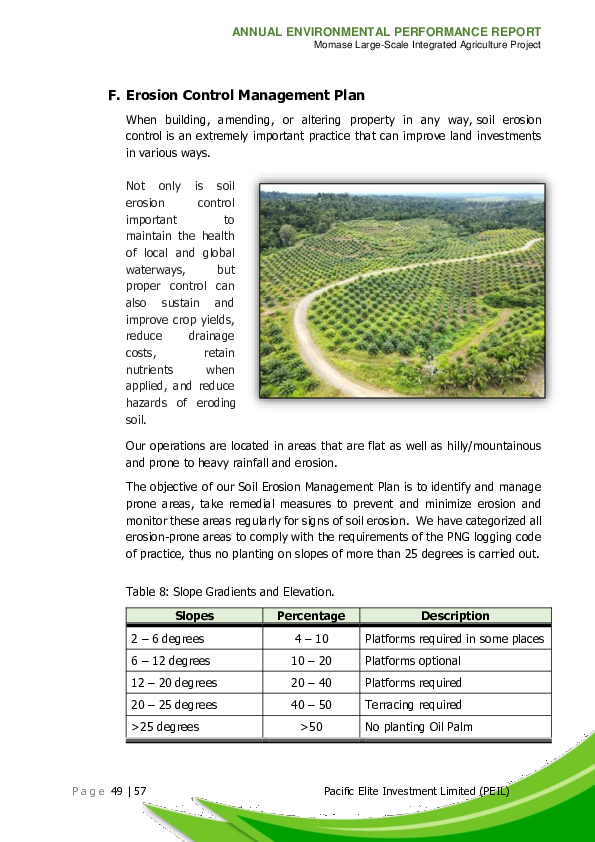
ANNUAL ENVIRONMENTAL PERFORMANCE REPORT
Momase Large-Scale Integrated Agriculture Project
PEIL shall undertake preventive measures to avoid and minimize soil erosion
and sedimentation to the opened/denuded areas, steep slopes, and side-cut
portions due to road construction and plantation development. It should be
kept stable by conserving and protecting the vegetation by replanting with
suitable tree species and cover crops (e.g. Muccuna spp., Pueraria spp., and
Calopogonium spp.)
We have a monitoring program in place for continuous checks on cover crops,
frond stacking/aligning, and slope terracing to minimize erosion.
Tetraced Area (Mucuna cover crop)
Tetraced Area
(Mucuna cover crop)
P a g e 50 | 57 Pacific Elite Investment Limited (PEIL)
�
ANNUAL ENVIRONMENTAL PERFORMANCE REPORT
Momase Large-Scale Integrated Agriculture Project
III. CONCLUSION
The conclusion of the report highlights PEIL's dedication to sustainable
development, aligning with its Environmental Policy by emphasizing pollution
prevention, ongoing enhancement, and adherence to legal requirements as
fundamental to its operations.
In reviewing the company's environmental performance for 2022 and 2023, it is
evident that PEIL has diligently met its legal and regulatory obligations, as outlined
in its Environmental Permit and EMP sanctioned by the Conservation and
Environment Protection Authority (CEPA).
While most sites maintained water extraction and waste discharge within
permissible limits, there remains a commitment to further enhance compliance
where needed. Challenges in water sampling and analysis, attributed to logistical
delays, have been acknowledged, prompting proactive measures such as the
acquisition and installation of new equipment to streamline processes.
PEIL's role as a significant contributor to the sustainable palm oil market
underscores its dedication to minimizing adverse impacts and fostering
environmental preservation. Moving forward, the company pledges to continue
advancing its performance and collaborate with industry peers, stakeholders, and
regulatory bodies to ensure the long-term sustainability of the sector.
IV. WASTE MANAGEMENT PROGRAM
A. Waste Management Program Component
The waste management program comprises eight components such as:
Identification of Sources and Types of Waste
Identification of Specific Waste Products
Waste Control, Containment, and Minimization Action
Waste Storage and Treatment Method
Waste Handling and Transportation Methods
Final Waste Disposal Method
Collection and Disposal Frequency
Responsible Personnel
Appendix 7. Shows the detailed waste management program.
P a g e 51 | 57 Pacific Elite Investment Limited (PEIL)
�

ANNUAL ENVIRONMENTAL PERFORMANCE REPORT
Momase Large-Scale Integrated Agriculture Project
B. Waste Management for the specific Environmental Issues
The project particularly identifies environmental issues generated from different
phases of operation of the timber processing plant and other support/related
activities, which are necessary to address in a waste management plan.
The following environmental issues are:
Air Related Issues- these are waste gaseous emissions from fuel
spillage, the product of incomplete combustion, dust, and particulate.
Water Borne Pollutants - these are wastewater containing oil, fuel,
solvents, wash water from the workshop, timber processing plants, kiln
dryers, boiler plant, and other processing plants, suspended solids such
as dirt, soil, solid waste deposits, and contaminated stormwater.
Liquid Waste Issues - These are waste lube oil, fuel, hydraulic oils,
chemical spillage, and other hydrocarbon products.
Solid Waste Issues - these are logs, lumber, empty fruit bunches,
palm fibers, palm kernel shells, broken mechanical parts, packaging from
parts and equipment, tires, fan belts, other rubber parts, discarded
batteries, contaminated absorbents, and filtered wastes.
Noise Pollution - This is a noise emission coming particularly from the
sawmill, boiler plant, and workshop operations.
C. Methods of Waste Disposal and Treatment
The Company will employ four methods of waste management to handle the
waste products derived from all phases of the palm oil mill & timber processing
operation. The methods include incineration, landfill disposal, surface dumping,
and waste recycling.
1. Incineration Method
This method is simply burning all combustible waste materials such as
cardboard, scratch papers, and others in a designated area. The
incineration site must be established far from the housing facility, office,
villages, and watercourses after considering other factors such as the wind
direction, slope of the ground, and accessibility.
2. Landfill Method
This method is mainly disposing of all waste products such as contaminated
soils, sediments, petro-chemical (oil, grease/lubricant, and fuel), aid post
wastes (bandages, medicine bottles, and others) bottles, glasses, cans,
P a g e 52 | 57 Pacific Elite Investment Limited (PEIL)
�
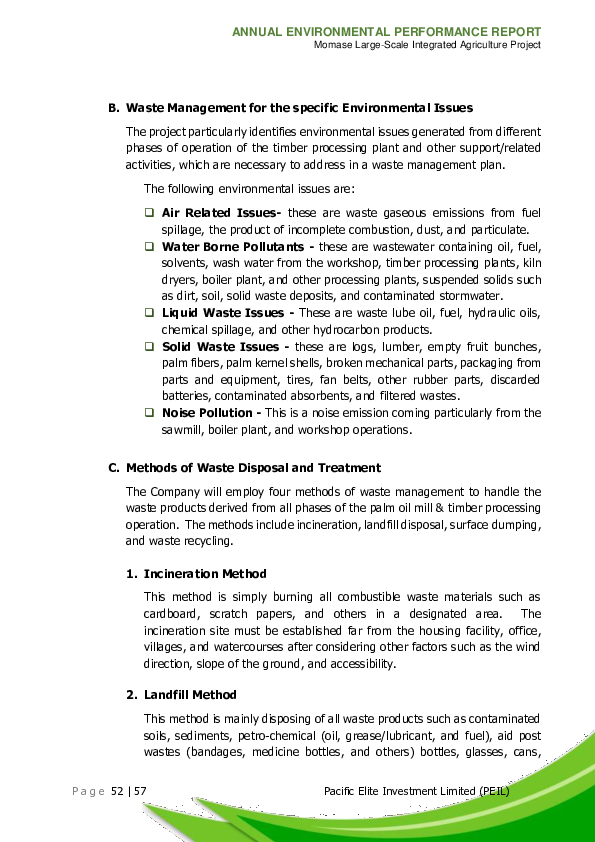
ANNUAL ENVIRONMENTAL PERFORMANCE REPORT
Momase Large-Scale Integrated Agriculture Project
batteries, plastic wrappers, and domestic wastes (kitchen and household
waste) in a proper landfill site far from the worker's housing facilities,
villages, and watercourses. In this method of disposal, the decomposing
dumped waste materials are preferably covered with soil to prevent the
emission of foul odor and to keep them from insects (mosquitoes, flies, etc.)
as well as scavenger animals such as rats and dogs which are considered
as a disease vector. Human waste disposal is also based on the landfill
method by constructing a landfill for toilets and septic tanks as storage of
all human waste such as feces and excreta. The landfill site must be located
one or two kilometers from the housing facilities, offices, villages, and
watercourses. Several conditions should be considered when establishing
landfills, viz:
It is impermeable to prevent the leaking/sipping of liquid waste to
nearby watercourses (rivers, streams, and creeks);
It is at least 100m from maximum inundation by water and at least
1m above maximum groundwater height;
It is not easily flooded during the wet season and heavy rain; and
It is not favorable to wind direction toward inhabitants of the
nearby village and housing facility.
Two landfill sites will be established, i.e. one for each biodegradable and
non-biodegradable waste material which should be separately sorted and
dumped accordingly.
3. Surface Dumping
Waste products such as soil debris, rock debris, uncontaminated containers
(drums, etc.), tires, and metal scraps/junk machinery and parts are properly
disposed of in an open designated surface dumping site. All surface
dumping sites must be established in a distant area from the villages,
workers’ housing facilities, and watercourses. If necessary, it should be
located in a secured and elevated area where waterlogging does not occur.
P a g e 53 | 57 Pacific Elite Investment Limited (PEIL)
�
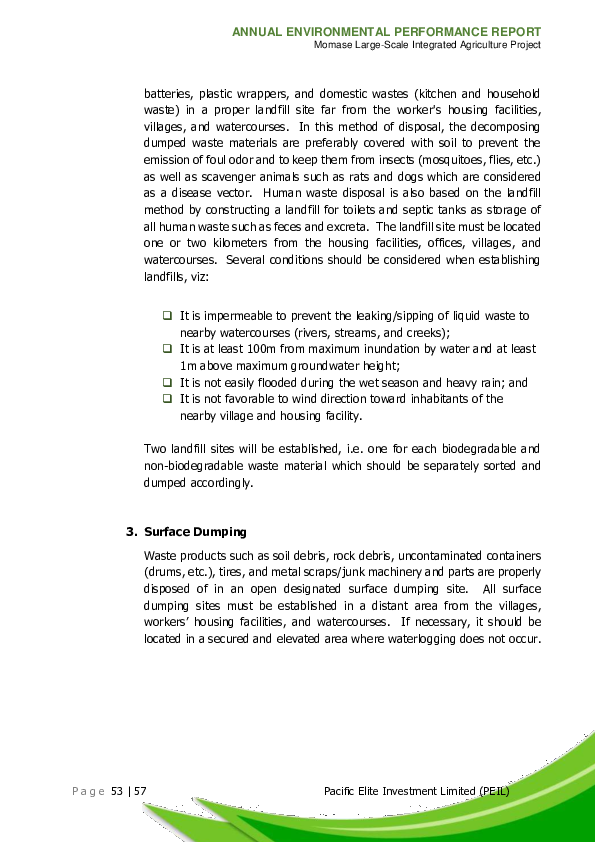
ANNUAL ENVIRONMENTAL PERFORMANCE REPORT
Momase Large-Scale Integrated Agriculture Project
Table 9. PEIL list of disposal sites.
Disposal Sites Qty. Dimension Location
Landfill 2 5m x 5m x 2m Approximately two
kilometers away from
the industrial site
Surface Dumping 1 10m x 30m Approximately two
Area kilometers away from
the industrial site
Incineration Site 1 10 x 20m x 1m Approximately two
kilometers away from
the industrial site
Proposed Concrete 1 20m x 20 m x 0.5 Approximately 300
Bund for Chemical m meters away from the
Storage Area river.
4. Waste Recycling Method
The project is designed to fully utilize all wood waste products generated
from all phases of the timber processing operation and solid wastes in palm
oil extraction. All waste products will be used as fuel for the boiler plant to
generate electricity for the Oil Palm Mill plant power (refer to Appendix
5). The objective of the project is to attain optimum utilization of wood
waste products.
D. Emergency Action Measures
Non-routine incidents like fuel and oil spillage and damage to the area are
highly considered in this waste management plan. Since this type of incident
demands priority, Emergency Action Measures (EAM) are developed to control
or contain the possible damage.
NON-ROUTINE REMEDIAL/CONTINGENCY RESPONSIBLE
INCIDENTS MEASURES PERSONNEL
Fuel and oil Spillage Provide temporary containers (empty Coordinated effort
drums) beneath all outlets/faucets and among the Workshop
check valves of the fuel depot and oil Supervisor, EMO,
container to prevent and/or minimize Sawmill/plywood plant,
spillage. palm oil mill Manager.
P a g e 54 | 57 Pacific Elite Investment Limited (PEIL)
�
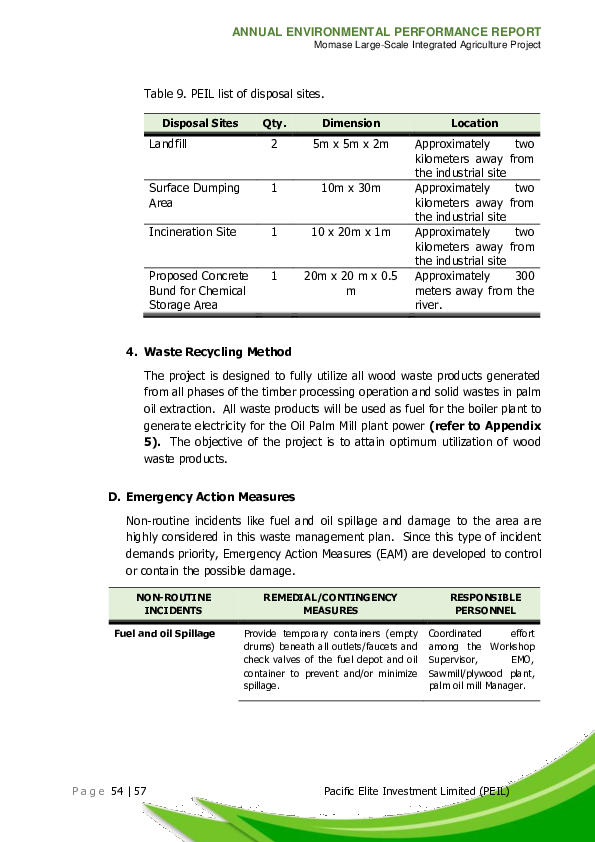
ANNUAL ENVIRONMENTAL PERFORMANCE REPORT
Momase Large-Scale Integrated Agriculture Project
NON-ROUTINE REMEDIAL/CONTINGENCY RESPONSIBLE
INCIDENTS MEASURES PERSONNEL
In case of spillage (fuel and oil), dilution
and detoxification must be done with Spearheaded by EMO
water to reduce the risk of fire and
toxicity, and to control the degradation
of water quality, damage to freshwater
life, and contamination of soil.
If possible, manually collect spillage of Spearheaded by EMO
fuel and oil using a container or using a
suction pump. Immediately make a pit
and direct the flow of spills to it as a
temporary storage while the manual
collection has to be continued and fully
undertaken. Another alternative is, if
the spill is not much, cover it with
sawdust so that it will be absorbed thus
preventing the flow to the nearby river,
stream, and other body of water or the
infiltration of the spills into the soil and
into the underground water table which
connect to the nearby watercourse.
The spill might damage the freshwater
life and its habitat. However, the
sawdust must be hauled immediately
and used for fuel in the boiler plant.
Fuel and oil Spillage Always check all depot pipelines, Spearheaded by EMO
faucets, and valves to ensure the
operational condition of the facility.
Concrete bunding for fuel and oil Sawmill/plywood plant
storage shall be provided to contain & palm oil mill Manager
spillage. Store large quantities of fuel
at a main depot. The concept is to
easily handle any spillage occurrence in
a confined area away from any
protected site and watercourse.
Fire Occurrence Provide fire extinguishers at strategic Sawmill/plywood plant
locations in all fire-prone areas such as & palm oil mill Manager
workshops, offices, kitchens, boiler and EMO
plants, sawmill/plywood plants, mill
site, and other areas.
Orient and train workmen on what to do EMO
in case of a fire incident in all identified
fire-prone areas by using fire
extinguishers and other firefighting
devices.
P a g e 55 | 57 Pacific Elite Investment Limited (PEIL)
�
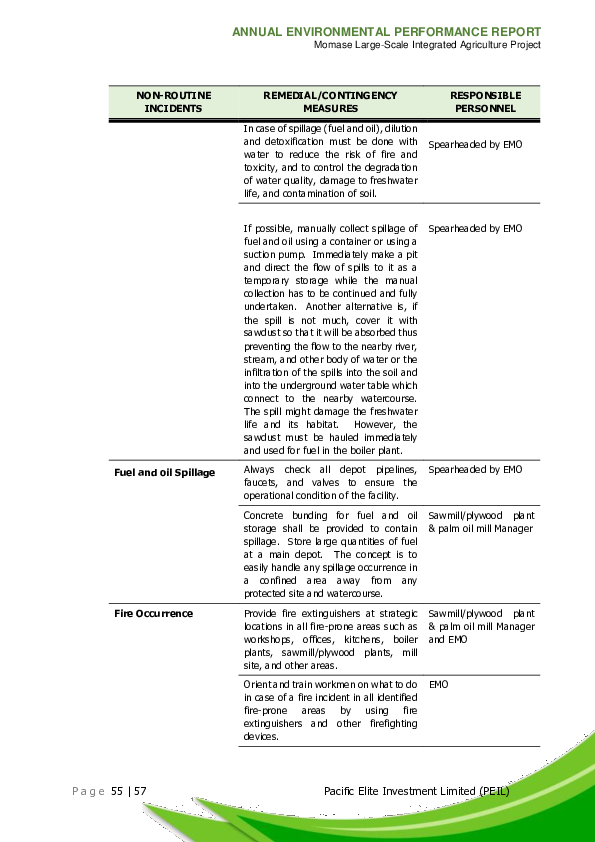
ANNUAL ENVIRONMENTAL PERFORMANCE REPORT
Momase Large-Scale Integrated Agriculture Project
NON-ROUTINE REMEDIAL/CONTINGENCY RESPONSIBLE
INCIDENTS MEASURES PERSONNEL
If possible, provide a ready water tank Sawmill Manager
to be used in case of a fire incident.
NON-ROUTINE RESPONSIBLE
REMEDIAL/CONTINGENCY MEASURES
INCIDENTS PERSONNEL
Disturbance and Strictly comply with the establishment of the EMO
Damage of 50-m buffer zone in the protected
Protected watercourse.
Watercourse
Conduct seminar orientation for all concerned EMO in
sawmill workers relative to the protection of coordination with
the environment particularly on the identified the Sawmill/
site. plywood plant &
palm oil mill
Manager
If the damage is done, immediately evaluate EMO and Sawmill/
the damage in coordination with the plywood plant &
Landowners or representative to resolve the palm oil mill
problem. After evaluation, implement a Manager
rehabilitation program.
Factory Accident Orient all factory workers relative to a safe EMO or Safety
like Physical working attitude. Emphasize the importance Officer
injuries, and other of safety in all areas of operation.
work-related
incidents Provide a Medical Doctor at the project site to Sawmill/plywood
immediately avoid any work-related accident. plant & palm oil
mill Manager
E. Personnel and Staff Support
The Company shall employ an Environmental Management Officer (EMO) who
will handle the implementation of the WMP and other related environmental
requirements imposed by the government.
1. Training and Staff Welfare
The management will be responsible for providing all preventive and
precautionary health measures to safeguard the health and safety of every
employee working on the plantation and in the mill facility. Workers and staff
are given the necessary safety equipment, supplies, and first aid for their
P a g e 56 | 57 Pacific Elite Investment Limited (PEIL)
�
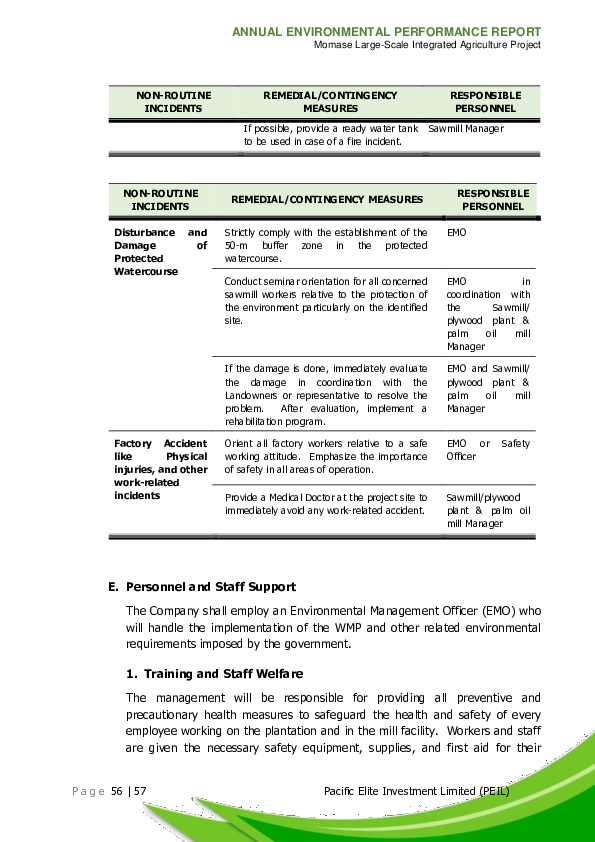
ANNUAL ENVIRONMENTAL PERFORMANCE REPORT
Momase Large-Scale Integrated Agriculture Project
protection while at work. Employees will receive appropriate instruction to
guarantee their safety and give them the tools they need for the job. Before
starting the actual work on any new task, the company always gives the
personnel assigned to it on-the-job training through practical demonstration.
Before being given tasks to do alone, recruits receive hands-on training from
more experienced personnel.
V. COMMITMENTS
Pacific Elite Investment Limited (PEIL), along with its contractor, was
resolute in maintaining strict control and execution of the Waste Management
Plan (WMP) under the Environmental Laws of Papua New Guinea. Collaborating
closely with the Conservation and Environmental Protection Authority (CEPA),
their primary aim was to uphold environmental quality and prevent pollution.
Believing firmly that any large-scale development must align with environmental
protection and conservation, the company was committed to safeguarding the
natural environment. PEIL pledged to preserve environmental quality consistently,
taking corrective action in areas where alterations had been made. Their
paramount goal was to protect and nurture the natural environment, ensuring the
preservation of its diverse species, breathtaking landscapes, and scenic beauty
for both present and future generations to enjoy.
Central to their approach was the concept of development harmonizing with
environmental conservation, embedded within PEIL's sustainability endeavors.
The company vowed to integrate conservation programs into its operations,
striving for sustainable development.
To translate these aspirations into reality and effectively achieve their objectives,
PEIL intended to enlist the expertise of an environmental specialist/officer. This
individual would be responsible for overseeing environmental monitoring,
assessment, and the implementation of the Environment Management Plan.
Additionally, they would ensure compliance with environmental regulations
imposed by relevant authorities such as the Department of Agriculture and
Livestock, PNG Forest Authority, and CEPA.
P a g e 57 | 57 Pacific Elite Investment Limited (PEIL)
�
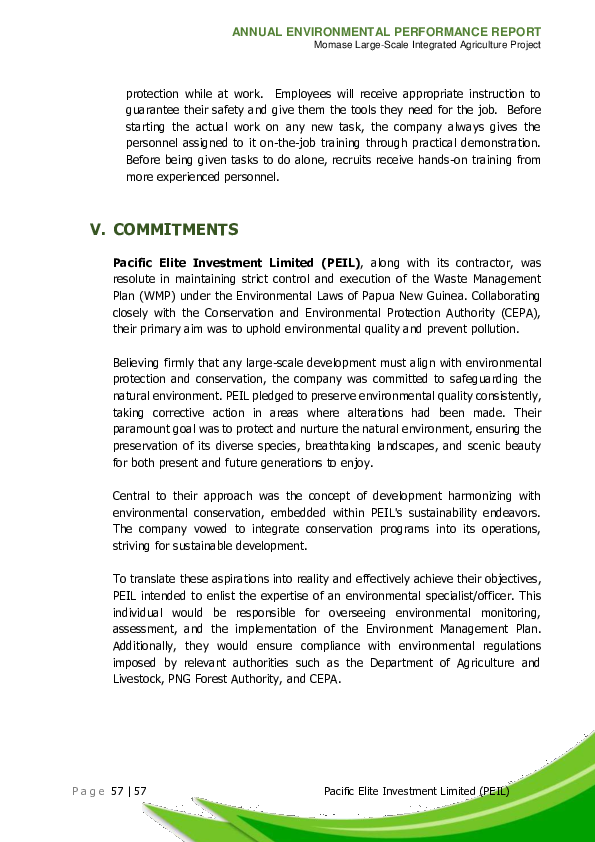
Momase Large Scale Integrated Agriculture Project APPENDIX 1.A
Pacific Elite Investment Limited
EXTRACTION POINT
COORDINATES Ave Monthly Yearly (M3)
EP# SOURCE WATER USE LOCATION/SITE
Northing Easting (cu.m.) (cu.m.)
Industrial &
1 Sepik River Plywood Mill - (KPL) 9 537 951 808 230 5,515.00 66,180.00
Domestic use
2 Urr-u Creek (Pongi) Industrial Use Oil Palm Mill-SPOL 9 542 754 801 748 4,985.25 59,823.00
3 Pond Domestic Use Turubu Township-Parua 9 566 472 806 659 92.79 1,113.48
4 Pond Domestic Use Kenyare Compound 9 572 491 808 846 45.18 542.16
5 Mawit Creek (Brinangat) Domestic Use Mawit Basecamp 9 586 246 807 251 25.15 301.80
6 Urr-u Creek (Pongi) Irrigation Use Ibap Nursery 9 561 011 801 073 13.20 158.40
�
Momase Large Scale Integrated Agriculture Project APPENDIX 1.B
Pacific Elite Investment Limited
DISCHARGE POINT
COORDINATES Monthly Yearly (M3)
DP# WASTE NATURE OF WASTE SOURCE LOCATION/SITE
Northing Easting (cu.m.) (cu.m.)
All waste containing waste oil
1 Industrial Waste water Sepik River Plywood Mill - (KPL) 9 537 943 808 158 4,585.10 55,021.20
film/hydrocarbons inclusive of run-off
Waste water from the plantation is Urr-u Creek
2 Due to plantation development Oil Palm Mill - SPOL 9 542 754 801 748 750.12 9,001.44
discharge into the environment (Pongi)
Waste water from the plantation is
3 Due to plantation development Nagam River Oil Palm Mill - SPOL 9 541 636 803 532 924.59 11,095.08
discharge into the environment
Waste water from the plantation is
4 Due to plantation development Urr-u Creek Ibap Nursery 9 560 995 810 094 13.44 161.28
discharge into the environment
Waste water from the plantation is Mundo-mundo
5 Due to plantation development Wangay Creek 9 557 720 811 831 419.45 5,033.40
discharge into the environment junction Kambrendo
Waste water from the mill is discharged
6 Treated Mill Effluent (POME) Pond Oil Palm Mill - SPOL 9 542 934 802 952 2,965.00 35,580.00
into the environment
�
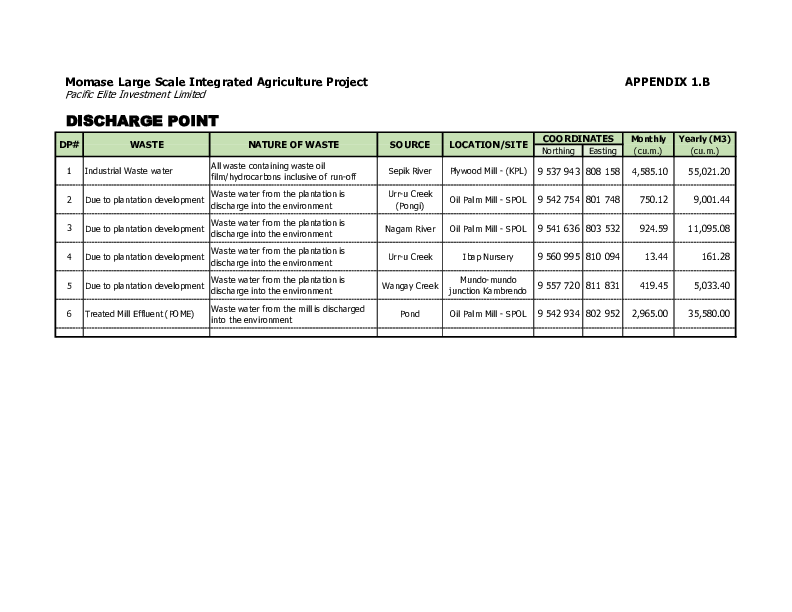
Momase Large Scale Integrated Agriculture Project APPENDIX 2
Pacific Elite Investment Limited
Oil Palm Mill (FFB Procesing - Solid Waste Generation)
PARTICULARS QTY JAN FEB MAR APR MAY JUN JUL AUG SEP OCT NOV DEC TOTAL
1 ENERGY INPUT Mt
FFB Processed Mt 6,821.40 5,965.15 7,308.16 6,023.95 6,522.82 4,748.61 2,812.99 4,074.82 6,807.00 9,389.75 9,684.48 7,799.17 77,958.30
Fiber (16%) Mt 1,091.42 954.42 1,169.31 963.83 1,043.65 759.78 450.08 651.97 1,089.12 1,502.36 1,549.52 1,247.87 12,473.33
Shell (4%) Mt 272.86 238.61 292.33 240.96 260.91 189.94 112.52 162.99 272.28 375.59 387.38 311.97 3,118.33
Empty Fruit Bunch (23%) Mt 1,568.92 1,371.98 1,680.88 1,385.51 1,500.25 1,092.18 646.99 937.21 1,565.61 2,159.64 2,227.43 1,793.81 17,930.41
Impurities (sand & etc)
Mt 68.21 59.65 73.08 60.24 65.23 47.49 28.13 40.75 68.07 93.90 96.84 77.99 779.58
(1%)
TOTAL Mt 9,822.82 8,589.82 10,523.75 8,674.49 9,392.86 6,838.00 4,050.71 5,867.74 9,802.08 13,521.24 13,945.65 11,230.80 112,259.95
�
Momase Large Scale Integrated Agriculture Project APPENDIX 3
Pacific Elite Investment Limited
WASTE WATER DATA (POME) ANALYSIS
First Quarter Second Quarter Third Quarter Fourth Quarter
PNG LEGAL GRAND
PLANT EFFLUENT
SEPT
MAR
NOV
MAY
AUG
OCT
DEC
APR
JUN
JAN
FEB
JUL
LIMIT TOTAL
Oil Palm Mill (SPOL)
FFB Processed mt 77,958.30 6,821.40 5,965.15 7,308.16 6,023.95 6,522.82 4,748.61 2,812.99 4,074.82 6,807.00 9,389.75 9,684.48 7,799.17
CPO produced mt 17,930.41 1,568.92 1,371.98 1,680.88 1,385.51 1,500.25 1,092.18 646.99 937.21 1,565.61 2,159.64 2,227.43 1,793.81
Discharged to Land (LA) Gully Pond 5 10 LA LA LA LA LA LA LA LA LA LA LA LA
Total hrs. discharged Hrs. 1,732 151.59 132.56 162.40 133.87 144.95 105.52 62.51 90.55 151.27 208.66 215.21 173.31
Total Volume discharged m3 142,560 61,636 5,393.17 4,716.20 5,778.01 4,762.69 5,157.10 3,754.37 2,224.02 3,221.65 5,381.78 7,423.77 7,656.79 6,166.22
Potential of Hydrogen (pH) 9< >5 8.70 9.00 8.95 9.88 8.90 7.98 8.00 8.27 8.53 8.54 9.00 8.40 8.90
Oil and Grease <50 35.67 38.00 35.00 37.00 37.00 35.00 31.00 37.00 37.00 39.00 31.00 33.00 38.00
Total Solid Suspended 1,500 12.50 12.00 10.00 13.00 15.00 11.00 10.00 17.00 12.00 8.00 18.00 14.00 10.00
Temperature °c >2 19.60 19.60 20.11 19.03 20.15 20.17 18.99 19.17 20.10 18.98 19.80 19.60 19.45
Mill Effluent discharged m3 129600 56,033 4,902.88 4,287.45 5,252.74 4,329.71 4,688.28 3,413.06 2,021.84 2,928.78 4,892.53 6,748.88 6,960.72 5,605.65
�
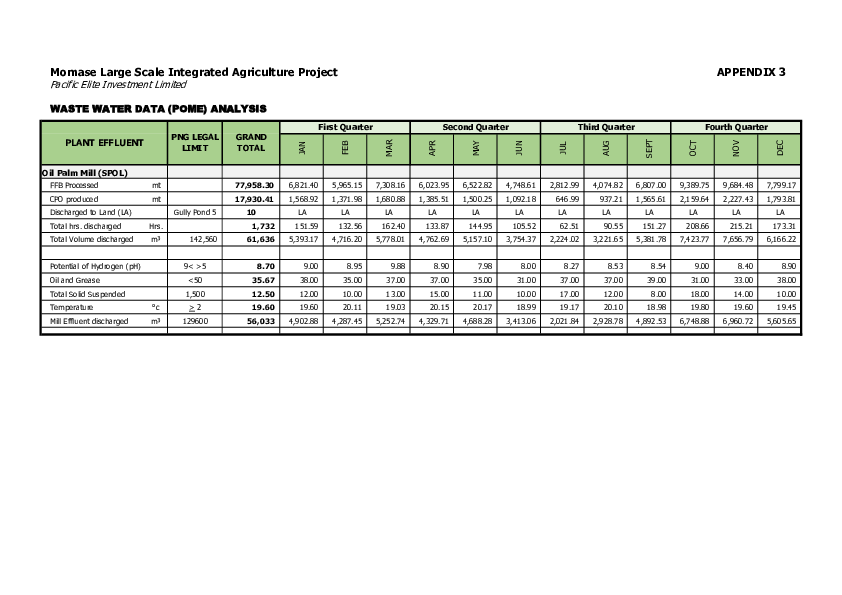
Momase Large Scale Integrated Agriculture Project
Pacific Elite Investment Limited
ENERGY GENERATION APPENDIX 4
First Quarter Second Quarter Third Quarter Fourth Quarter
LOCATION UNIT TOTAL REMARKS
SEPT
MAR
MAY
NOV
AUG
APR
DEC
OCT
JUN
JAN
FEB
JUL
Oil Palm Mill (SPOL) 449,500 406,000 449,500 435,000 449,500 435,000 449,500 449,500 435,000 449,500 435,000 449,500 5,292,500
Genset 1 (200 kw) ltrs 170,500 154,000 170,500 165,000 170,500 165,000 170,500 170,500 165,000 170,500 165,000 170,500 2,007,500
Genset 2 (400 kw) ltrs 139,500 126,000 139,500 135,000 139,500 135,000 139,500 139,500 135,000 139,500 135,000 139,500 1,642,500
Genset 3 (400 kw) ltrs 139,500 126,000 139,500 135,000 139,500 135,000 139,500 139,500 135,000 139,500 135,000 139,500 1,642,500
Plywood Mill - (KPL) 325,500 294,000 325,500 315,000 325,500 315,000 325,500 325,500 315,000 325,500 315,000 325,500 2,555,000
Genset 1 ltrs 108,500 98,000 108,500 105,000 108,500 105,000 108,500 108,500 105,000 108,500 105,000 108,500 1,277,500
Genset 2 ltrs 108,500 98,000 108,500 105,000 108,500 105,000 108,500 108,500 105,000 108,500 105,000 108,500 1,277,500
Genset 3 ltrs 108,500 98,000 108,500 105,000 108,500 105,000 108,500 108,500 105,000 108,500 105,000 108,500 1,277,500
Genset 4 ltrs - - - - - - - - - - - - - Under maintenance
Electricity Generated by Genset - diesel driven (Non-renewable energy)
Turubu Township-Parua 6,231 5,544 5,952 5,940 6,107 5,670 6,169 6,138 5,850 5,952 5,940 6,386 71,879
Genset 1 (Day) ltrs 4,123 3,668 4,030 3,930 4,092 3,870 4,092 4,030 3,960 3,968 3,990 4,216 47,969 (12 hrs)
Genset 2 (Night) ltrs 2,108 1,876 1,922 2,010 2,015 1,800 2,077 2,108 1,890 1,984 1,950 2,170 23,910 (12 hrs)
Ibap Nursery 4,030 3,640 4,030 3,900 4,030 3,900 4,340 4,340 4,200 4,340 4,200 4,340 49,290
Genset 1 ltrs 4,030 3,640 4,030 3,900 4,030 3,900 4,340 4,340 4,200 4,340 4,200 4,340 49,290 For water pump
Mundo-mundo Estate 6,045 5,400 6,510 5,550 6,200 6,300 5,425 6,045 5,550 6,200 5,700 6,510 71,435
Genset 1 ltrs 6,045 5,400 6,510 5,550 6,200 6,300 5,425 6,045 5,550 6,200 5,700 6,510 71,435 (20 hrs)
Kenyare Compound 2,790 3,300 3,100 3,000 2,945 3,000 3,100 3,720 3,600 3,720 3,600 3,720 39,595
Genset 1 ltrs 2,790 3,300 3,100 3,000 2,945 3,000 3,100 3,720 3,600 3,720 3,600 3,720 39,595 (20 hrs)
Page 1
�
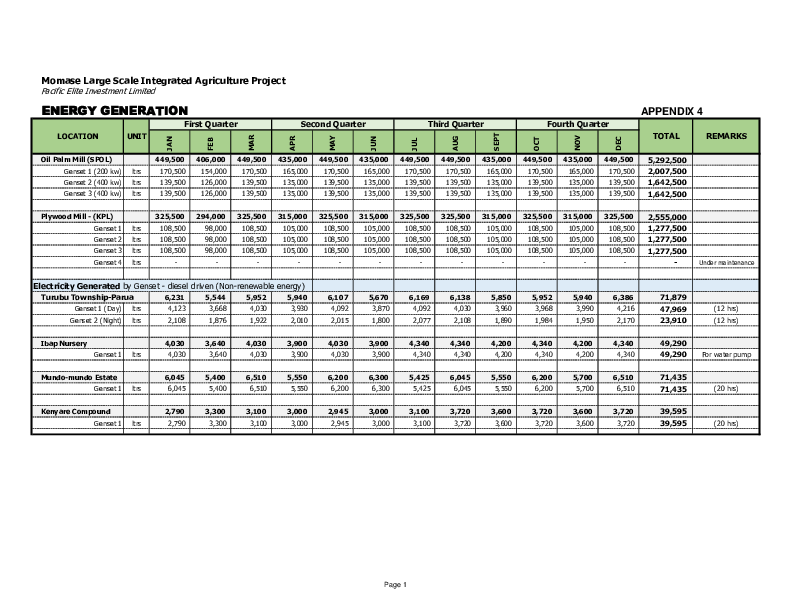
Momase Large Scale Integrated Agriculture Project
Pacific Elite Investment Limited
PROJECT WASTE MANAGEMENT APPENDIX 5
First Quarter Second Quarter Third Quarter Fourth Quarter
LOCATION UNIT TOTAL REMARKS
SEPT
MAR
MAY
NOV
AUG
APR
OCT
DEC
JUN
JAN
FEB
JUL
Oil Palm Mill (SPOL)
Paper kg 5.25 9.01 6.22 10.23 5.25 8.40 3.55 7.45 5.95 3.44 7.32 5.89 77.96
Metal kg 30.44 25.20 38.10 10.15 - 15.20 20.63 20.14 22.80 25.45 29.10 26.20 263.41
Glass kg 5.45 3.90 5.00 - 7.45 9.50 4.20 2.25 1.12 4.10 - 4.45 47.42
Organic waste kg 21.44 20.15 10.25 15.25 23.58 21.47 20.49 24.87 21.23 22.87 23.45 21.15 246.20
Hazardous waste kg 19.11 18.79 11.29 23.57 12.49 19.23 21.45 16.45 23.10 21.50 10.12 12.39 209.49
Plywood Plant (KPL)
Paper kg 4.25 6.14 5.45 4.63 4.87 10.45 3.22 4.55 3.10 6.80 5.79 5.81 65.06
Metal kg 21.15 25.74 24.1 - 10.45 20.21 - 22.39 20.26 23.45 16.54 21.22 205.51
Glass kg 5.87 5.4 - 5.88 3.69 5.88 - 2.51 - 5.43 2.59 - 37.25
Organic waste kg 6.55 11.10 1.50 - 5.87 6.45 5.88 10.14 10.25 6.10 6.25 - 70.09
Hazardous waste kg 13.10 10.84 - 7.89 10.05 6.78 10.47 6.80 7.55 14.20 10.45 5.44 103.57
Ibap Nursery
Organic waste kg 11.23 10.25 10.00 9.95 8.55 8.50 10.43 10.23 11.90 10.75 10.45 10.65 122.89
Hazardous waste kg 13.55 12.40 8.50 8.40 5.11 6.45 7.15 8.49 6.65 5.44 5.75 7.46 95.35
Mundo-mundo Estate
Paper kg 4.55 6.49 4.25 5.41 6.53 3.90 4.35 7.14 5.95 4.56 6.75 5.55 65.43
Metal kg 7.15 10.45 6.55 8.25 5.19 - 4.55 - 7.43 10.25 9.65 8.35 77.82
Glass kg 6.25 4.15 4.48 - - 8.65 5.41 6.89 - 10.15 7.35 6.85 60.18
Organic waste kg 15.25 11.71 10.96 11.37 8.66 10.23 11.89 6.45 8.95 10.74 8.54 12.35 127.10
Hazardous waste kg 4.65 2.22 - 6.84 4.73 9.55 - 6.15 10.85 - 8.20 4.95 58.14
Page 1
�
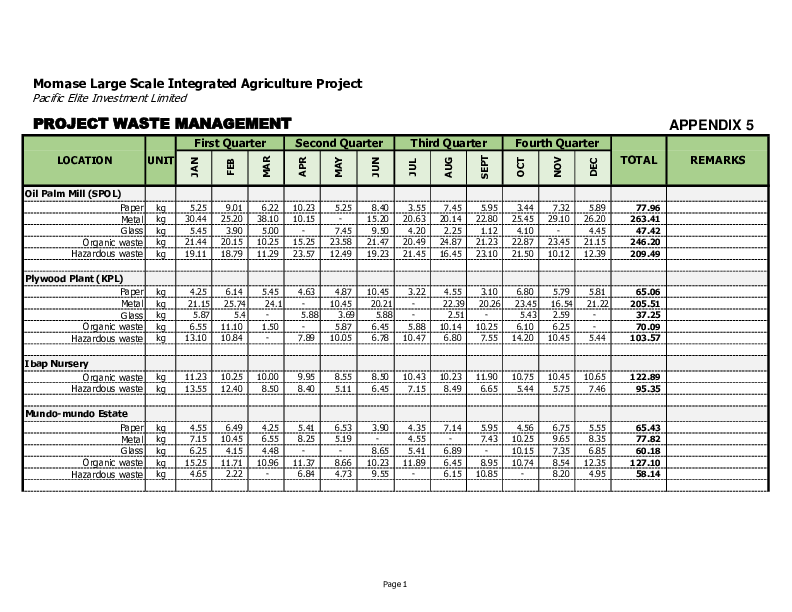
PROJECT WASTE MANAGEMENT APPENDIX 5
First Quarter Second Quarter Third Quarter Fourth Quarter
LOCATION UNIT TOTAL REMARKS
SEPT
MAR
MAY
NOV
AUG
APR
OCT
DEC
JUN
JAN
FEB
JUL
Turubu Township-Parua
Paper kg 6.54 5.41 5.25 4.10 5.80 4.30 2.25 3.85 4.10 3.55 3.80 4.25 53.20
Metal kg 10.45 6.80 7.25 5.20 5.68 - 9.15 5.90 2.95 - 4.85 5.44 63.67
Glass kg 4.80 5.50 4.86 - 7.10 3.25 4.50 6.15 3.57 5.88 3.19 4.20 53.00
Organic waste kg 5.55 3.41 7.45 5.44 - 3.25 6.89 8.45 4.25 7.20 5.45 6.80 64.14
Hazardous waste kg 8.99 6.48 6.50 4.80 8.10 4.98 8.78 4.85 6.80 8.55 5.10 4.75 78.68
Kenyare Compound
Paper kg 3.45 2.65 1.20 - 3.80 4.99 3.87 2.65 3.10 5.75 3.90 6.15 41.51
Metal kg 2.50 1.20 3.80 5.45 2.50 6.99 6.87 9.15 5.45 7.88 6.45 8.15 66.39
Glass kg 3.55 5.40 5.80 6.25 8.16 5.45 5.79 6.39 1.60 6.85 5.95 8.33 69.52
Organic waste kg 4.85 6.20 4.55 8.45 4.98 5.79 5.89 7.36 8.33 4.95 3.25 7.45 72.05
Page 2
�
Momase Large Scale Integrated Agriculture Project c APPENDIX 6
Pacific Elite Investment Limited
WATER QUALITY ANALYSIS RESULT
Parameter: E.COLI ANALYSIS (Microbiological)
First Quarter Second Quarter Third Quarter Fourth Quarter
MAX
SEPT
CODE LOCATION USES UWM CONTROL MEASURE
MAR
MAY
AUG
NOV
APR
DEC
OCT
JAN
JUN
FEB
JUL
LIMIT
q Improve Sanitation and Sewage
Sepik River Systems:
WSE-01 Industrial (cfu/100ml) 0 <1 <1 <1 0 0 <1 <1 2 0 TNTC <1 <1
Plywood Plant (KPL) Ensure proper maintenance and
functioning of sewage treatment plants to
prevent untreated sewage from entering
Pond water bodies.
WSE-03 Industrial (cfu/100ml) 0 2 <1 3 0 <1 0 LNS 0 TNTC <1 <1 <1
Turubu Township-Parua qAgricultural Best Practices:
Implement agricultural best management
practices (BMPs) to reduce the runoff of
Pond Domestic &
WSE-04 (cfu/100ml) 0 <1 1 0 <1 <1 0 LNS 0 <1 1 LNS LNS manure and agricultural chemicals into
Kenyare Compound Irrigation water sources.
qWatershed Management: Implement
Mawit Creek (Brinangat) Domestic & watershed management programs to
WSE-05 (cfu/100ml) 0 8 1 <1 <1 <1 0 0 1 0 0 LNS LNS control runoff and reduce erosion, which
Mawit Basecamp Workshop can carry E. coli from land into water
bodies.
Urr-u Creek (Pongi) Nursery qSeptic System Maintenance:
WSE-06 (cfu/100ml) 0 10 <1 <1 LNS 0 <1 5 0 <1 0 LNS LNS Regularly inspect and maintain septic
Ibap Nursery Irrigation
systems to prevent leaks or failures that
can contaminate groundwater and nearby
Pond water bodies.
WSWW Mill Effluent (cfu/100ml) 0 <1 0 1 0 <1 <1 TNTC 3 <1 5 1 <1
qWater Quality Monitoring:
Oil Palm Mill-SPOL
Regularly test water sources for E. coli
and other contaminants, especially in
Deep well areas at higher risk of contamination.
WSDU-01 Domestic (cfu/100ml) 0 3 <1 <1 0 0 1 0 0 3 TNTC 0 <1
Oil Palm Mill-SPOL qDisinfection Treatment: In cases
where E. coli levels are consistently high,
consider using disinfection methods such
Sepik River (Treated)
WSDU-02 Domestic (cfu/100ml) 0 <1 <1 0 <1 0 <1 0 0 0 3 0 <1 as chlorination, UV treatment, or ozone
KPL (Veneer/Plywood Mill) treatment to kill or inactivate the bacteria.
qFiltration:
Deep well Use appropriate filtration systems, such
WSDU-03 Domestic (cfu/100ml) 0 <1 0 0 <1 0 <1 1 0 0 0 0 <1 as sand or membrane filters, to remove E.
KPL (Veneer/Plywood Mill)
coli from drinking water sources.
qStormwater Management:
Deepwell & Rainwater esign and implement effective stormwater
WSDU-04 Domestic (cfu/100ml) 0 40 5 TNTC 0 0 0 <1 <1 0 <1 LNS LNS management systems to reduce runoff
Mundo-mundo Estate
and filter contaminants from stormwater
before it reaches water bodies.
Rainwater
WSDU-05 Domestic (cfu/100ml) 0 <1 <1 1 0 0 0 <1 <1 <1 1 0 <1
Turubu Township-Parua
Legend: Not Analysed NA Too numerous to count TNTC Location not sampled LNS
�
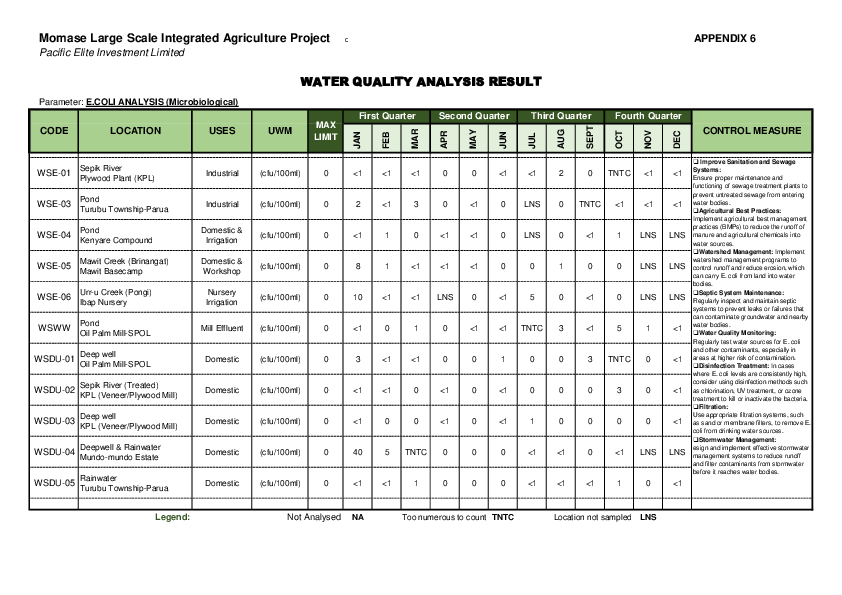
Momase Large Scale Integrated Agriculture Project APPENDIX 6
Pacific Elite Investment Limited
WATER QUALITY ANALYSIS RESULT
Parameter: TOTAL COLIFORM ANALYSIS (Microbiological)
First Quarter Second Quarter Third Quarter Fourth Quarter
MAX
SEPT
CODE LOCATION USES UWM CONTROL MEASURE
MAR
MAY
AUG
NOV
APR
DEC
OCT
JAN
JUN
FEB
JUL
LIMIT
q Regular Water Quality Testing:
Sepik River For domestic use (such as drinking and
WSE-01 Industrial (cfu/100ml) 3 1 <1 LNS 15 <1 LNS TNTC 20 15 0 0 TNTC cooking)- Conduct regular water quality
Plywood Plant (KPL)
testing to monitor the levels of total
coliform bacteria. Frequent testing helps
Pond detect contamination issues promptly
WSE-03 Industrial (cfu/100ml) 3 <1 5 <1 TNTC TNTC <1 0 LNS 0 10 1 0 qMaintain Proper Sanitary Practices:
Turubu Township-Parua
Ensure that sewage systems, septic tanks,
and wastewater treatment facilities are well-
Pond Domestic & maintained and functioning correctly. Leaks
WSE-04 (cfu/100ml) 3 3 10 18 <2 TNTC LNS <1 <1 0 5 LNS LNS or overflows from these systems can
Kenyare Compound Irrigation
introduce coliform bacteria into the
environment
Mawit Creek (Brinangat) Domestic & qChlorination or Disinfection: Use
WSE-05 (cfu/100ml) 3 <1 12 TNTC TNTC 10 1 <1 <1 15 LNS LNS LNS chlorine or other disinfection methods to
Mawit Basecamp Workshop
treat the water supply. This can effectively
kill coliform bacteria and other pathogens.
Urr-u Creek (Pongi) Nursery Proper dosage and contact time are crucial
WSE-06 (cfu/100ml) 3 TNTC 10 3 <2 1 0 15 5 0 <1 LNS LNS for effective disinfection.
Ibap Nursery Irrigation
qFiltration:
Implement filtration systems, such as sand
Pond or membrane filters, to remove particulate
WSWW Mill Effluent (cfu/100ml) 3 3 <1 TNTC TNTC <2 0 <1 1 10 TNTC 15 0 matter and bacteria from the water.
Oil Palm Mill-SPOL
qBoiling Water:
Boiling water for at least one minute can kill
Deep well coliform bacteria and make the water safe
WSDU-01 Domestic (cfu/100ml) 3 1 5 1 3 0 LNS TNTC <2 1 <1 <1 <1 for consumption during emergencies. This
Oil Palm Mill-SPOL
is a short-term solution.
qRegular Maintenance and Monitoring:
Sepik River (Treated) Continuously monitor and maintain water
WSDU-02 Domestic (cfu/100ml) 3 <1 <1 TNTC 3 1 10 TNTC 1 1 LNS <2 1 treatment and distribution systems to
KPL (Veneer/Plywood Mill)
ensure that they are operating correctly.
Regularly clean and disinfect storage tanks
Deep well and pipes.
WSDU-03 Domestic (cfu/100ml) 3 0 <2 LNS 0 3 LNS <1 0 3 1 10 LNS qCompliance with Regulations:
KPL (Veneer/Plywood Mill)
Ensure compliance with local, state, and
national regulations regarding water quality
Deepwell & Rainwater and treatment. These regulations often set
WSDU-04 Domestic (cfu/100ml) 3 <1 <1 LNS 10 15 TNTC 3 0 <1 <1 0 TNTC specific standards for coliform bacteria
Mundo-mundo Estate
levels in drinking water.
Rainwater
WSDU-05 Domestic (cfu/100ml) 3 0 1 10 5 3 LNS TNTC 0 <1 <1 LNS 25
Turubu Township-Parua
Legend: Not Analysed NA Too numerous to count TNTC Location not sampled LNS
�
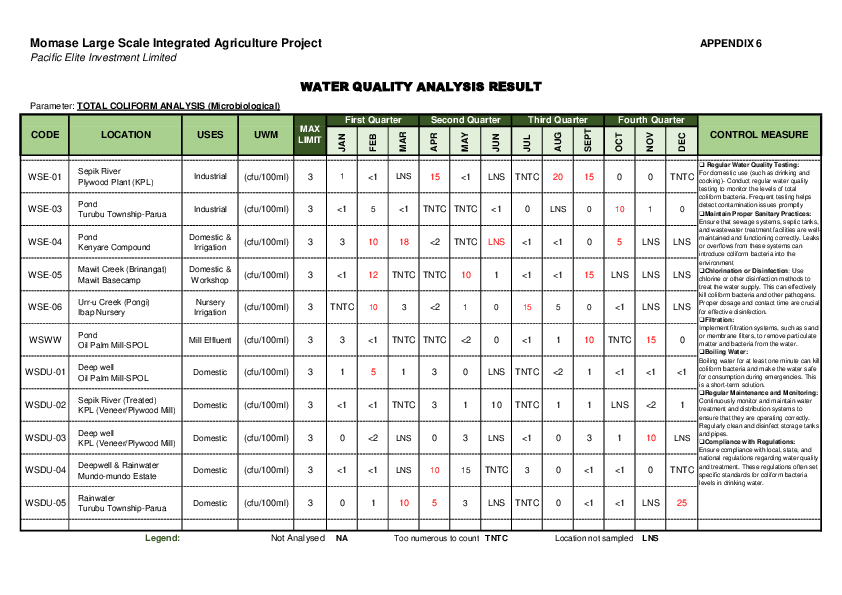
Momase Large Scale Integrated Agriculture Project APPENDIX 6
Pacific Elite Investment Limited
WATER QUALITY ANALYSIS RESULT
Parameter: TOTAL SUSPENDED SOLID (Physical)
First Quarter Second Quarter Third Quarter Fourth Quarter
MAX
CODE LOCATION USES UWM CONTROL MEASURE
SEPT
MAR
MAY
AUG
NOV
APR
OCT
DEC
JAN
FEB
JUN
LIMIT
JUL
Sepik River qErosion and Sediment Control:
WSE-01 Industrial mg/L 1500 102 50 100 110 20 150 100 145 180 LNS 150 159 Implement erosion control measures,
Plywood Plant (KPL)
such as erosion control blankets, silt
Urr-u Creek (Pongi) fences, and vegetative buffers, in
WSE-02 Industrial mg/L 1500 96 50 33 80 50 63 48 51 66 72 110 TNTC
Oil Palm Mill-SPOL construction sites, agricultural fields,
Pond Domestic & and areas prone to erosion.
WSE-03 mg/L 1500 35 44 50 LNS 30 25 LNS 30 75 61 70 TNTC qSediment Basins and Ponds:
Turubu Township-Parua Workshop Construct sediment basins or ponds
Pond Domestic & to trap sediment and allow it to settle
WSE-04 mg/L 1500 7 5 11 0 0 LNS 21 25 0 LNS 0 23 before water is discharged into natural
Kenyare Compound Irrigation
water bodies.
Mawit Creek (Brinangat) Domestic &
WSE-05 mg/L 1500 1 <1 0 0 1 0 <1 <1 0 0 LNS LNS qRiparian Buffers:
Mawit Basecamp Workshop Create and maintain riparian
Urr-u Creek (Pongi) (streamside) buffers with native
WSE-06 Nursery Irrigation mg/L 1500 49 30 25 15 22 50 LNS 45 31 LNS LNS LNS vegetation to filter runoff and reduce
Ibap Nursery
TSS before it enters water bodies.
Sepik River qConservation Tillage:
WSD-01 Industrial discharge mg/L 1500 29 10 12 LNS 0 18 33 <1 10 LNS TNTC 50
Plywood Plant (KPL) Adopt conservation tillage practices in
Urr-U Creek agriculture to minimize soil
WSD-02 Industrial discharge mg/L 1500 95 80 TNTC 50 48 34 30 47 30 51 LNS LNS disturbance and reduce soil erosion.
Oil Palm Mill-SPOL
qSoil Stabilization:
Nagam River Apply soil stabilizers like vegetation,
WSD-03 Industrial discharge mg/L 1500 42 82 94 TNTC 50 LNS 37 40 LNS 75 105 90
Oil Palm Mill-SPOL geotextiles, and mulch to prevent soil
Urr-u Creek Plantation erosion and sediment runoff.
WSD-04 mg/L 1500 46 38 10 54 0 <1 25 37 44 TNTC <1 <1 qSediment Control Regulations:
Ibap Nursery development
Enforce and strengthen regulations
Wangay Creek Plantation that limit TSS discharges from
WSD-05 Mundo-mundo junction Kambrendo
mg/L 1500 512 450 200 TNTC 108 330 150 95 TNTC 480 305 180
development industrial facilities and construction
sites.
Pond
WSWW Mill Effluent mg/L 1500 12 10 13 15 11 10 17 12 8 18 14 10 qWater Quality Monitoring:
Oil Palm Mill-SPOL Regularly monitor water quality to
Yemogu Creek Plantation assess TSS levels and identify areas
WSC-02 mg/L 1500 12 5 18 0 <1 <1 <1 10 21 11 5 LNS with elevated TSS concentrations.
(Morang Creek) development
Deep well
WSDU-01 Domestic Use mg/L 1500 3 0 <1 5 0 0 <1 <1 <1 <1 LNS LNS
Oil Palm Mill-SPOL
Sepik River (Treated)
WSDU-02 Domestic Use mg/L 1500 5 10 0 <1 <1 <1 17 22 6 12 20 11
KPL (Veneer/Plywood Mill)
Deep well
WSDU-03 Domestic Use mg/L 1500 9 4 <1 <1 0 5 16 20 27 0 10 14
KPL (Veneer/Plywood Mill)
Deepwell & Rainwater
WSDU-04 Domestic Use mg/L 1500 4 <1 <1 <1 8 TNTC 5 0 3 TNTC 0 LNS
Mundo-mundo Estate
Rainwater
WSDU-05 Domestic Use mg/L 1500 6 15 TNTC 21 <1 <1 TNTC 10 18 16 0 9
Turubu Township-Parua
Legend: Not Analysed NA Too numerous to count TNTC Location not sampled LNS
�
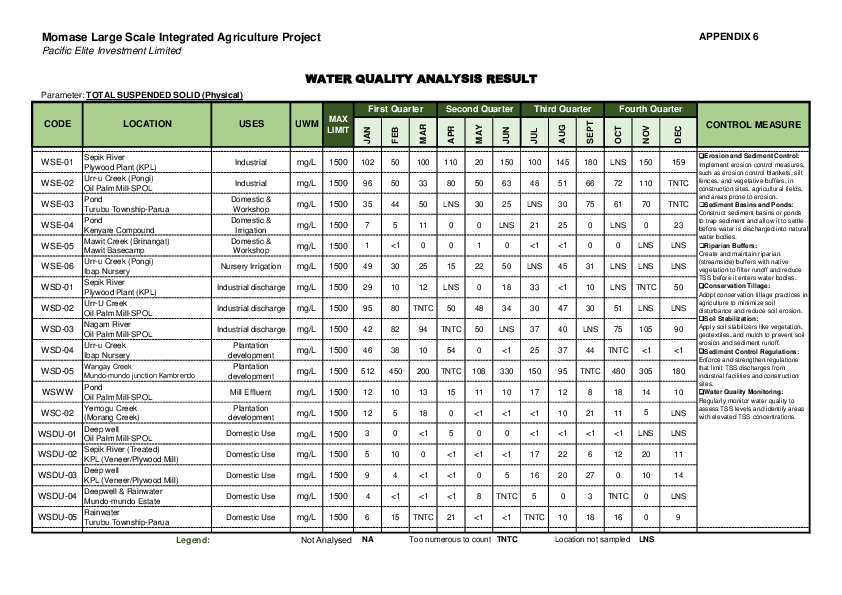
Momase Large Scale Integrated Agriculture Project APPENDIX 6
Pacific Elite Investment Limited
WATER QUALITY ANALYSIS RESULT
Parameter: POTENTIAL OF HYDROGEN (pH)
First Quarter Second Quarter Third Quarter Fourth Quarter
MAX
SEPT
CODE LOCATION USES UWM CONTROL MEASURE
MAR
MAY
AUG
NOV
APR
OCT
DEC
JAN
FEB
JUN
JUL
LIMIT
Sepik River qChemical Treatment:
WSE-01 Industrial pH 5-9 7.57 7.25 7.30 7.50 7.18 7.25 7.15 7.26 7.20 7.18 7.22 7.28 Acid Injection: Inject acids, such as sulfuric acid or
Plywood Plant (KPL) hydrochloric acid, into the water to lower pH. This
Urr-u Creek (Pongi) method is commonly used in industrial processes
WSE-02 Industrial pH 5-9 7.22 7.15 7.20 7.19 7.26 7.11 7.90 7.31 7.22 7.18 7.21 7.27 and municipal water treatment plants.
Oil Palm Mill-SPOL
qAeration:
Pond Domestic & Carbon Dioxide Aeration: Bubble carbon dioxide
WSE-03 pH 5-9 6.55 7.19 7.25 7.05 7.10 7.20 7.15 7.08 0.00 0.00 0.00 7.14 (CO2) gas through the water to increase carbonic
Turubu Township-Parua Workshop
acid content, which naturally lowers pH. This method
Pond Domestic & is suitable for smaller systems or natural water
WSE-04 pH 5-9 7.59 8.10 8.15 8.05 8.00 8.10 8.19 8.15 8.06 8.10 8.09 8.04 bodies.
Kenyare Compound Irrigation
qUse of pH Buffers:
Mawit Creek (Brinangat) Domestic & Add pH buffers or stabilizers to the water to resist
WSE-05 pH 5-9 7.53 7.80 7.25 7.54 7.46 7.87 7.25 7.05 7.40 7.55 7.60 7.89
Mawit Basecamp Workshop changes in pH. These buffers can help maintain pH
within a desired range.
Urr-u Creek (Pongi) qIon Exchange:
WSE-06 Nursery Irrigation pH 5-9 7.38 7.51 7.23 7.33 7.58 7.65 7.70 7.71 7.53 7.69 7.41 7.74
Ibap Nursery Implement ion exchange processes, such as using
zeolites or ion exchange resins, to remove alkaline
Sepik River
WSD-01 Industrial discharge pH 5-9 7.07 7.21 7.30 7.09 7.45 7.50 7.23 7.12 7.30 7.25 7.45 7.33 ions like bicarbonates and carbonates.
Plywood Plant (KPL) qDilution:
Urr-U Creek Mix the high-pH water with water of lower pH to
WSD-02 Industrial discharge pH 5-9 6.91 7.55 7.15 7.47 7.23 7.42 7.65 7.40 7.23 7.10 7.80 7.83 achieve the desired pH level. Dilution can be a
Oil Palm Mill-SPOL practical approach when the source water is naturally
Nagam River alkaline.
WSD-03 Industrial discharge pH 5-9 7.29 7.10 7.43 7.11 7.32 7.40 7.18 7.13 7.25 7.36 7.22 7.28 qVegetative Buffers:
Oil Palm Mill-SPOL
Plant vegetation along water bodies to absorb
Urr-u Creek Plantation excess nutrients and organic matter that may
WSD-04 pH 5-9 7.26 7.15 7.23 7.10 7.38 7.20 7.25 7.23 7.18 7.24 7.15 7.27 contribute to high pH levels.
Ibap Nursery development
qLiming:
Wangay Creek Plantation In some cases, applying agricultural lime (calcium
WSD-05 Mundo-mundo junction Kambrendo
pH 5-9 6.98 7.10 6.80 7.18 7.13 7.03 6.90 7.35 6.92 7.11 7.21 7.05
development carbonate) to acidic waters can help raise pH levels.
However, this is generally done to prevent water from
Yemogu Creek becoming too acidic.
WSC-02 Domestic Use pH 5-9 7.42 7.35 7.15 7.34 7.22 7.10 7.16 7.19 7.33 7.12 7.30 7.15
Water sample - control qAlkalinity Reduction:
Implement processes to reduce the water's alkalinity,
Pond which can help control high pH levels. This may
WSWW Mill Effluent pH 5-9 9.00 8.95 9.88 8.90 7.98 8.00 8.27 8.53 8.54 9.00 8.40 8.90
Oil Palm Mill-SPOL involve chemical addition or biological treatments.
qNatural Treatment Systems:
Deep well
WSDU-01 Domestic Use pH 5-9 6.82 6.45 7.10 6.22 6.31 6.58 6.46 6.84 6.75 6.60 6.71 6.82 Construct or restore wetlands and other natural
Oil Palm Mill-SPOL treatment systems that can help regulate pH levels
Sepik River (Treated) through biological processes.
WSDU-02 Domestic Use pH 5-9 7.66 7.51 7.44 7.28 7.57 7.38 7.25 7.65 7.51 7.62 7.30 7.45 qRegular Monitoring:
KPL (Veneer/Plywood Mill) Continuously monitor pH levels in water sources to
Deep well detect changes and implement corrective measures
WSDU-03 Domestic Use pH 5-9 7.60 7.54 7.47 7.30 7.61 8.00 7.65 7.77 7.61 7.43 7.53 7.61 promptly.
KPL (Veneer/Plywood Mill)
Deepwell & Rainwater
WSDU-04 Domestic Use pH 5-9 7.06 6.92 7.15 7.24 7.00 7.18 7.10 7.33 7.12 7.01 6.85 7.05
Mundo-mundo Estate
Rainwater
WSDU-05 Domestic Use pH 5-9 6.06 6.11 5.97 6.18 6.10 6.04 6.19 7.01 5.90 6.21 6.13 6.08
Turubu Township-Parua
Legend: Not Analysed NA Too numerous to count TNTC Location not sampled LNS
�
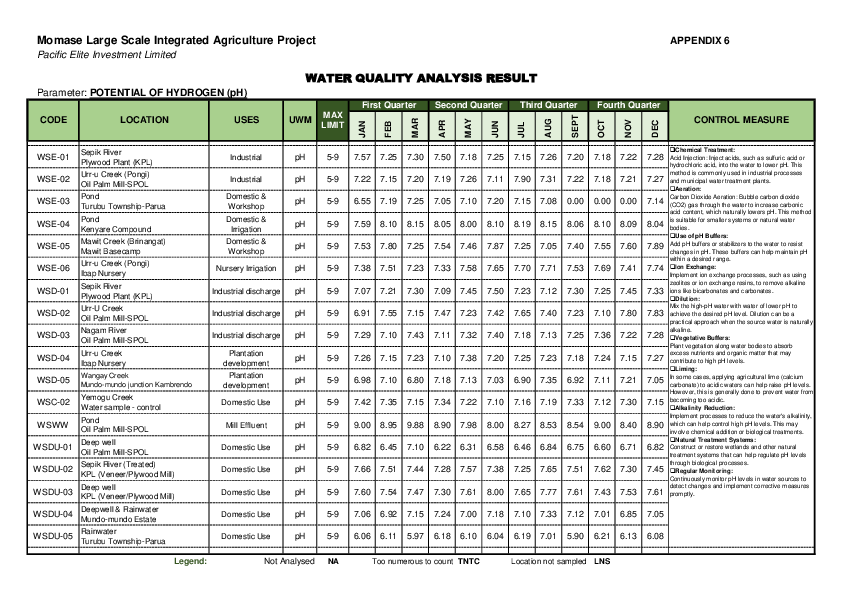
Momase Large Scale Integrated Agriculture Project APPENDIX 6
Pacific Elite Investment Limited
WATER QUALITY ANALYSIS RESULT
Parameter: COLOUR (Physical)
First Quarter Second Quarter Third Quarter Fourth Quarter
MAX CONTROL
CODE LOCATION USES UWM
SEPT
MAR
AUG
MAY
NOV
APR
DEC
OCT
JAN
JUN
FEB
JUL
LIMIT MEASURE
Sepik River Industrial/
WSE-01 Hazens 50 20 <30 15 LNS <10 >30 25 >30 >30 >30 LNS >30 Chemical & Filtration
Plywood Plant (KPL) Domestic
Urr-u Creek (Pongi)
WSE-02 Industrial Hazens 50 >30 <10 20 0 >30 25 20 0 20 >30 0 >30 Chemical & Filtration
Oil Palm Mill-SPOL
Pond Domestic & Settling, Chemical &
WSE-03 Hazens 50 >30 <20 0 0 10 15 15 <30 <30 <30 <30 0
Turubu Township-Parua Workshop Filtration
Pond Domestic &
WSE-04 Hazens 50 7.5 10 0 <30 20 <30 <30 <30 <30 LNS LNS LNS Settling using pond
Kenyare Compound Irrigation
Mawit Creek (Brinangat) Domestic &
WSE-05 Hazens 50 10 <20 <20 15 <30 <30 <30 0 20 LNS LNS LNS Settling using tanks
Mawit Basecamp Workshop
Urr-u Creek (Pongi)
WSE-06 Nursery Irrigation Hazens 50 25 0 30 <30 <30 <30 15 0 25 10 >32 <30 Settling using pond
Ibap Nursery
Sepik River Industrial
WSD-01 Hazens 50 10 0 LNS LNS LNS >30 >20 LNS LNS LNS >32 >30 Settling
Plywood Plant (KPL) discharge
Settling thru series of ponds
Urr-U Creek Industrial & facilitate evaporation. No
WSD-02 Hazens 50 >30 >30 >25 >31 LNS 30 >25 >28 LNS >28 >35 >30 direct discharge to water
Oil Palm Mill-SPOL discharge
ways.
Settling thru series of ponds
Nagam River Industrial & facilitate evaporation. No
WSD-03 Hazens 50 30 20 >33 >25 >25 25 >20 >20 0 >35 LNS LNS direct discharge to water
Oil Palm Mill-SPOL discharge
ways.
Urr-u Creek Plantation Mulching & terracing
WSD-04 Hazens 50 20 <25 <25 <15 10 30 20 <15 0 <30 30 <30
Ibap Nursery development application
Wangay Creek Plantation Mulching & terracing
WSD-05 Hazens 50 >30 20 0 >25 >33 LNS >20 >31 LNS LNS >30 >30
Mundo-mundo junction Kambrendo development application
Yemogu Creek
WSC-02 Domestic Use Hazens 50 >30 10 >33 30 <15 <15 25 10 30 <30 LNS LNS No need to apply
Water sample - control
Pond
WSWW Mill Effluent Hazens 50 >30 <30 25 15 <30 <30 <30 <30 20 30 <10 <10 Settling using pond
Oil Palm Mill-SPOL
Deep well
WSDU-01 Domestic Use Hazens 50 <2.5 <3.5 <2.5 <2.5 0 <2 <2 5 10 <15 10 0 No need to apply
Oil Palm Mill-SPOL
Sepik River (Treated)
WSDU-02 Domestic Use Hazens 50 <2.5 0 <5 <5 <3.5 5 <2.5 <2.5 <2.5 <2.5 <2.5 5> No need to apply
KPL (Veneer/Plywood Mill)
Deep well
WSDU-03 Domestic Use Hazens 50 <2.5 2 1 <2.5 0 <3 2.5 <2.5 2 0 1 <2.5 No need to apply
KPL (Veneer/Plywood Mill)
Deepwell & Rainwater
WSDU-04 Domestic Use Hazens 50 <2.5 2 <5 0 <2.5 <2.5 <2.5 0 1 2.5 LNS LNS Settling using tanks
Mundo-mundo Estate
Rainwater
WSDU-05 Domestic Use Hazens 50 <2.5 2.5 5 <2.5 <2.5 0 1 <2.5 <2.5 <2.5 <2.5 LNS Settling using tanks
Turubu Township-Parua
Legend: Not Analysed NA Too numerous to count TNTC Location not sampled LNS
�

Momase Large Scale Integrated Agriculture Project APPENDIX 6
Pacific Elite Investment Limited
WATER QUALITY ANALYSIS RESULT (Drinking water)
Parameter: MERCURY (Microbiological)
First Quarter Second Quarter Third Quarter Fourth Quarter
MAX
SEPT
CODE LOCATION USES UWM CONTROL MEASURE
MAR
MAY
AUG
NOV
APR
OCT
DEC
JAN
FEB
JUN
JUL
LIMIT
q Source Control: Preventing mercury from
entering water bodies in the first place is the
Pond most effective strategy. This involves
WSE-03 Industrial mg/L 0.0002 <0.001 0.001 <0.001 <0.001 <0.001 <0.001 0.001 <0.001 <0.001 <0.001 0.001 <0.001 regulations and practices to limit mercury
Turubu Township-Parua emissions from industrial processes, mining
operations, and other sources. Efforts may
include installing pollution control technologies,
implementing best management practices, and
enforcing environmental regulations.
Pond Domestic &
WSE-04 mg/L 0.0002 <0.001 0.001 <0.001 <0.001 <0.001 <0.001 0.001 0.001 <0.001 <0.001 0.0002 <0.001 q Wastewater Treatment: Treatment of
Kenyare Compound Irrigation industrial and municipal wastewater can remove
mercury before it is discharged into water
bodies. Various treatment methods such as
coagulation/flocculation, sedimentation,
filtration, activated carbon adsorption, and
Mawit Creek (Brinangat) Domestic & advanced oxidation processes can be used to
WSE-05 mg/L 0.0002 <0.001 <0.001 0.001 <0.001 <0.001 <0.001 0.001 0.001 <0.001 <0.001 0.001 <0.001 remove mercury from water effectively.
Mawit Basecamp Workshop
q Mercury Removal Technologies:
Advanced treatment technologies specifically
designed to remove mercury from water are
available. These include ion exchange,
Urr-u Creek (Pongi) Nursery membrane filtration, chemical precipitation, and
WSE-06 mg/L 0.0002 <0.001 <0.001 <0.001 <0.001 <0.001 <0.001 0.001 <0.001 0.0002 <0.001 0.001 <0.001 electrochemical methods. These technologies
Ibap Nursery Irrigation can be implemented in water treatment plants,
particularly in areas with significant mercury
contamination.
q Phytoremediation: Certain plants can
Deep well absorb and accumulate mercury from water and
WSDU-01 Domestic Use mg/L 0.0002 <0.001 0.001 <0.001 <0.001 0.001 <0.001 0.001 0.001 <0.001 <0.001 0.001 <0.001 soil. Phytoremediation involves using these
Oil Palm Mill-SPOL plants, such as water hyacinth and certain types
of algae, to naturally remove mercury from
contaminated water bodies.
q Sediment Remediation: Mercury tends to
Sepik River (Treated) accumulate in sediments over time, posing a
WSDU-02 Domestic Use mg/L 0.0002 <0.001 0.001 0.001 0.001 0.001 <0.001 0.001 <0.001 <0.001 <0.001 0.001 0.001 long-term risk to aquatic ecosystems.
KPL (Veneer/Plywood Mill)
Remediation techniques such as dredging,
capping, and in situ treatment can be employed
to reduce mercury levels in sediments and
minimize its release into the water column.
Deep well q Monitoring and Assessment: Monitoring
WSDU-03 Domestic Use mg/L 0.0002 <0.001 0.001 <0.001 0.001 <0.001 <0.001 <0.001 <0.001 <0.001 <0.001 0.001 0.001
KPL (Veneer/Plywood Mill) water bodies for mercury contamination is
essential for early detection and effective
management. Monitoring programs help identify
sources of mercury pollution, assess its impacts
on ecosystems and human health, and evaluate
Deepwell & Rainwater the effectiveness of control measures.
WSDU-04 Domestic Use mg/L 0.0002 <0.001 <0.001 0.001 0.001 <0.001 <0.001 <0.001 <0.001 <0.001 <0.001 0.001 0.001
Mundo-mundo Estate qPublic Education and Awareness:
Educating the public about the risks of mercury
contamination and promoting responsible
disposal of mercury-containing products (such
Rainwater as fluorescent bulbs, batteries, and
WSDU-05 Domestic Use mg/L 0.0002 <0.001 0.001 0.001 0.001 0.001 <0.001 0.001 0.0002 <0.001 <0.001 0.0002 0.001 thermometers) can help prevent mercury from
Turubu Township-Parua entering the environment and water bodies.
Legend: Not Analysed NA Too numerous to count TNTC Location not sampled LNS
�
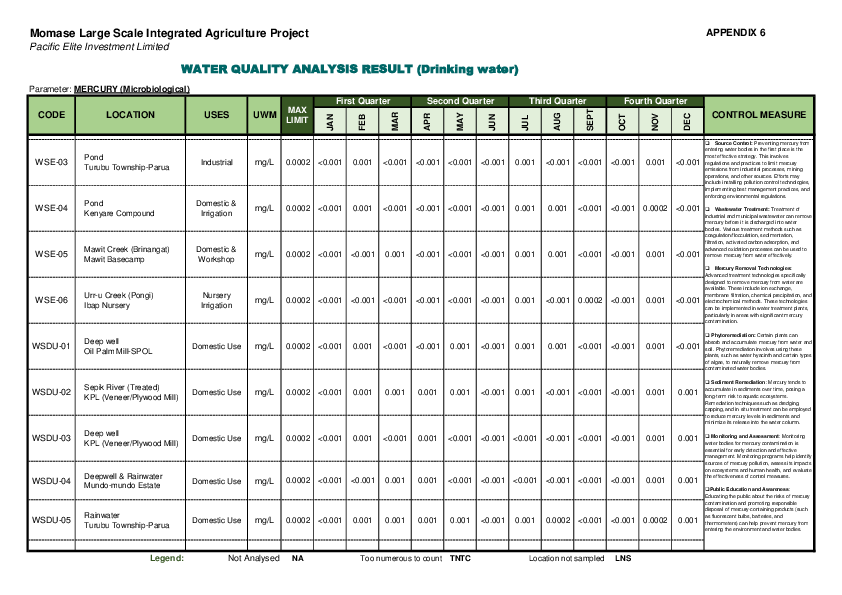
APPENDIX 7
WASTE MANAGEMENT PLAN DETAILS MATRIX
Identified Environmental
Waste Products/ Emissions Potential Sources Environmental Management Option
Issues
Air Related Issues Smoke emissions from equipment in site Heavy equipment, generator, & qUse of gas masks by equipment operators and workshop
clearing and earthworks, hauling of FFB, boiler for steam generation of the mechanics.
loading/unloading, boiler, & those under mill.
repair at the workshop and generator. qDispersion by installing building roof vents for exhaust gas
and other odorous smell to escape.
Emissions from accidental spillage Fuel tank & fuel depot qPrevention by good housekeeping and adequate spill control
and clean/disposal procedures.
Water Borne Pollutants Oily waste water Workshop/mill qInstallation of drainage system to direct wastes toward
interceptor traps and filters to separate oil from the water.
qUse absorbent materials (e.g. sawdust) to clean up
hydrocarbon spills.
Wash water Workshop/mill floors qConstruct water pond/basin for wash water or install
drainage system to conduct wastes toward designated
pond/basin more or less 50 meters away from any river.
Contaminated storm water with dirt, soil Workshop, fuel depot and lubricant qConstruct drainage system with solids trap made of wire
and others. storage. mesh/screen and separate suspended solids before directing
the same towards the vegetation.
Bilge water Ships/barges qCollect bilge water in empty containers and bury them in
secured waste pit away from watercourses.
Liquid Waste Issues Waste oil, fuel and other hydrocarbon Workshop qStore engine oil, gear oil and other related products in a
products secured bunded storage area particularly far away from any
watercourses.
qDispose of waste oil, fuel and other hydrocarbon products
into designated bunded waste pit far away from any
watercourses.
qNo disposal of waste fuel and oil into storm water drainage
and watercourses.
qAs much as possible, recycle waste oil and fuel.
qProvide safety-working paraphernalia to workers.
Page 1
�
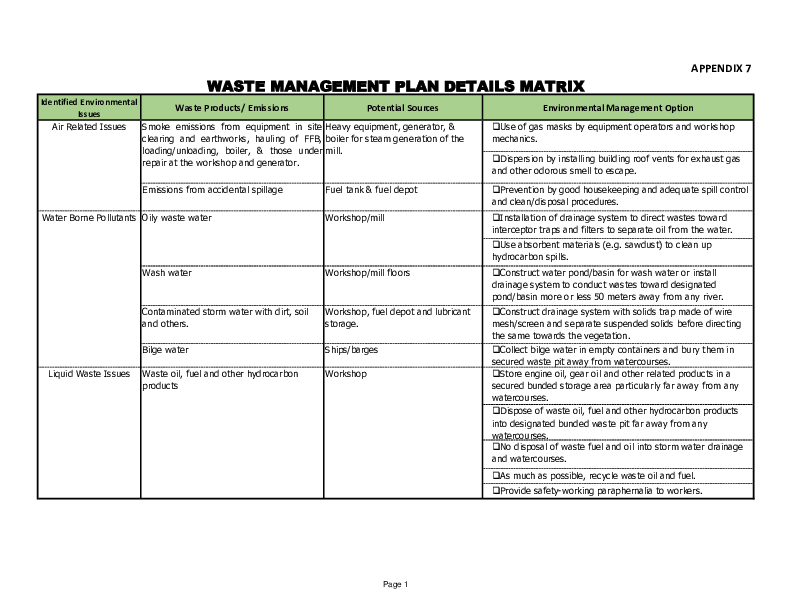
APPENDIX 7
WASTE MANAGEMENT PLAN DETAILS MATRIX
Identified Environmental
Waste Products/ Emissions Potential Sources Environmental Management Option
Issues
Air Related Issues Smoke emissions from equipment in site Palm
Effluent HeavyOilequipment,
Mill generator, & qDispose waste water on the properly built series of ponds
clearing and earthworks, hauling of FFB, boiler for steam generation of the (waste water treatment facility)
loading/unloading, boiler, & those under mill. qDaily inspections of the mill waste water collection chambers
repair at the workshop and generator. and conduits.
qSeriously follow the Protection Maintenance Schedule to
avoid uncontrollable leak.
Domestic wastewater Kitchen, toilets, offices and other qEmploy landfill disposal method – construct landfill or septic
support and related facilities. tanks where all domestic waste is drained.
Solid Waste Issues Vegetative debris such as fallen trees, and Palm Oil Mill Site ground preparation. qDispose of and burn them at the incineration site. Use the
other vegetation, broken limbs, barks and salvageable woody parts as firewood for cooking.
leaves.
Excess soil/overburden soil Palm Oil Mill Site ground preparation. qHaul the soil debris into the designated dumping area for
future use.
Timber off-cuts and scrap metals (G.I. Infrastructure construction site (mill qHaul and bury the waste products at the designated surface
sheets), nails, excess cement & others. & camp site ) dumping area.
Empty Fruit Bunch (EFB), pulp, sludge & Palm Oil Mill. qFeed to the boiler or as mulch on the plantation; or
shell qDispose of and burn them at the incineration site.
Domestic solid waste (empty cans and tins, Household, offices and other related qProvide rubbish bins as temporary waste containers and
food wrappers, and discards, and other facilities. properly dispose to designated landfill area. Collect
household wastes) salvageable materials for sale.
Ballast Jetty area qReuse as much as possible the same ballast for stabilizing
the ship/barge.
Broken mechanical parts, used tires, fan Workshop qDispose of into a designated surface dumping area with
belts, discarded batteries and junk metals. fence while waiting for recycling.
Contaminated absorbents and filtered
Workshop qBury at the surface dumping site.
waste
Page 2
�
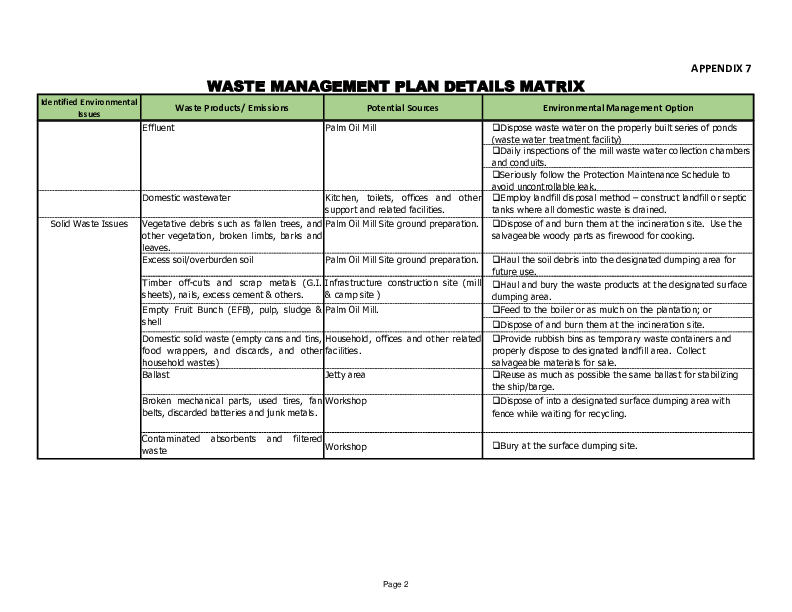
APPENDIX 7
WASTE MANAGEMENT PLAN DETAILS MATRIX
Identified Environmental
Waste Products/ Emissions Potential Sources Environmental Management Option
Issues
Air Related Issues Smoke drums
Empty emissions
and from
other equipment in site Fuel
fuel and lubricant Heavydepot
equipment, generator,
& lubricant & and
storage qPlace and arrange properly all empty drums in a designated
clearing and earthworks, hauling of FFB, workshop
containers. boiler for steam generation of the area for future use. Empty drums can be used as garbage
loading/unloading, boiler, & those under mill. bins or water container or temporary container for fuel and oil
repair at the workshop and generator. spillage.
Noise Pollution Noise Pollution Workshop, generators, heavy qLocate housing units/facilities far away from the workshop.
equipment, and sawmill & veneer
plants. qProvide safety earmuffs to workers during work.
Page 3
�
APPENDIX 8
NATURE OF SPECIFIC WASTE PRODUCTS MATRIX
Sources Biodegradable Non-biodegradable Toxic
Housing Units, Offices and Other Related Support Facilities:
Litter of metal scrap (G.I. Sheets), nails,
Construction Timber Off-cuts excess cement, etc.
Operation Solid household and domestic wastes Solid household and office wastes such as
such as carton packs, food discards, and soft drink cans, empty bottles, plastic,
paper. cellophane containers and others.
Sludge (human wastes such as feces and
excreta from the toilets), domestic
wastewater from kitchen, bath and
laundry room and toilets.
Uncontaminated storm water
Jetty Uncontaminated storm water Ballast and Bilge Water
Junk machinery & parts, scrap metal, Contaminated storm water, used fuel &
Motor Workshop/Generator House Uncontaminated storm water cable wires, tires & others oil, fuel & oil spillage, and discarded
batteries.
Empty drums and other fuel and lubricant Fuel & oil spillage, and Contaminated
Fuel Depot/Lubricant Storage
container. storm water
Palm Oil Mill:
Vegetative debris such as fallen trees and Scrap metals and plastics Fuel and oil spillage
Site Preparation & Construction other vegetation, broken limbs, barks &
leaves.
Excess soil
Operation Empty Fruit Bunch (EFB), pulp, sludge &
Scrap metals and plastics Fuel and Oil spillage
shell.
Contaminated water during washing of
Uncontaminated storm water
mill flooring.
�
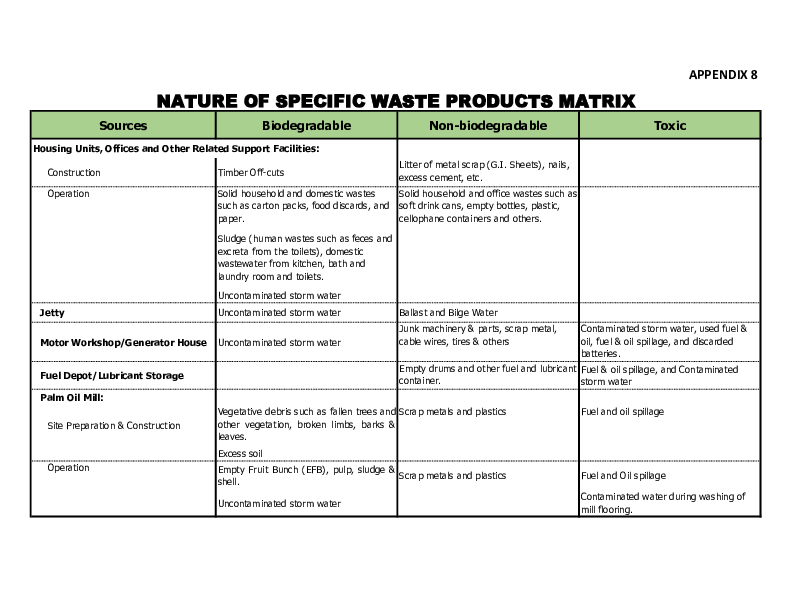
APPENDIX 9
WASTE MANAGEMENT PROGRAM
Sources and Collection and
Waste Control, Containment and Waste Storage and Treatment Waste Handling and Responsible
Specific Waste Products Final Waste Disposal Method disposal Frequency
Types of Waste Minimization Method Transportation Personnel
1. HOUSING AND OTHER SUPPORT FACILITIES
Construction:
a. Biodegradable
Solid Waste Timber off-cuts Haul the timber off-cuts to the designated Stockpile timber off-cuts in the Transport all collected timber off-cuts Burn all timber of-cuts at the Daily Head Carpenter/ Camp
incineration site for burning. temporary area away from the nearby using dump trucks and bucket loader to incineration site. & Mill Managers
river before hauling to the incineration the incineration site.
site.
b. Non-biodegradable
Solid Waste Scrap metals (G.I. Sheets, Strictly enforce no littering of any forms of Place waste in a temporary dumping Haul all wastes to the designated Dump all wastes into a designated Daily Head Carpenter/ Camp
etc.), nails, excess cement and scrap metals, plastics and other wastes. area which cannot obstruct the dumping site using bucket loader and dumping site at least 100m away from and Mill Managers
others. Find an area for temporary storage and movement of workers and machine. dump truck. any watercourse and at least 1m above
ensure to arrange properly. maximum level of ground water table.
Operation:
a. Biodegradable
Solid Waste Carton packs, newspaper, Separate all combustible wastes from the Place all wastes in the garbage bins and Transport all wastes to the incineration Burn all combustible wastes, and Once a week – every Environmental
scratch papers, empty non-combustible wastes and place them in cover securely. Be sure to dispose them and surface dumping sites using dump dispose of other wastes particularly Saturday except the food Specialist/Camp & Mill
detergent packs and food the provided bins as temporary storage within 12 hours. truck together with the bins. food discards into the landfill site and discards which will be Manager
discards. before hauling and disposing of into the cover with soil (at least 20cm. thick). dispose within 12 hours.
designated disposal sites. Strict After burning, bury the ash in the waste
enforcement of no littering of rubbish. pits.
Place food discards in a secured and close
container so as to keep away from the
dogs, rats and other scavengers. Dispose
of them within 12 hours to avoid malodor
in the kitchen.
b. Non-biodegradable
Solid Waste Soft drink empty cans, empty Separate the combustible wastes from non- Place all waste in the temporary bins and Haul all waste to the designated surface Dump into the designated surface Once a week – every Environmental
bottles, plastic containers and combustible materials and place in a cover them to keep away from dumping site together with the rubbish dumping site. Saturday Specialist/Camp
others. temporary container before final disposal mosquitoes, flies and other disease bins using truck or loader. Manager
to the designated disposal sites away from vectors.
any watercourses.
2. JETTY AREA
a. Biodegradable
Liquid Waste Uncontaminated storm water Install good drainage within the perimeter Discharge through the drainage system Discharge through the drainage system Discharge to adequately vegetated NA Camp & Mill Managers
of the jetty area. directed towards the vegetation so as to directed towards the vegetation so as to areas.
reduce siltation and sedimentation effect reduce siltation and sedimentation
to the nearby watercourse. effect to the nearby watercourse.
b. Non-biodegradable
Solid Waste Ballast (mixture of coarse and While cleaning the ship, place the ballast Use the ballast again for stabilizing the NA NA As the need arises Ship Captain
fine aggregate as weight for in a designated area. Re-use as much as ship.
stabilizing ship) possible the same ballast as weight for
stabilizing ship.
Page 1
�

APPENDIX 9
WASTE MANAGEMENT PROGRAM
Sources and Collection and
Waste Control, Containment and Waste Storage and Treatment Waste Handling and Responsible
Specific Waste Products Final Waste Disposal Method disposal Frequency
Types of Waste Minimization Method Transportation Personnel
c. Toxic
Liquid Waste Bilge water (contaminated Collect the bilge water in empty containers Put the contaminated water into the Haul the waste using the dump truck Dump into the designated pit. As the need arises Ship Captain
water with fuel and oil) by pumping and dispose of in a designated empty drum while waiting for disposal to and loader.
pit far away from any watercourses. the designated pit.
3. MOTOR WORKSHOP/ GENERATOR HOUSE
a. Biodegradable
Liquid Waste
Uncontaminated storm water Install good drainage within the perimeter Direct storm water to the drainage Direct storm water to the drainage Direct storm water to the drainage Workshop Supervisor/
of the motor workshop/generator house system. system. system which flow towards the Camp & Mill Managers
directed away from the watercourse to adequately vegetated area.
minimize the siltation and sedimentation
effect to the river system.
b. Non-biodegradable
Solid Waste Junk machinery parts, scrap Strictly enforce no littering of any forms of Place waste in a temporary dumping Haul all wastes to the designated Dump all wastes into a designated Once a month – every Workshop Supervisor/
metals, cable wires, tires and scrap metals and other workshop wastes. area within the motor workshop, dumping site using loader and dump dumping site at least 100m away from Monday Camp & Mill Managers
tube. Find an area for temporary storage and preferably at the back. truck. any watercourse and at least 1m above
ensure to arrange properly. maximum level of ground water table.
c. Toxic
Liquid Waste Contaminated used water Provide drainage directed towards the Drain the contaminated storm water into Drain the contaminated storm water Store in the settling basin/water pond. Workshop Supervisor/
designated wastewater pond/settling the settling basin/water pond so as not through the drainage system to the Camp & Mill Managers
basin. to pollute the nearby rivers and other settling basin/ water pond.
water body.
Solid Waste Used fuel & oil and fuel & oil Provide separate container for used Place in the temporary storage or Transfer the container filled with oil/fuel Keep the collected fuel and oil spillage Once a month – every Workshop Supervisor/
spillage during repair. fuel/oil, and spillage of fuel and oil as containers. spillage using truck into the designated in the fuel and oil storage house for Saturday Camp & Mill Managers
temporary storage. Impose zero spillage store house. future use. While the used fuel will be
in the workshop. transported and disposed of into the
designated landfill site far away from
any watercourses or burned. Used oil
will be keep properly and recycle as
lubricant for chainsaw chains.
Discarded batteries Find an area at the back of the generator Place all discarded batteries in a Haul all discarded batteries using truck Dump all discarded batteries in a Once a month – every Workshop Supervisor/
house for a temporary storage area temporary dumping site with fence. into the designated dumping area. designated landfill and cover with soil Monday Camp & Mill Managers
(fenced) and dispose to the designated (at least 20cm thickness).
dumping area.
4. FUEL DEPOT & LUBRICANT
a. Non-Biodegradable
Solid Waste Empty drums and other fuel Place and arrange properly all empty Place wastes in a temporary Haul empty drums and other wastes Place and arrange all wastes in a Once a month Workshop Supervisor/
and lubricant containers drums in the designated area. Reuse the environmentally safe area. using truck to the designated dumping designated area which is restricted to Camp & Mill Managers
empty drums as garbage can, temporary area. any unauthorized person.
bins and etc.
Page 2
�
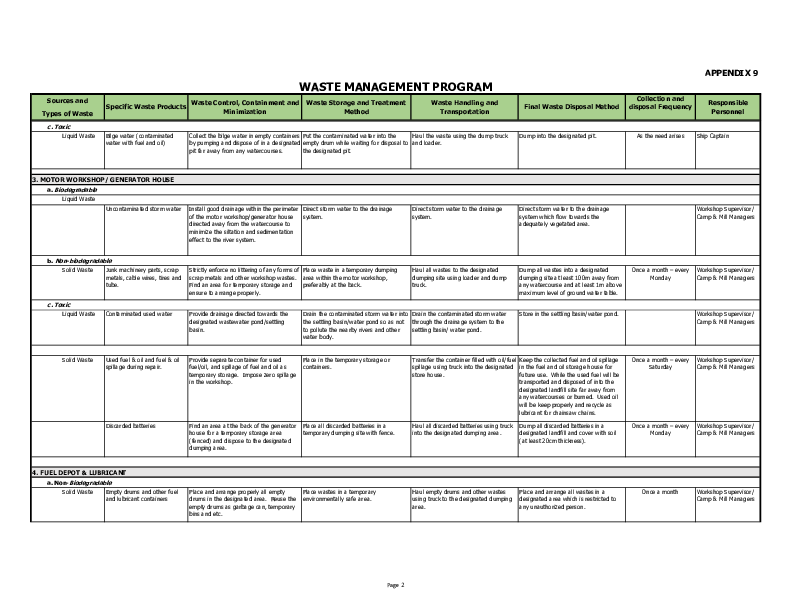
APPENDIX 9
WASTE MANAGEMENT PROGRAM
Sources and Collection and
Waste Control, Containment and Waste Storage and Treatment Waste Handling and Responsible
Specific Waste Products Final Waste Disposal Method disposal Frequency
Types of Waste Minimization Method Transportation Personnel
b. Toxic
Liquid Waste Fuel and oil spillage Construct a concrete bund where the fuel Collect and transfer the oil and fuel Transport the container with spillage in Keep the oil and fuel spillage in the Once a week – every Workshop Supervisor/
and oil depot is installed to contain cases spillage in a sealed container. a safe area preferably in the oil and fuel storage area for future use like for Friday Camp & Mill Managers
of fuel and oil spillage. Check periodically storage house with fence. cleaning machinery during repair.
any leaking of hose/pipeline of depot
including the pipeline from the pumping
station. Immediately repair and replace
damaged hose and pipeline. Take extra
care in refueling machinery. Provide bin
as a temporary container beneath the
refueling point of the depot.
5. PALM OIL MILL
Site Preparation:
a. Biodegradable
Solid Waste
Vegetative debris such as Trim the fallen trees and cut them into Stockpile the unusable parts of the fallen Transport all vegetative wastes to the Burn the vegetative debris at the Daily Plant Supervisors/Mill
fallen trees and other fuel wood sizes. Stockpile vegetative trees in a temporary area away from the incineration site using dump truck and incineration site. Let the workers get Manager
vegetation, broken limbs, debris in the environmentally safe area nearby river before hauling to the bucket loader. their fuelwood for their own use.
barks & leaves. while waiting hauling to the designated incineration site. Stockpile the fuelwood
surface dumping site. for future use.
Excess soil Haul the excess soil into the designated Stockpile the excess soil in a temporary Transport the excess soil to the Use the excess soil to fill up low-lying or Daily Plant Supervisors/Mill
dumping area. area before hauling to the designated designated dumping area using dump depressed areas within the logpond Manager
dumping area. truck and bucket loader area.
Scrap metal and plastic Prohibit littering of scrap metal, plastics Place all scrap metal, plastics and other Transport all the collected scrap, Disposed all solid wastes to the surface Daily Plant Supervisors/Mill
and other wastes around the industry solid waste in a temporary dumping plastics and other solid wastes using dumping site. Manager
compound. Collect and haul periodically area. dump trucks and bucket loader to the
all types of wastes and dump in the surface dumping site.
designated dumping site.
b. Toxic
Liquid Waste Fuel and oil spillage Check the possible leaking of fuel from Place fuel and oil spillage in a temporary Transport all collected fuel and oil Recycle the collected fuel spillage to As the need arises Plant Supervisors/Mill
any clearing or leveling machinery used in container. spillage using dump trucks and loader wash machinery parts and mechanics’ Manager
the site preparation and immediately fix to the temporary storage site. hands during repair and maintenance.
the leaking fuel tank. Provide ready Recycle collected oil spillage also to
temporary container in case of fuel and oil lubricate saw chain.
spillage.
Operation:
a. Biodegradable
Solid Waste Empty Fruit Bunch (EFB), pulp, Properly maintain conveyors and collection Place all solid wastes in a temporary Transport all solid wastes to the Burn all solid wastes at the incineration Daily Plant Supervisors/Mill
sludge & Shell. boxes and cart. Daily hauling of wastes to dumping area before hauling to the incineration site or boiler using dump site or feed to boiler. Some EFBs, pulps Manager
prevent over stocking. incineration site or feed to the boiler. truck and loader. & sludge will be recycle as mulch for the
plantation.
Page 3
�
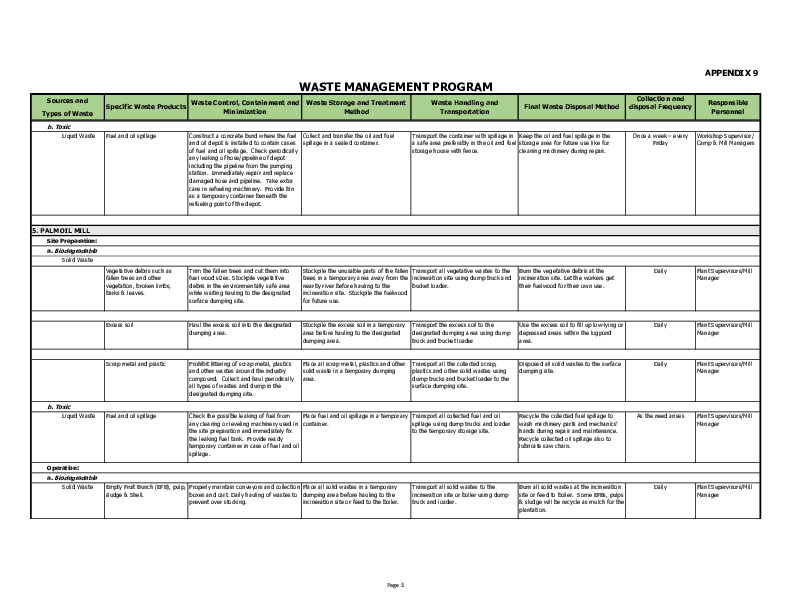
APPENDIX 9
WASTE MANAGEMENT PROGRAM
Sources and Collection and
Waste Control, Containment and Waste Storage and Treatment Waste Handling and Responsible
Specific Waste Products Final Waste Disposal Method disposal Frequency
Types of Waste Minimization Method Transportation Personnel
Liquid Waste Effluent Proper maintenance and inspection of EFB, pulps and sludge can be good Using appropriate conduits. Discharge to waterways. As the need arises Plant Supervisors/Mill
conduits from the effluent collection mulching materials for the plantation. Manager
chambers going to the cooling pond and
other ponds structures.
Uncontaminated storm water Construct proper drainage to avoid Directly channel to the constructed Direct storm water to the drainage Direct water to the drainage system As the need arises Plant Supervisors/Mill
flooding the mill flooring. wastes treatment ponds. system. towards adequately vegetated area. Manager
Direct storm water to the drainage
system.
b. Non-biodegradable
Solid Waste Scrap metal and plastic Prohibit littering of scrap metal, plastics Place all scrap metal, plastics and other Transport all the collected scrap, Disposed all solid wastes to the surface Once a week (every Plant Supervisors/Mill
and other wastes around the mill and solid waste in a temporary dumping plastics and other solid wastes using dumping site. Saturday) Manager
around the industry perimeter. Provide area. dump trucks and bucket loader to the
bin for temporary storage. surface dumping site.
c. Toxic
Liquid Waste Fuel and Oil spillage Check the possible leaking of fuel from Place fuel and oil spillage in a temporary Transport the container filled with Place in a designated area with fence. As the need arises Plant Supervisors/Mill
machinery used in the unloading of FFB & container. oil/fuel spills into a secured place Manager
loading of solid wastes, and then preferably with fence to avoid contact
immediately fix the leaking fuel tank. with men and animals.
Provide ready temporary container in case
of fuel and oil spillage.
Construct an oil-water separator system Collect the trapped fuel film and Burn them in the approved incineration As the need arises Plant Supervisors/Mill
and maintain regularly. transport them to the designated site. Manager
incineration site using dump truck and
loader.
Page 4
�
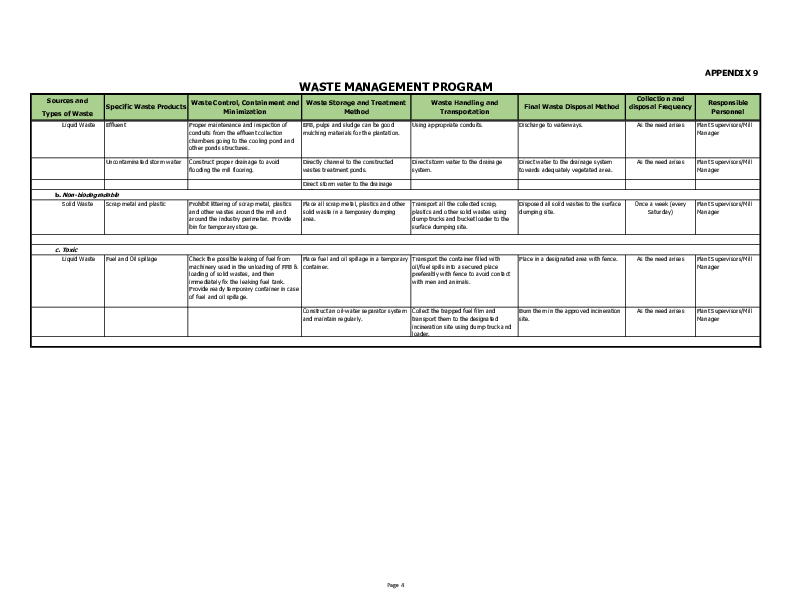
Performance status of each permit condition
The implementation and conformance status for each condition under the environment permit {EP-L3 (806)} with respect to the permit Holder is describe in
Table below.
No Permit Condition Implementation Status Compliance Status
General
1 The Permit Holder shall carry out works in accordance with the plans and specifications in the environment All activities and works are carried out as per
Compliant
permit applications for both the Oil Palm Development and Processing. Environmental Permit.
2 In the event of an inconsistency between the environment permit application and a condition of this permit, Environment permit application and a condition of this
the condition will apply. permit is acknowledged and observed Compliant
Biodiversity Off-Set
3 The Developer shall commit to develop and implement a biodiversity offsets program consistent with This will have to be developed with CEPA over time when
applicable the relevant regulations are ready for implementation. In
the meantime, land use changes within the project area,
Regulations which shall include:
since the start of the project, can be shown with time-
(a) A Biodiversity Offsets Plan; series satellite imagery.
Not applicable yet
(b) A robust scientific procedure for the measurement of the area of vegetation converted to a different
land use and the area of vegetation degraded on an annual basis;
(c) A commitment to protect an area of land and/ or water determined by the CEPA in accordance with
its National Protected Area Priorities and using fees generated under the Biodiversity Offsets Plan.
4 The Developer should be aware that any failure to meet any Conditions of this Permit or requirement of an This is noted.
Environment Management Plan will result in penalties imposed. Compliant
Spatial Data
5 The Permit Holder shall submit to DEC within three (3) months from the date of amendment of this permit A hardcopy of the requested spatial data/Map was
spatial data in digital form at 1:100,000 Map Scale which displays the boundary of the permit indicating attached in the submitted 2022 Annual Environmental
Momase Integrated Agro-Forestry Project Area, existing infrastructure and existing discharge and extraction Performance (AEP) Report.
points. A digital elevation model at 5m resolution and streamlines is also required. Compliant
6 The spatial data is required to be submitted in the following format(s): Software format: ArcGis or Mapinfo;
Datum WGS84; un-projected (Latitude/Longitude) format.
Biological Data
7 The Permit Holder shall conduct biological surveys on the aquatic and terrestrial flora and fauna species Already included in the submitted Environmental
within the premises based on the Permit Holder's Five (5) Year Forest Clearing Plans and submit Biological Management Plan.
Reports for each segment of the project area define by the Five (5) Year Forest Clearing Plan to the Director Compliant
for his approval prior to commencement of works within that segment.
Page 1
�
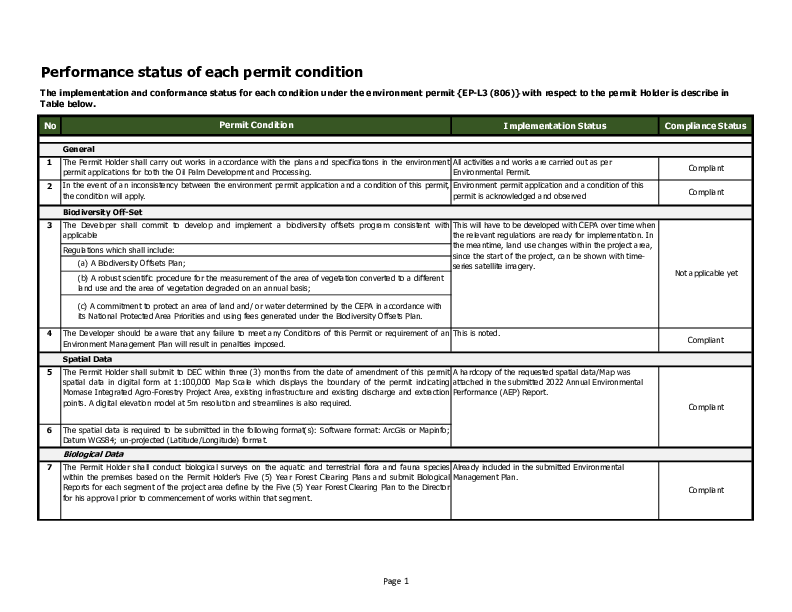
No Permit Condition Implementation Status Compliance Status
Works
Buffer Zone
8 The Permit Holder shall maintain buffer zones on each side of permanent or semi-permanent watercourses in Buffer zones have been provided and are being
accordance with the PNG Logging Code of Practice whilst carrying out works associated with the logging maintained along all watercourse within the project area Compliant
operation. as per the PNG Logging Code of Practice.
Prohibited Activities
9 The Permit Holder shall ensure no works is allowed within 100 meters of cultural sites (if any) as these sites This is noted and will taken
should be served as reserve sites for cultural purposes. Compliant
10 The Permit Holder shall ensure that no works are carried out within the buffer zone reserved along This is noted as per the PNG Logging Code of Practice
Compliant
watercourses.
Erosion Control
11 The Permit Holder shall design and apply appropriate measures to prevent soil erosion and minimize Erosion control measures include construction of 3.6m to
discharge of sediment into watercourses. The measures shall include but not limited to use of cutoff drains, 4.3m terraces with stop bunds at slopes > 12° and
velocity control techniques, sediment traps, ground cover (natural, e.g. grass growing and artificial, e.g. planting platforms at other locations in addition to
plastic sheets), sedimentation pond, limited vegetation clearing, etc. installation of flow retardation structure and planting of
Compliant
Mucuna bracteate leguminous groundcover. Removed
fronds were also stacked perpedicular to the ground
slope.
Bund
12 The Permit Holder shall construct bunds around the fuel storage tanks, workshops and sawmill plan within Fuel is stored in depot and/or gallons drums house in a
the premises using the appropriate bund specifications in the Australian Standards-AS 1940. bunded and sheltered shed (please see photo on page Compliant
25.
Waste Treatment Facilities
Septic Tank
13 The Permit Holder shall construct septic tanks with soak-away trenches for treatment and disposal of The septic tank system had been constructed and
domestic wastewater from Mawit and Mundomundo Base Camps. The septic tanks shall be established not properly installed (pls. see the attached map).
Compliant
less than 100m from any nearest surface water.
Landfill
14 The Permit Holder shall construct domestic and industrial landfills at Mawit and Mundomundo Base Camps Segregated and appropriately sign-posted landfills have
and any other locations within the premises for the disposal of domestic and industrial wastes, respectively. been constructed.
The landfills must be constructed not less than 100m from the nearest watercourse and designed to comply
Compliant
with the minimum environmental requirements in the DEC Environmental Code of Practice for Sanitary
Landfill Sites.
Page 2
�
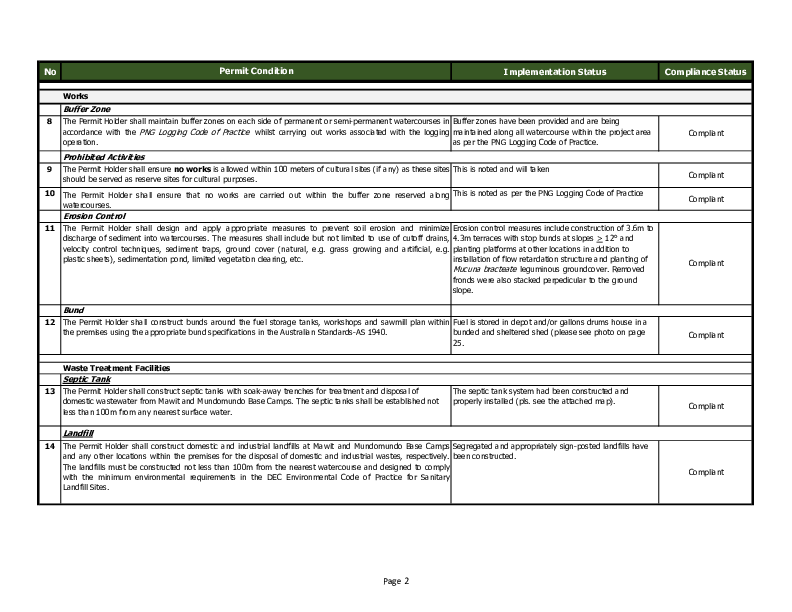
No Permit Condition Implementation Status Compliance Status
Cut-Off Drains
15 The cut-off drains around the fuel storage area,
The Permit Holder shall construct cut-off drains around the fuel storage area, workshop, and timber workshop, and sawmill plants have been constructed. Compliant
processing plants for diverting oil-contaminated wastewater.
Oil-water Separator
16 The Permit Holder shall install triple interceptor traps in the cut-off drains referred to in Condition 15, for An oil separator with triple interceptor traps has been
separation of oil-film from wastewater emanating from all workshops, fuel storage areas and timber installed.
processing plants established with the premises. The oil-water separator shall be designed to comply with
the minimum environmental specifications in the DEC Environmental Code of Practice for Vehicle/Machinery Compliant
Workshops and Petroleum (Hydrocarbons) Storage/Resale/Usage Site, DEC, 1997
Incinerator
17 All hazardous wastes such as biomedical waste and oily rags are to be disposed of safely and securely off the The incineration site will be constructed approximately
premises. If the offsite disposal is not reasonably practicable then the Permit Holder shall install an 100m or more away from the mill and quarters and must
appropriate incinerator for treatment before disposal into the environment. be very far from any villages. Included in the approved Compliant
EMP.
Mill Effluent Treatment Ponds
18 The Permit Holder shall construct a series of treatment ponds including aerobic and anaerobic ponds for The series of treatment ponds including aerobic and
treatment of the “palm oil mill effluent” from Palm Oil Mill prior to discharge to the environment. anaerobic ponds for treatment of the “palm oil mill
effluent” from Palm Oil Mill have been constructed,
19 The Permit Holder shall construct appropriate anaerobic and aerobic ponds for the treatment of POME prior Compliant
implemented and monitored (pls. see photos on page 15.
to discharge into the environment.
Operation
Logging/Log Salvaging Operations
20 The Permit Holder shall observe the relevant requirements in the PNG Logging Code of Practice whilst This is noted and properly obeserved
Compliant
carrying out logging operations within the premises.
Oil Palm Plantation
21 The Permit Holder shall ensure that fertilizers are only applied during dry season to prevent runoff and the This requirement has been incorporated into the
application should NOT be conducted under windy conditions or upwind from the buffer zones. company's standard operating procedure for fertilizer Compliant
application
22 The Permit Holder shall ensure that storage sheds for fertilizers and pesticides are built on a well-drained The storage facility is well ventilated and satisfactory
site, and with due regard to relevant environment, health and safety requirements (e.g., bund requirements, drained. Compliant
ventilation, etc.).
23 The Permit Holder shall ensure that pesticides and fertilizers are applied with due consideration of human Fertilizer and pesticides are applied well away from buffer
health and the environment and at a distance not less than 10 meters from the edge of the buffer zones. zone areas. Compliant
Page 3
�
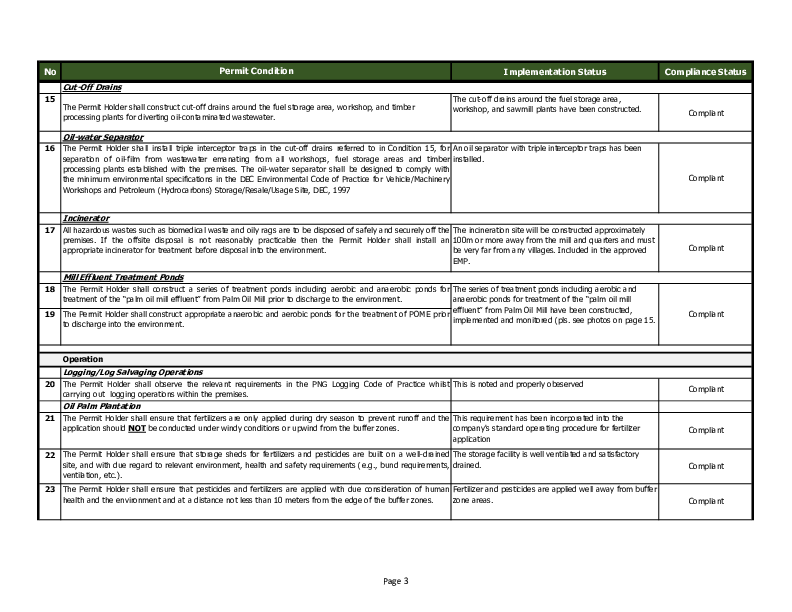
No Permit Condition Implementation Status Compliance Status
24 No empty pesticide and fertilizer containers or spray equipment shall be washed directly in watercourses or No agrichemical containers are washed in the local
in areas where chemical residues can enter watercourses through rainfall runoff. watercourse. Fertilizer bags are collected and used for Compliant
mulching and as waste bags.
25 Chemical substances including fertilizers should not be overstocked in order to avoid possible damage to Stock management of the current required chemicals and
stock and the resulting disposal issue including accidental discharge of chemical substances into the fertilizers is done according to demand and storage
environment through rainfall runoff. capacity to avoid over-stocking and accidental release
Compliant
into the environment. This approach was maintained
throughout the operation.
Palm Oil Processing
26 The Permit Holder shall observe the relevant requirements in the Environmental Code of Practice for Papua Oil Palm Mill was constructed and operated in accordance
New Guinea Oil Palm Processing Industry, DEC, 2013. with the Environmental Code of Practice for PNG Palm Oil Compliant
Processing Industry, DEC 2013.
27 The Permit Holder shall ensure that all the Empty Fruit Bunches (EFB) generated at the mill are pressed, Empty Fruit Bunches (EFB) generated at the Palm Oil mill
fiberised as fuel for renewal energy in the boiler. are pressed and fiberised as fuel for renewal energy in
the boiler and have been included in the design. Some Compliant
were used as mulching in the oil palm plantation.
Small-scale Timber Processing
28 The Permit Holder shall establish sawmill plants at a number of locations within the premises for the Sawmill Plant construction has been delayed. Currently, it
processing of the timber in small scale. is in its construction & equipment/ machineries Partially compliant.
procurement stage.
29 The Permit Holder shall ensure sawmill plant shall be established 100m away from the nearest water source The sawmill plant is now located more than 100m away
to avoid contamination of the water course. from the nearest water source (Sepik River). Compliant
30 The Permit Holder shall ensure that the operation of small-scale timber processing is done on a bunded This requirement has been included in the company's
concrete surface. construction design for small-scale timber processing. Not yet compliant.
Included in the design
Waste Treatment Facilities
31 The Permit Holder shall carry out routine inspection and maintenance of septic tanks (Condition 13 ), landfills All facilities are routinely inspected and maintained and
(Condition 14 ) cut-off drains (Condition 15 ), oil-water separators (Condition 16 ), incinerator (Condition 17 ), the same will be done to any new facility added to the
effluent treatment ponds (Condition 18 ), in order to maintain the treatment efficiency of these waste operation Compliant
treatment facilities.
Page 4
�
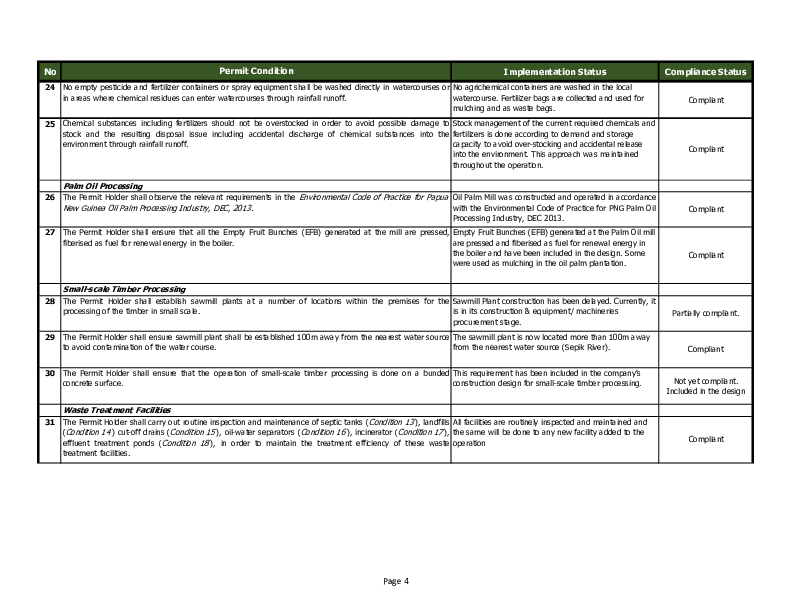
No Permit Condition Implementation Status Compliance Status
32 The Permit Holder shall ensure that leachates from domestic wastewater effluent should not flow out onto The soak away pits are installed at the maximum design
the land surface from the soak-away trenches after it is discharged from the septic tanks. volume so diffusion towards the land surface is unlikely. Compliant
Erosion Control
33 The Permit Holder shall take all reasonable measures, whilst undertaking the logging operation within the Sediment traps are used where appropriate to reduce the
premises to ensure that - entry of sediment into the watercourses and the natural
(a) soil erosion and discharge of sediment into any surface water is minimized, and direction and flow rate of water courses within the
premises has not been affected and re-directed to fully Compliant
(b) the natural direction of flow of surface waters within the premises is not altered, and
vegetated areas of the buffer zones.
(c) the flow rate of surface waters within the premises is not altered due to obstruction by logs or other
forest/log debris or wastes.
Rehabilitation
34 The Permit Holder shall undertake progressive landform rehabilitation during the logging operation, including Progressive site rehabilitation and revegetation work is
soil conservation and rehabilitation of disperse soil, stockpiles, quarry extraction sites, etc. being undertaken where required. Log landings are
cultivated to encourage the immediate growth of endemic
35 The Permit Holder shall undertake progressive re-vegetation work at construction sites including the camp Compliant
and pioneer tree species.
site, access road, quarry extraction sites, etc.
Storage of Hazardous Substances
36 All hazardous substances (chemicals, reagents, wood preservatives, etc.) that are used within the premises All hazardous substances (chemicals, reagents, wood
shall be safely stored in accordance with the manufacturer's recommendations. preservatives, etc.) are properly stored and safety
measures were fully observed as per manufacturer's Compliant
recommendations.
Workshop & Fuel Storage
37 The Permit Holder shall manage the workshop and fuel storage areas in accordance with the minimum Machinery workshops and fuel storage facilities within the
environmental requirements in the DEC Environmental Code of Practice for Vehicle/Machinery Workshops premises are being managed in accordance requirements
and Petroleum (Hydrocarbons) Storage/Resale/Usage Site, DEC, 1997. in the DEC Environmental Code of Practice for
Vehicle/Machinery Workshops and Petroleum Compliant
(Hydrocarbons) Storage/Resale/Usage Site, DEC, 1997.
Waste Management
Aerial Emission
38 The Permit Holder shall employ appropriate control measures to minimize air emissions from the premises Appropriate control measures are being used to minimize
(boiler stacks, steam from vents, diesel gen-set exhaust and fugitive emissions). aerial emmisions from the premises including (boiler
stacks, steam from vents, diesel gen-set exhaust and Compliant
39 The Permit holder shall employ appropriate control measures to minimize offensive odour within the
fugitive emissions).
premises.
Page 5
�
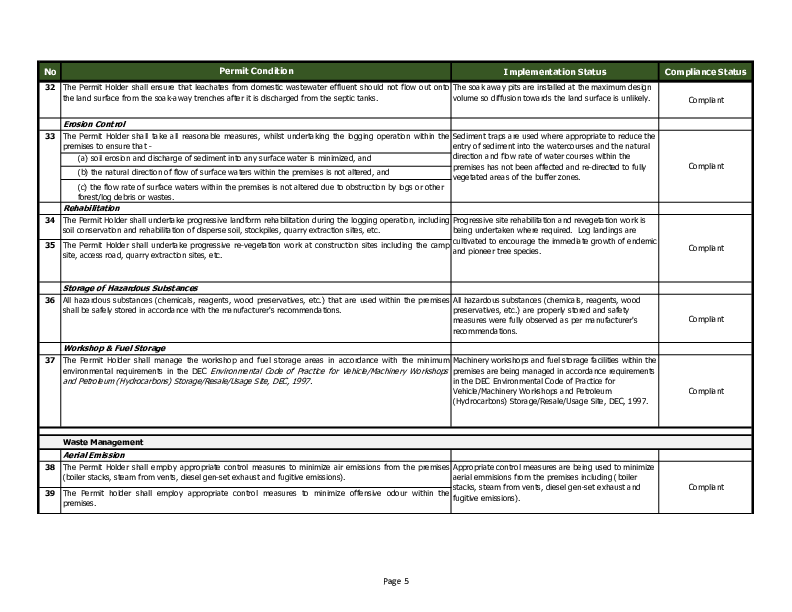
No Permit Condition Implementation Status Compliance Status
40 The Permit Holder shall minimize airborne emission of particulate matter (soot) and black smoke from the This aspect has been included in the design of the Oil
emission stack at the processing mills through the use of appropriate pollution control equipments to ensure palm mill which is yet to be established. Appropriate
that on a daily basis, emissions of black smoke from boiler stacks remain better than Ringelman 2 for periods smoke measuring device is on the process of Not yet applicable
exceeding 80 per cent of total boiler operating time. procurement.
Noise
41 The Permit Holder shall ensure that noise levels generated within the premises are minimized through the Noise abatement measures including construction of
use of appropriate noise control measures. sound barriers, scheduling of operating hours, and
attenuation of vehicle and equipment engines, have been
implemented. Applicable control measures during mill Compliant
construction were installed and observed during mill
operation.
Solid Waste
42 The Permit Holder shall dispose of all domestic and industrial solid wastes from the premises in the sanitary All appropriate solid waste management measures are in
place in accordance with approved EP. Compliant
landfills referred to in Condition 14.
43 The Permit Holder shall not place solid or liquid waste (excluding mill effluent discharged through land Oil Palm Mill solid waste management measure is
irrigation) in a manner where it could easily enter surface water through rainfall runoff. included in the planning and construction phase. Compliant
44 The Permit holder shall not place any solid or liquid waste in a manner where it could easily be dispersed to Solid or liquid waste mitigating measure is to be in place
other areas and cause contamination within and/or outside the premises through rainfall runoff. to avoid any contamination within and/or outside the
premises through rainfall runoff. Already stipulated in the Compliant
approved EMP.
45 The Permit Holder shall ensure that the Empty Fruit Bunches (EFB) generated at the mills are utilized as Included in the AEP Report.
Compliant
mulch / compost in the oil palm fields.
Solid Mill Waste (decanter cake)
46 The Permit Holder shall ensure that the solid mill wastes (decanter cake) is used as a form of fertilizer within To use solid mill wastes (decanter cake) as fertilizer, the
its oil palm plantations and not disposed of into the environment. management is in the planning stage. Not yet applicable
Rainfall Runoff
47 The Permit Holder shall ensure that storm water runoff from the locations near the Anaerobic (methane Boundary drains have been constructed along the
capture) and Aerobic ponds are not contaminated with POME. perimeter of the Aerobic pond area to prevent Compliant
contamination.
48 The Permit Holder shall segregate storm water runoff from the locations where machinery and fuel are Stormwater runoff from the workshop and fuel storage is
stored in order to avoid cross-contamination of the rainwater. directed through an oil-water separator. Compliant
Page 6
�
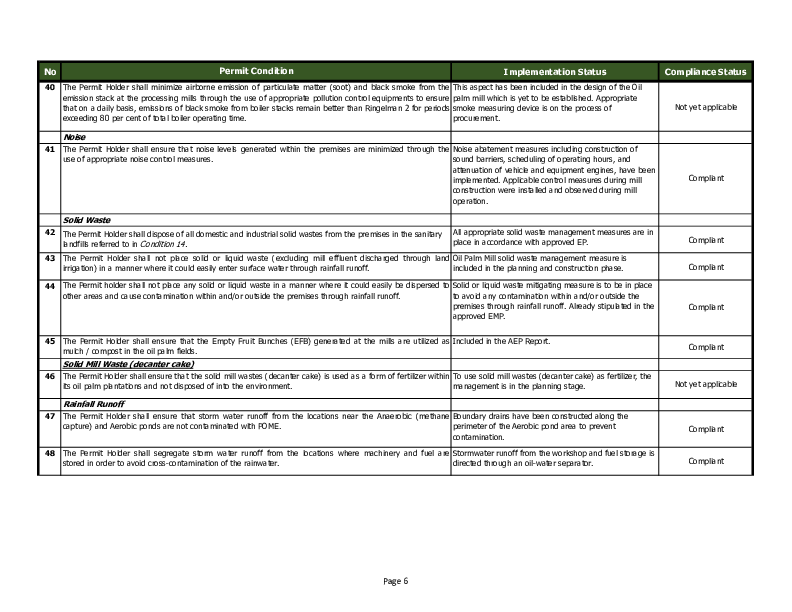
No Permit Condition Implementation Status Compliance Status
Waste Oil
49 The Permit Holder shall ensure that waste oil (fuel and lubricants) are reused and/or disposed of securely Waste oil (fuel and lubricants) disposal and reuse
and responsibly. included in the design. Compliant
50 The Permit Holder shall ensure that the floors at the workshop and sawmill are free of fuel residues and The floor at the workshop and fuel storage areas are
wood treatment chemicals prior to any floor-washing activity. cleaned prior to any floor washing activity. Compliant
51 All wastewater containing oil film (including contaminated rainfall runoff) shall be directed to oil-water All wastewater containing oil film (including contaminated
separators referred to in Condition 16 for removal of oil film prior to discharge. rainfall runoff) is directed to the oil-water separator for
removal of the oil-film prior to discharge. Compliant
52 The oil film from the oil-water separators must be skimmed off and stored in a used-oil container for reuse Oil film from the oil water separator is skimmed off and
and/or disposal in the industrial landfill or through incineration referred ta Condition 17 . stored in a used oil container for reuse. Compliant
Domestic Wastewater
53 All domestic wastewater from the Mawit and Mundomundo Base Camps shall be directed to the septic tanks All domestic wastewater from the premises is directed
referred to in Condifion 13 for treatment prior to discharge. into septic tanks and then to soak-away trenches Compliant
Waste Discharge
Domestic Wastewater
54 The discharge of treated domestic wastewater at Discharge Points (1), (3), (4) shall occur at the rates The domestic wastewater discharges from the estate,
specified in Table 1 below township, and base camps as all rainfall runoff is
captured by the perimeter drainage where wastewater
Table 1 - Permitted Discharge Rates for Treated Domestic Wastewater
discharge goes into small nearby water ways. Monthly
Discharge Rate monitoring is being conducted.
Discription Litres per Hours per Days per Month per Annual Discharge
hour day month Year Volume Compliant
3
Discharge Point (1) 303.01 24 30 12 2,618 m /yr.
Discharge Point (3) 33.23 24 30 12 287 m3/yr.
Discharge Point (4) 298.38 24 30 12 2,578 m3/yr.
Total Annual Discharge Volume 5,483 m3/yr.
Page 7
�
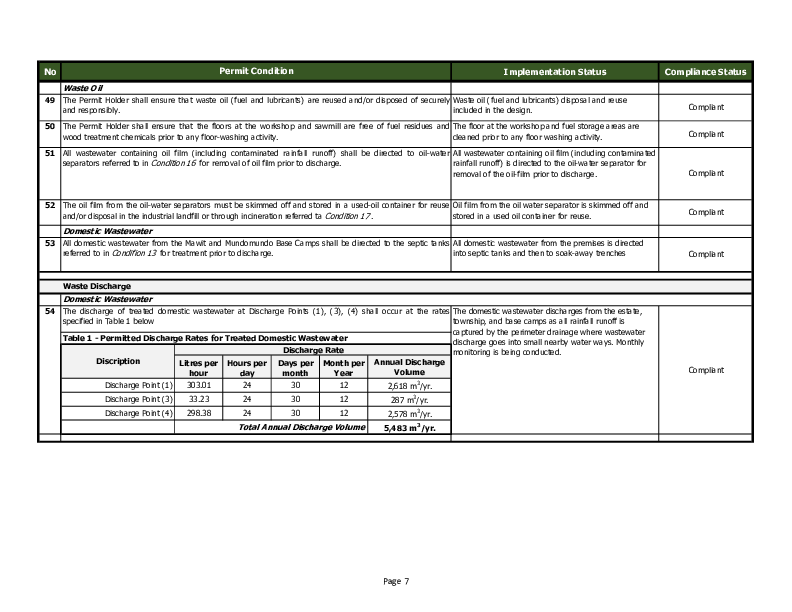
No Permit Condition Implementation Status Compliance Status
Industrial Wastewater
55 The discharge of treated industrial wastewater within the premises at Discharge Paints (2) and (5) shall There is no indication of treated industrial wastewater
occur at the rates specified in Table 2, below. contamination from the currently operating Mill and plant.
The POME is managed as per the Environmental Code of
Table 2 - Permitted Discharge Rates for Treated Industrial Wastewater
Practice for Papua New Guinea Palm Oil Processing
Discharge Rate Industry, DEC 2013.
Discription Litres per Hours per Days per Month per Annual Discharge
hour day month Year Volume Compliant
Discharge Point (2) 266.94 10 30 12 961 m3/yr.
Discharge Point (5) 166.94 10 30 12 601 m3/yr.
Discharge Point (5) 30,000 16 30 9 129,600 m3/yr.
Total Industrial (workshop wastewater)
1,562 m3/yr.
Discharge Volume
Total Industrial (POME) Discharge Volume 129,600 m3/yr.
56 The discharge of treated domestic and industrial wastewater at Discharge Points (1), (2), (3), (4) and (5) The discharge of treated domestic and industrial
shall not cause the water quality within Mawit Creek and Nagam River or any surface water within the wastewater have been monitored and included in the AEP
premises to exceed the water quality criteria in Table 3, below Report.
Table 2 - Fresh Water Quality Criteria
Parameters Water Quality Criteria Compliant
*Faecal Coliform ≤ 200 faecal coliform/100ml
Dissolve Oxygen > 6.0 mg/L (>80-90% saturation)
Total Suspended Solids < 10% change from background mean seasonal values
Oil & Grease None noticeable as visible film or detectable by odour
* Criteria based on not fewer less than five samples taken over not more than a 30 day period, in which the
median value of the faecal coliform bacteria content of the surface water shall not exceed 200 per 100 ml
Water Extraction
57 The Permit Holder shall ensure that extraction of water from Mawit and Urr-u Creeks do not exceed the base Included in the Annual Environmental Performance
flow of the surface water. Report.
58 The extraction of water at Extraction Points (1), (2) and (3) shall occur at the rates specified in Table 4,
below.
Table 4 - Permitted Water Extraction Rates from Mawit, Kimange (Uyenyomo) and Urr-u
Creeks
Extraction Rate
Compliant
Discription Litres per Hours per Days per Month per Annual Discharge
hour day month Year Volume
Extraction Point (1) 104.75 24 30 12 905 m3/yr.
Extraction Point (2) 83.33 24 30 12 720 m3/yr.
Extraction Point (3) 13,441 24 30 9 116,133 m3/yr.
Total Annual Extraction Volume 117,758 m3/yr.
Page 8
�
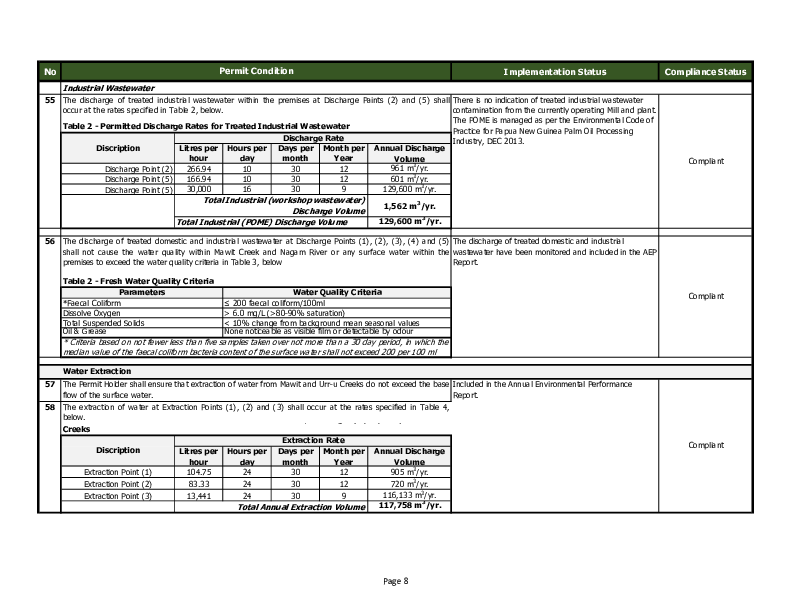
No Permit Condition Implementation Status Compliance Status
59 The Permit Holder shall ensure that the quality of the surface water complies with Public Health (Drinking) Included in the Annual Environmental Performance
Water Quality Standards in Table 5, if the water is used for domestic consumption. Report.
Table 5 - Water Quality Criteria for Non-disinfected Water Supplies
HIGHEST DESIRABLE
PARAMETERS MAXIMUM PERMISSIBLE LEVEL
LEVEL
Microbiological
E. Coli (per 100 ml) None
Total Coliform (per 100ml) <3*
Compliant
Physical
Color 5 50
Odor Unobjectionable Unobjectionable
Taste Unobjectionable Unobjectionable
Turbidity 5 Units 25 Units
Total Solids 500 mg/L 1,500 mg/L
NOTE * Less than three Coliform organism per 100 ml E. Coli is absent
Schedule 2, Public Health (Drinking Water) Regulation - Prepared for
SOURCE
inclusioin as at 1/1/1985
Environment Management Plan
60 The Permit Holder shall submit its Environment Management within three (3) months from the date of The Environment Management Plan will be updated if
amendment of this permit to the Director for Approval. The EMP should cover waste streams produced there are new facilities constructed and installed,
through this development of this project, waste management strategies, management and monitoring plantation improvement facilities, and additional
Compliant
programmes of all phases of development and all levels of impacts and their mitigation measures. management and monitoring programs being
implemented, respectively.
61 Monitoring activites were undertaken and results are
The Permit Holder shall undertake monitoring of the waste discharges during the logging/log salvaging presented in the Annual Environmental Performance
operation, oil palm development phase and palm oil processing phase. The monitoring shall cover all levels of Report. Compliant
impacts on environmental quality (water, air and land) including noise emission and the measures taken to
minimize the impacts.
62 The Permit Holder shall conduct its environmental monitoring programs in accordance with the approved These plans are components of the approved
EMP. The monitoring programs should also cover monitoring requirements under this permit. Environment Management Plan. Compliant
Page 9
�

No Permit Condition Implementation Status Compliance Status
Water Quality
63 The Permit Holder shall conduct monthly Water Quality Monitoring in relation to parameters specified in The monthly Water Quality Monitoring is being conducted
Table 3 and 5 and conduct an inspection to determine effects of wastewater discharge and the ecological and considered as stipulated the approved EMP and also
effects (if any) of the water extraction activity on Mawit Creek, Urr-u Creek, Kimange (Uyenyomo) and included in the AEP Report.
Nagam River and any other surface water that exist with the premises and report the results (including
records of volume of water extracted) in its Environmental Performance Report. The monitoring program
shall be carried out accordance with the requirements in Table 6 and with respect to the parameters in Table
3 and 5 above.
Table 6 - Fresh Water Quality Monitoring Program
Sampling Location Description Frequency Compliant
Domestic Wastewater
A Location 50m upstream of Control Site. Assess background water quality of
Discharge Points (1), (3), (4), Mawit Creek and Nagam River prior to contact with
domestic wastewater Monthly
(5) of (Mawit Creek, and
Nagam River)
A location 50m downstream of Sampling Site. Assess effects of domestic & industrial
Discharge Points (2), (4), (5), wastewater quality after discharge. Monthly
(6)
64 The Permit Holder shall carry out monthly monitoring on the flow rate of Mawit, Kimange (Uyenyomo) and Monthly monitoring is being conducted to ensure the
Urr-u Creeks to ensure that the water extraction rate does not reduce the volume of the surface water below water extraction rate does not reduce the volume of the
the “base flow”. An assessment of the ecological effects should be conducted where the flow rate of the surface water below the “base flow”, considering the
Compliant
surface water is 10% higher than the base flow. occurrence of a heavy longer rainy season in the area.
Reporting
65 The Permit Holder shall submit an Environmental Performance Report to the Director at the end of each Despite the delay in the construction of the sawmill plant,
calendar year. The report shall include but not limited to - Environmental Management and monitoring proceeded
across all other operational aspects in according with
(a) raw data (analysis by certified laboratories) from the effluent and water quality monitoring programs, permit conditions and the approved EMP.
Compliant
(b) interpretation of raw data,
(c) incidence of non-compliance and reasons, and
(d) status of compliance with the Waste Management Plan and other conditions of this permit.
Page 10
�

